It seems we can’t find what you’re looking for. Perhaps searching can help.


Category: ECOMMERCE MARKET
SECOMM provides the latest news on the ecommerce market, as well as the significant issues facing ecommerce businesses towards a comprehensive solution.




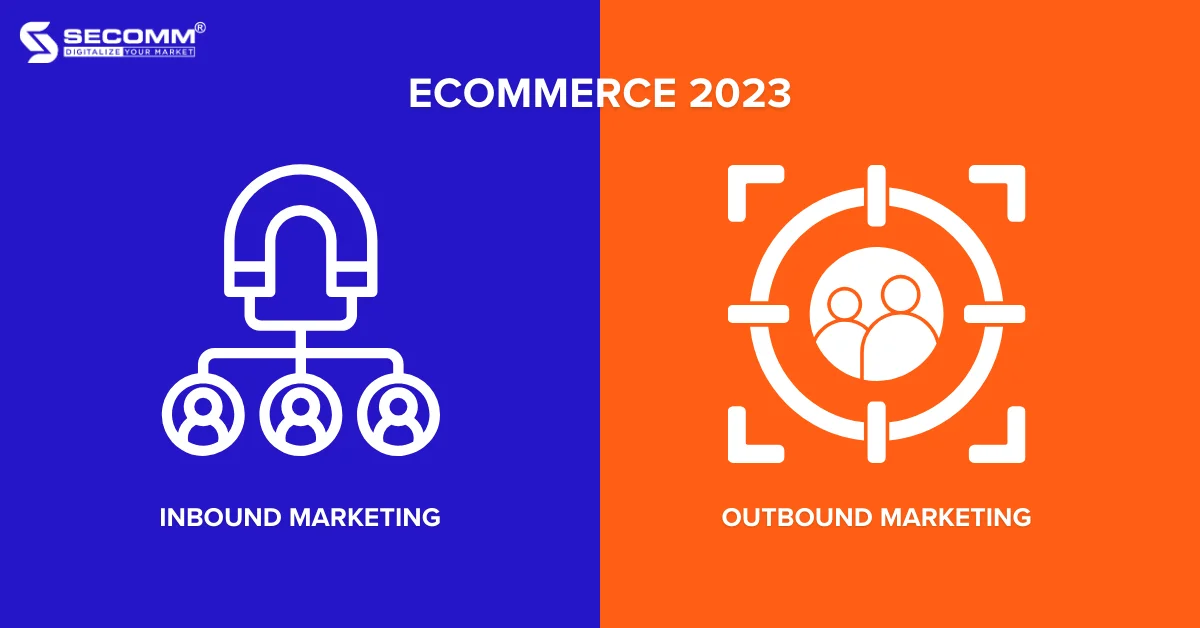
ECOMMERCE 2023: INBOUND MARKETING VS OUTBOUND MARKETING
Inbound Marketing and Outbound Marketing are two widely used marketing approaches that businesses often mix. Although they are common, many businesses still need to distinguish between these two types of marketing. Which is the most suitable strategy for businesses to implement Inbound Marketing and Outbound Marketing in the eCommerce world?
What is Inbound Marketing?
Inbound Marketing is a marketing approach that focuses on engaging customers by offering valuable content and delivering a meaningful customer experience.
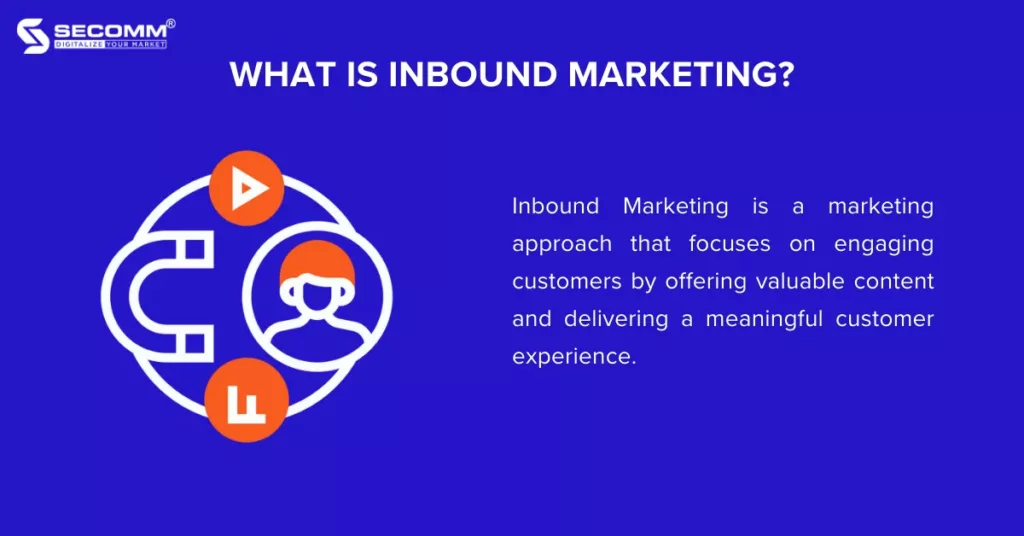
Key strategies employed in Inbound Marketing include:
- Blogging: Creating informative content to provide valuable insights to potential customers.
- Social Media Marketing: Using popular social media platforms like Facebook, TikTok, Instagram, Twitter, etc., for customer engagement through the sharing of valuable content.
- Search Engine Optimization (SEO): Optimizing websites and content to achieve higher rankings in search engine results, such as Google, Cốc Cốc, Safari, Firefox, and others, facilitating the discovery of the business by potential customers on the Internet.
- Email Marketing: Building email sequences tailored to customer needs and personalized to enhance customer care.
- YouTube Marketing: Developing marketing strategies on the YouTube platform to provide useful knowledge alongside marketing messages to specific potential customers.
- Audio Marketing (Podcast): Creating and broadcasting podcast programs related to the business or its products, allowing the brand to share information, stories, and other valuable content with potential customers through audio.
- Lead Generation: Offering valuable content like ebooks, guidelines, webinars, etc., to gather contact information and build a database of potential customers.
What is Outbound Marketing?
Outbound Marketing is a conventional marketing approach where businesses proactively reach out to customers by sending marketing messages to a broad targeted audience.
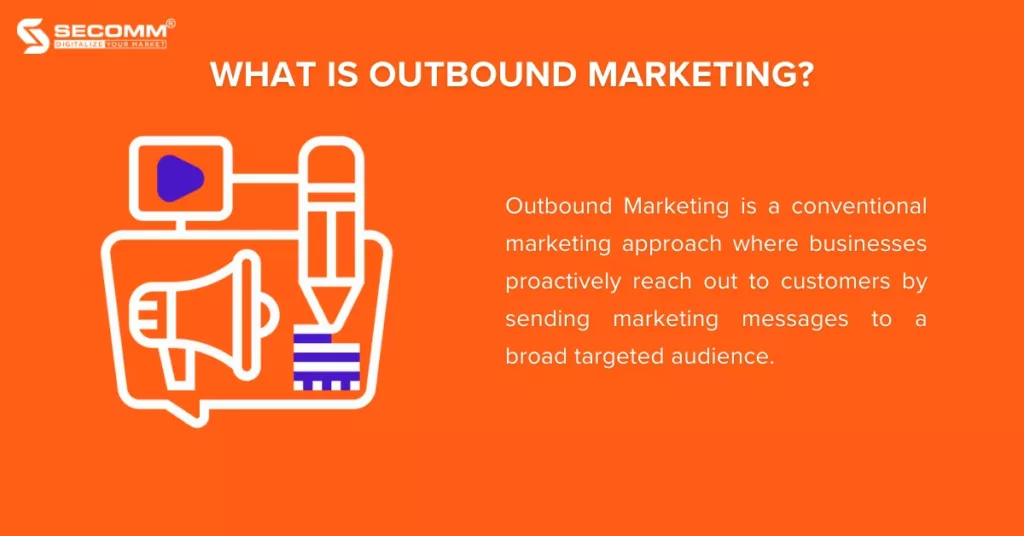
Here are some primary methods employed in Outbound Marketing:
- Cold calling: Making phone calls to various phone numbers collected from diverse sources, without any prior relationship, such as potential customer lists, or business databases, to introduce products/services.
- Cold email outreach: Sending direct mail or parcels to customer lists, much like cold calling, to announce products, services, or upcoming promotional programs.
- Events and exhibitions: Participating in and organizing events and exhibitions to have direct contact with potential customers and promote the business’s products/services.
- Traditional advertising: Using traditional advertising channels such as television, radio, print media, magazines, and outdoor advertising (billboards) to convey marketing messages to a large number of customers.
- PPC (Pay Per Click) advertising: Utilizing paid online advertising forms like Google Ads, social media advertising (Facebook Ads, Instagram Ads, TikTok Ads, etc.), or various display advertising techniques to reach a diverse consumer audience.
- Telemarketing: Making direct phone calls to potential customers to advertise products or services and generate sales.
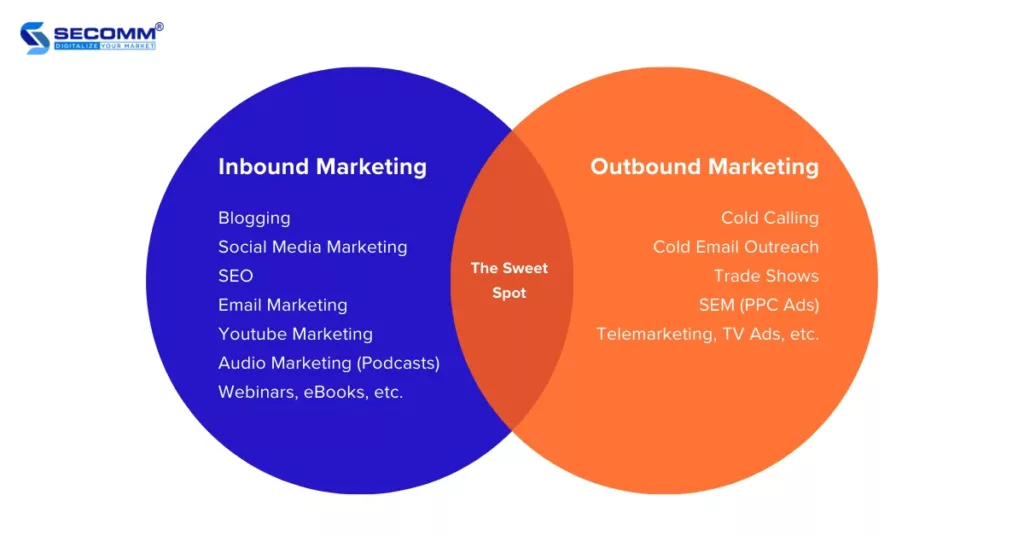
Inbound Marketing vs Outbound Marketing: Basic Comparison
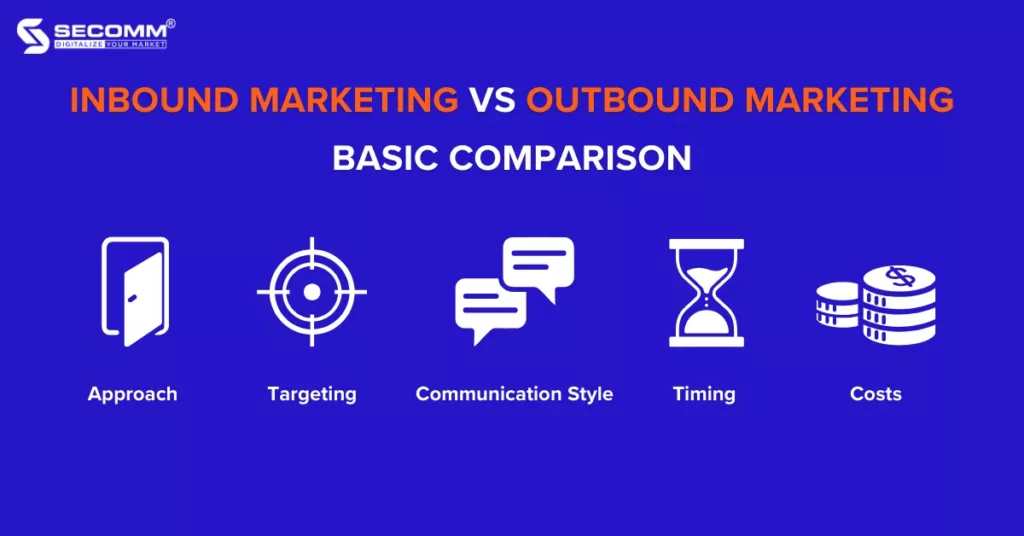
Approach
Inbound Marketing centers around the customer, prioritizing the attraction of potential customers through valuable content and experiences. In the realm of eCommerce, Inbound Marketing primarily revolves around establishing relationships and engaging with customers through the business’s website or eCommerce app.
Conversely, Outbound Marketing takes a product-centric approach, aiming to send marketing messages to a wider audience. Outbound Marketing involves reaching potential customers through diverse channels like advertising, direct mail, or telemarketing.
Targeting
Inbound Marketing focuses on attracting and connecting with specific, targeted audiences through the creation of relevant and valuable content. Its goal is to draw in potential customers actively seeking information or solutions related to the business’s products or services.
On the other hand, Outbound Marketing establishes a broader network and targets a wider audience, typically relying on demographics or general interests. The goal of Outbound Marketing is to reach a large number of people with the hope of grabbing the attention of potential customers.
Communication Style
Inbound Marketing promotes two-way communication, where businesses actively participate in conversations with potential customers, giving priority to listening, understanding customer needs, and offering valuable information or solutions.
Outbound Marketing typically involves one-way communication, with businesses delivering marketing messages to the audience without immediate interaction. The primary objective is to raise awareness and generate interest in the business’s products or services.
Timing
Inbound Marketing tends to have a long-term orientation as it revolves around building trust and credibility over time, nurturing potential customers until they are ready to make a purchase. However, it may require some time to see results.
On the other hand, Outbound Marketing is typically linked to immediate outcomes or short-term goals. Its primary focus is on generating potential customers or immediate sales by actively promoting products and services through channels such as paid advertising or telemarketing.
Costs
Inbound Marketing can offer long-term cost savings as this strategy relies on creating valuable content, optimizing online presence, and leveraging channels that the business controls, such as optimizing the eCommerce website/app, SEO, and managing social media pages. While it may require an initial investment of resources and time, the returns on this investment can be significant over time.
Conversely, Outbound Marketing often entails upfront expenses, such as advertising costs. The expenses can vary depending on the selected channels and the scale of the target audience.
Inbound Marketing vs Outbound Marketing: eCommerce Tactics
Inbound Marketing Tactics
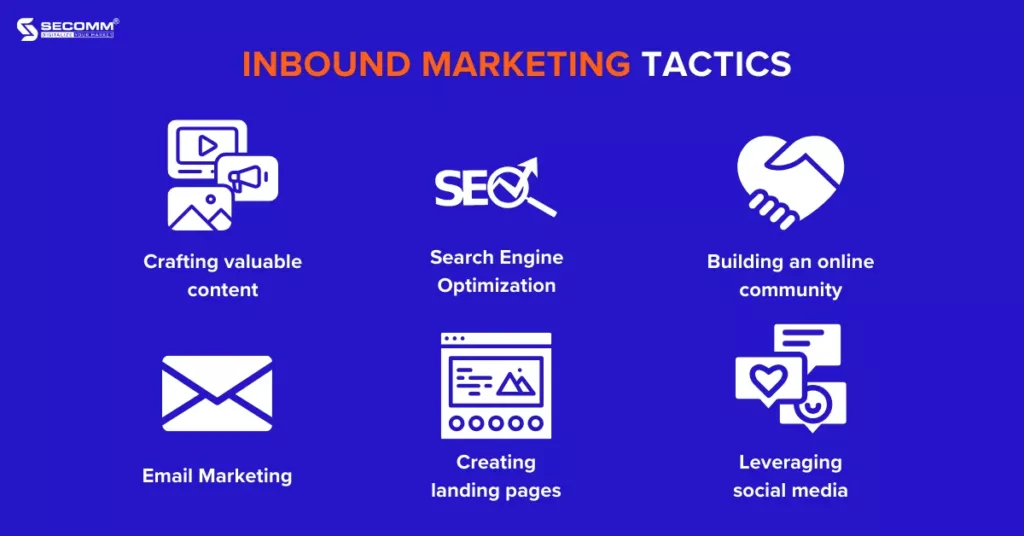
In the world of eCommerce, Inbound Marketing employs the principles and strategies of Inbound Marketing to attract and engage potential customers. Here are several common Inbound Marketing methods applied in eCommerce:
- Crafting valuable content: Generating useful content relevant to the business’s products or services, such as blogs, user guides, instructional videos, infographics, and other content formats.
- Search Engine Optimization (SEO): Optimizing the website and content to improve search engine rankings.
- Building an online community: Using social media, blogs, forums, or other platforms to interact with potential customers and foster an online community centered around the brand and its products.
- Email Marketing: Building an email list from potential customers and executing email marketing campaigns to deliver information, updates, promotions, and customer-specific content.
- Creating landing pages: Creating landing pages to establish a potential customer database and engage with them through marketing campaigns.
- Leveraging social media: Using social media platforms like Facebook, TikTok, Instagram, Twitter, and more to share content, interact with potential customers, and enhance brand recognition.
Outbound Marketing Tactics
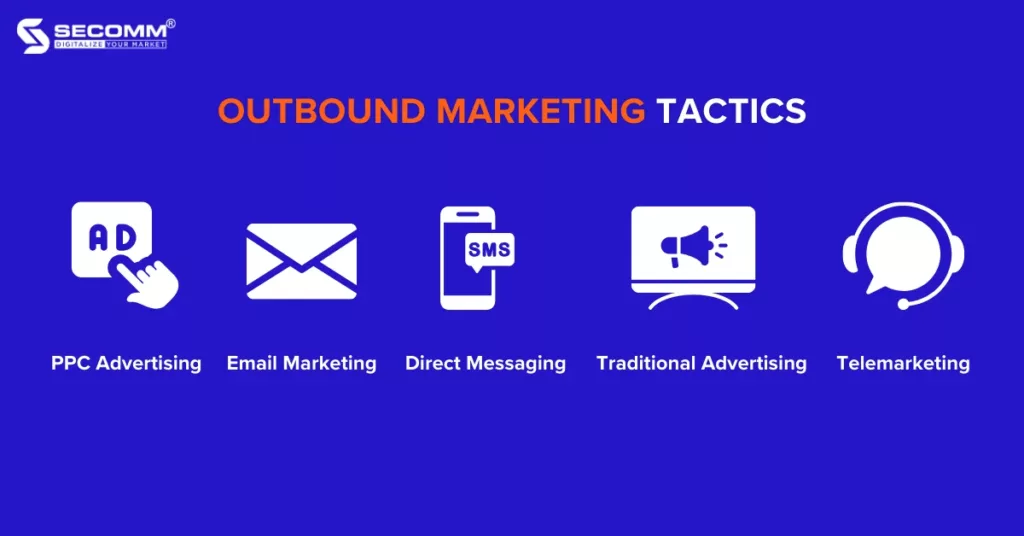
In the eCommerce world, Outbound Marketing employs the methods and strategies of Outbound Marketing to build brand recognition among a broad customer base with the objective of boosting online sales. Here are some common Outbound Marketing techniques typically utilized in eCommerce:
- PPC Advertising: Using paid online advertising channels such as Google Ads, Facebook Ads, or other online advertising formats to deliver marketing messages to potential customers.
- Email Marketing: Sending direct advertising emails to potential customers or existing customers to announce products, promotional programs, or relevant news.
- Direct Messaging (SMS Marketing): Sending direct messages to potential customers’ mobile phones to inform them about products, offers, or promotional programs.
- Traditional Advertising: Using traditional advertising forms like television, radio, print media, magazines, and billboards to drive a large customer base to the eCommerce website/app for purchasing.
- Telemarketing: Making direct phone calls to potential customers to introduce products or services, provide advice, or make sales.
In essence, Outbound Marketing in eCommerce can rapidly establish brand recognition and reach a large online audience, but it also necessitates consideration of effectiveness and the response of potential customers, with the ultimate goal of increasing online sales.
Here is a summary of the basic information about Inbound Marketing and Outbound Marketing in eCommerce. Depending on their individual needs, businesses will allocate time and budget for Inbound Marketing and Outbound Marketing accordingly.
Contact or call the SECOMM hotline at 02871089908 today for a free consultation on the implementation of eCommerce Marketing.
 2
2

 9,132
9,132

 0
0

 1
1
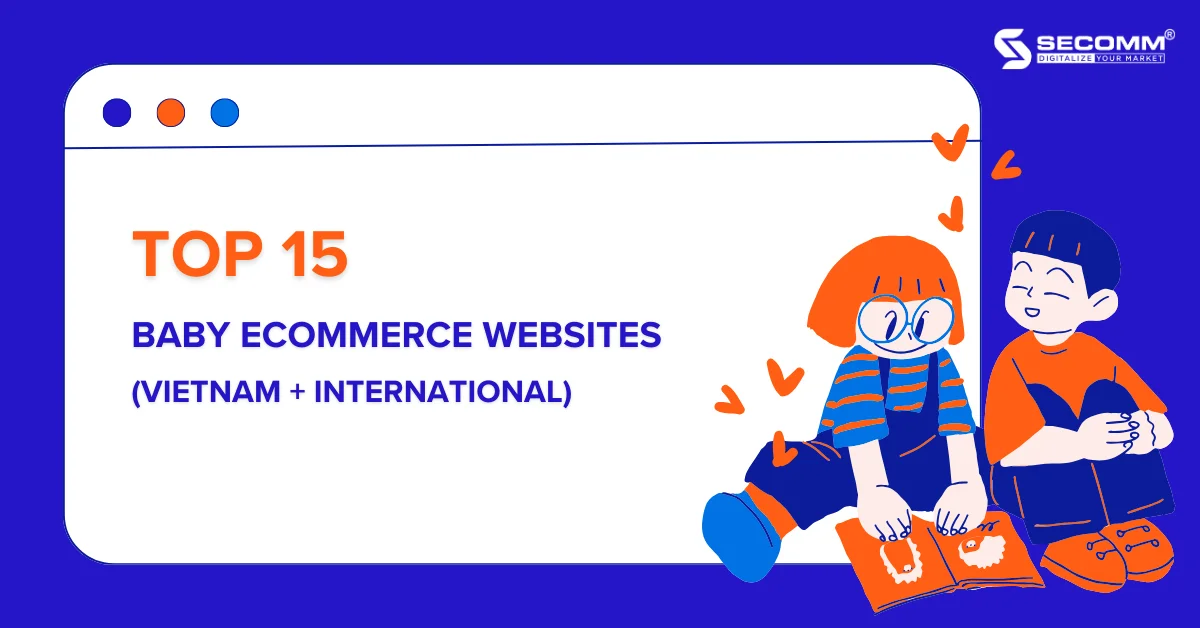
TOP 15 BABY ECOMMERCE WEBSITE (VIETNAM + INTERNATIONAL)
The global business landscape has faced significant challenges due to the Covid-19 pandemic. In response to this, many businesses across various sectors, particularly in the Baby industry, have prioritized the implementation of eCommerce strategies to connect with online customers and drive sales. Furthermore, to align with the broader economic trends, these retailers have transitioned from traditional business models to robust eCommerce operations to ensure growth and market expansion.
The following list showcases 15 successful Baby brands in Vietnam and around the world that have effectively adopted eCommerce websites, thus facilitating the swift participation of numerous other businesses.
Ava Kids
Ava Kids is the Baby eCommerce website of The Gioi Di Dong Corporation, offering a range of enticing online shopping benefits to customers. These include a 1-month return policy, complimentary shipping, special discounts for new customers, a rewards program, and informative guides for maternal and child health care.
Having been in operation for over a year, Ava Kids’ eCommerce website now enjoys over 2.1 million monthly visitors and has expanded its offline store network from 5 to 66 outlets.
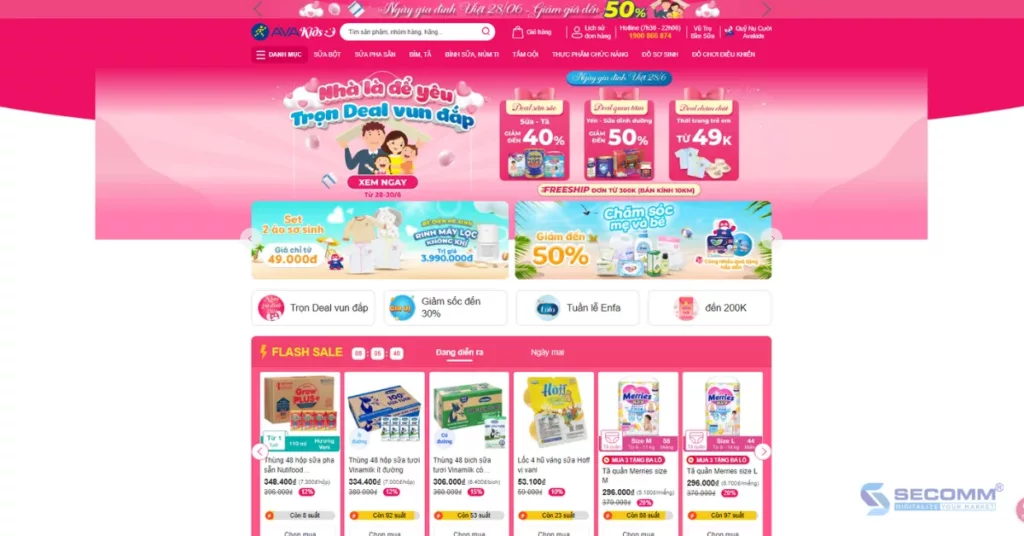
- Website: https://www.avakids.com/
- Platform: PHP language
- Traffic: 2.1M/month
- Ranking: 560 (Vietnam) & 30,546 (Worldwide)
Con Cưng
Established in 2011, Con Cung has grown to become Vietnam’s leading retail chain specializing in products for expectant mothers and babies, boasting over 700 stores across the country.
In recent years, Con Cung has made significant strides in developing its eCommerce website, catering to the online shopping demands of its customers. This expansion has enabled them to provide a rich shopping experience with a wide range of enticing offers, flexible payment methods, and 1-hour delivery services.
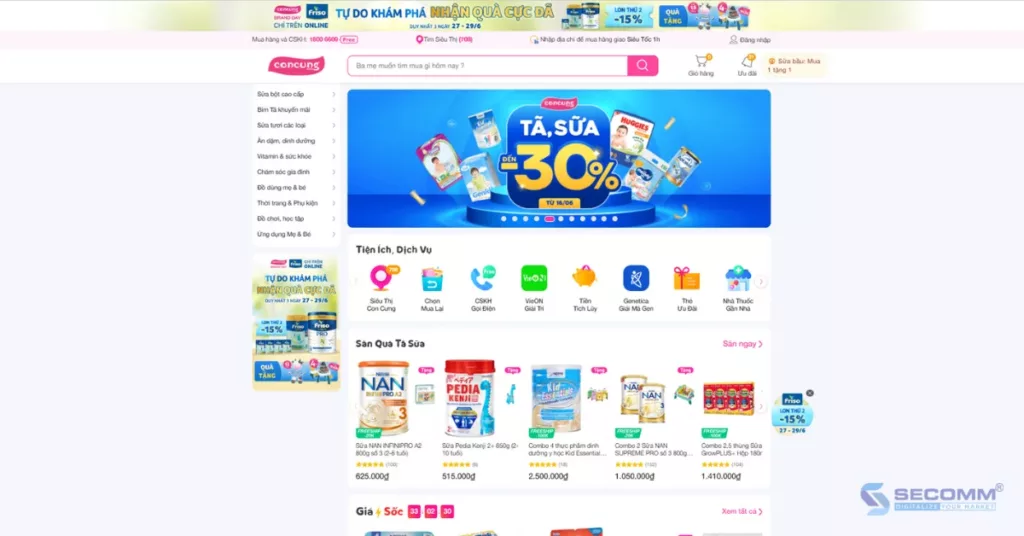
- Website: https://concung.com/
- Platform: PHP language
- Traffic: 1.3M/month
- Ranking: 891 (Vietnam) & 48,776 (Worldwide)
Kids Plaza
Founded in 2009, Kids Plaza is a major player in the eCommerce competition for the Baby industry. Kids Plaza has built an eCommerce website on the Magento platform to efficiently manage a vast and diverse product catalog. The brand consistently runs enticing promotional campaigns, offering gift-with-purchase deals, flash sales, buy-5-get-1-free offers, and a loyalty points system for redeemable rewards. These efforts have significantly driven up website traffic during promotional events, making Magento’s customization and scalability features indispensable for handling sudden surges in visitor numbers. On average, the website garners approximately 1 million visits per month.
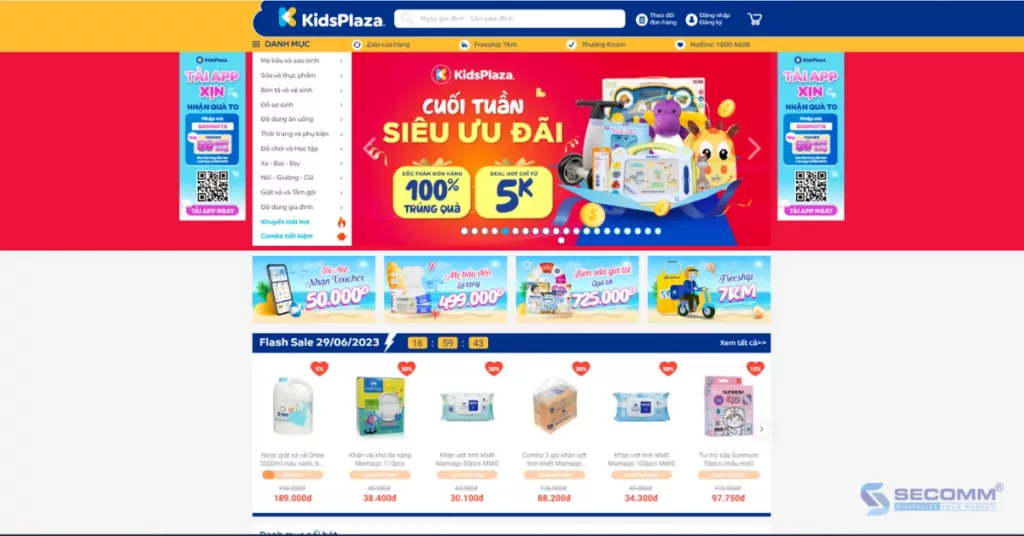
- Website: https://www.kidsplaza.vn/
- Platform: Magento
- Traffic: 1M/month
- Ranking: 1,316 (Vietnam) & 67,544 (Worldwide)
Bibo Mart
Founded in 2006, Bibo Mart, a retail chain dedicated to serving expectant mothers and babies, offers a diverse range of products, including maternity clothing, diapers, formula, and strollers. Just like its competitors, Bibo Mart is a strong contender in the eCommerce race.
To enhance the customer shopping experience, Bibo Mart opted for Magento Enterprise Edition (aka Adobe Commerce) to develop a custom eCommerce website. This platform enables the implementation of attractive promotions and a Loyalty Program. Presently, the website enjoys more than 500,000 monthly visitors.
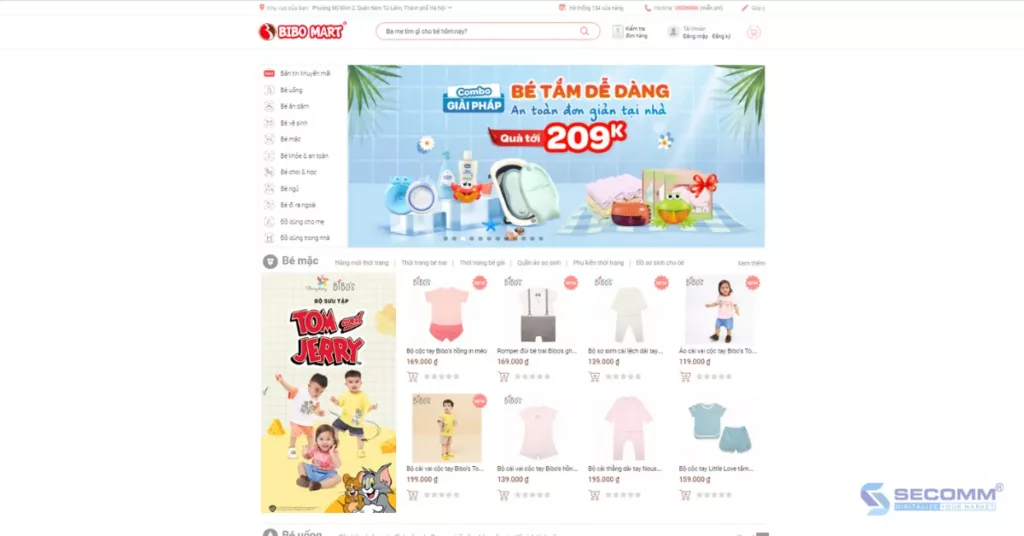
- Website: https://bibomart.com.vn/
- Platform: Magento Enterprise Edition (Adobe Commerce)
- Traffic: 518K/month
- Ranking: 2,216 (Vietnam) & 109,496 (Worldwide)
Shop Trẻ Thơ
Shop Trẻ Thơ stands as a well-known brand in the Maternity & Baby sector. The company is dedicated to establishing and advancing its eCommerce website alongside its network of 22 physical stores. This strategic move is aimed at staying in sync with the online shopping trend and securing a competitive edge in the realm of eCommerce.
Beyond a diverse product catalog, Shop Trẻ Thơ offers various enticing incentives to encourage online shopping, such as Buy 1 Get 1, cost-saving combos, gifts with purchase, discounts for new customers, and more. Currently, the website maintains a stable traffic of over 100,000 visitors per month.
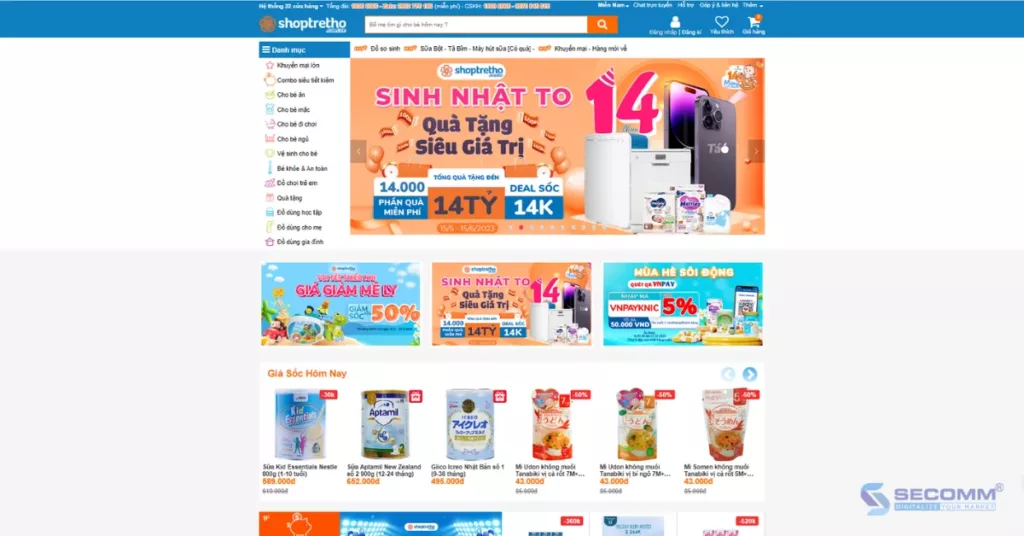
- Website: https://shoptretho.com.vn/
- Platform: PHP language
- Traffic: 133K/month
- Ranking: 9,242 (Vietnam) & 431,259 (Worldwide)
Tuticare
Tuticare is considered a prominent brand in the Maternity & Baby industry with a chain of 55 stores across Vietnam. Tuticare’s products undergo stringent checks, from their origins to their quality, providing a sense of assurance to mothers during their shopping experience.
The company has started an eCommerce website to provide customers with an optimized online shopping experience, along with various attractive programs and offers like a Tuti Gift Card, a subscription for diapers and milk, and more. Additionally, Tuticare offers diverse payment options, including eWallets and buy now pay later.
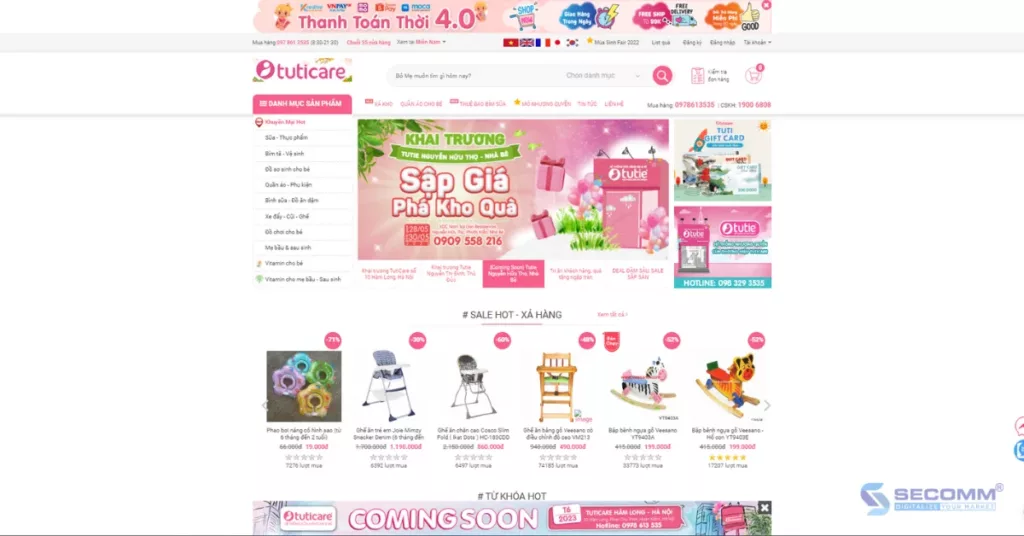
- Website: https://www.tuticare.com/
- Platform: PHP language
- Traffic: 113.7K/month
- Ranking: 9,304 (Vietnam) & 435,124 (Worldwide)
Mothercare
Mothercare, a brand focused on Baby products from the United Kingdom, offers a diverse range of fashion and essential items for expectant mothers and children of various age groups. Despite its recent inception, Mothercare has rapidly garnered attention, primarily due to its commitment to providing high-quality products at affordable prices.
The Mothercare website is strategically developed using the Magento platform, effectively catering to the online shopping preferences of their customers. Beyond attractive promotional programs, the Mothercare website also provides valuable insights on caring for newborns and young children through its dedicated blog section.
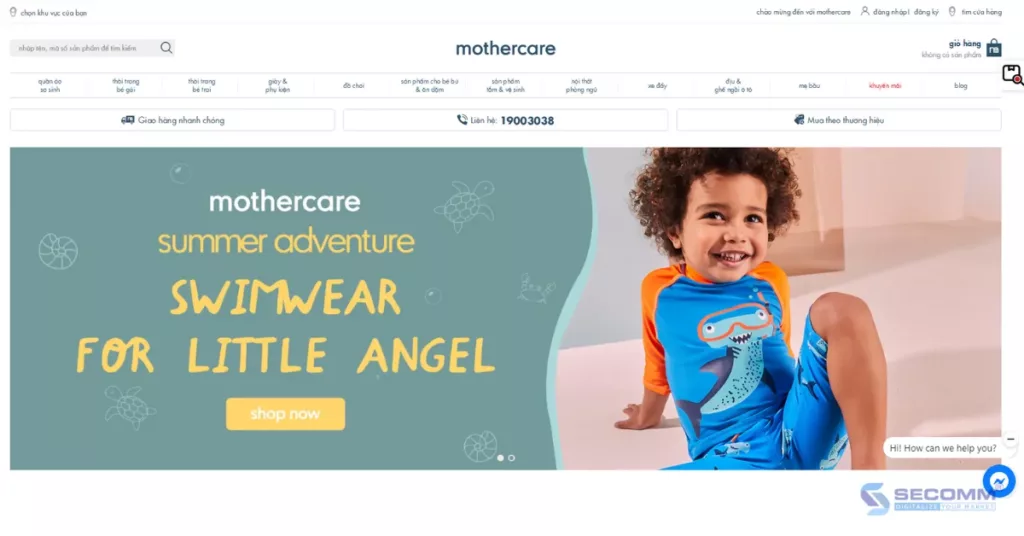
- Website: https://www.mothercare.com.vn/
- Platform: Magento
- Traffic: 28.8K/month
- Ranking: 14,558 (Vietnam) & 669,019 (Worldwide)
Soc & Brothers
Soc & Brothers is a rising name in the Baby eCommerce market, offering a diverse range of products for expectant mothers and children, including clothing, formula, diapers, strollers, and toys. The company has built an eCommerce website using Haravan and receives approximately 28,000 monthly visitors. Moreover, Soc & Brothers has implemented a Loyalty Program with three tiers: Silver, Gold, and Diamond, which can be utilized for purchases and point accumulation both at their offline retail stores and various online channels.
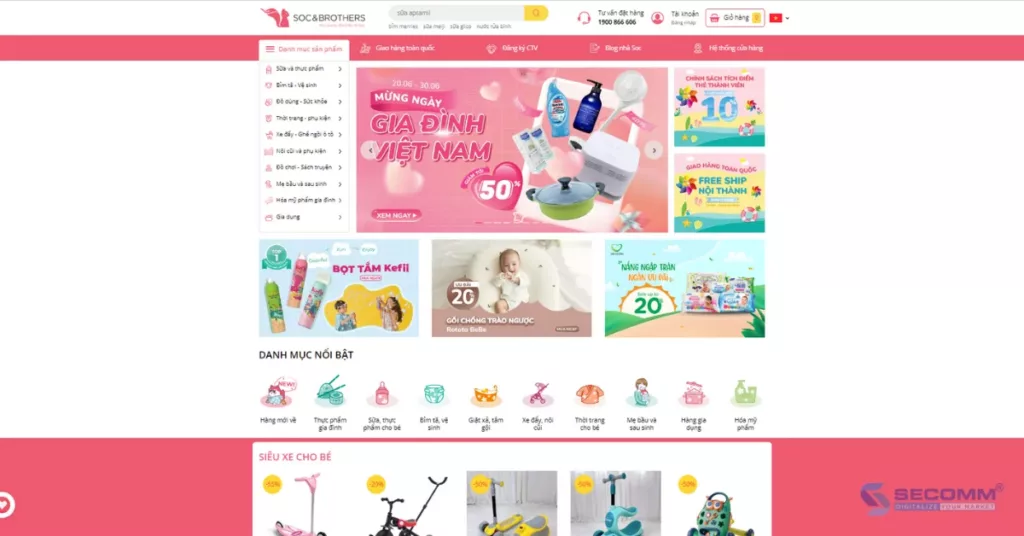
- Website: https://www.snbshop.vn/
- Platform: Haravan
- Traffic: 28.1K/month
- Ranking: 46,426 (Vietnam) & 1,950,408 (Worldwide)
Carter’s
Carter’s is a well-known children’s clothing brand in the North American region. Carter’s offers a wide range of products suitable for children of all ages, heights, and weights. Their website is built on Salesforce Commerce Cloud and features a primary color scheme of blue and white, emphasizing minimalism and cuteness. Currently, the website receives about 8.4 million monthly visits. Moreover, customers can purchase physical or eGift cards through the website, which can be customized in terms of design, value, and personal messages.
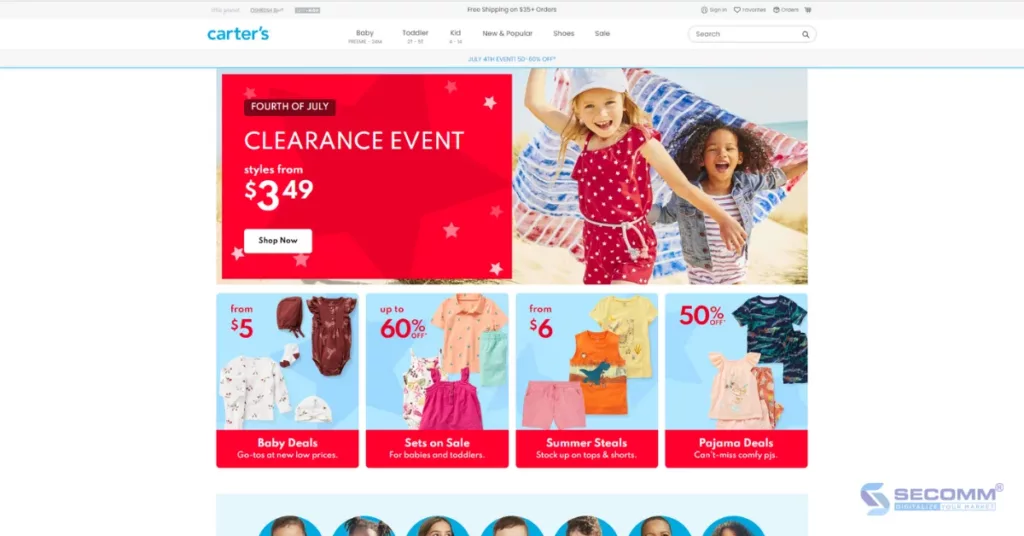
- Website: https://www.carters.com/
- Platform: Salesforce Commerce Cloud
- Traffic: 8.4M/month
- Ranking: 1,127 (USA) & 5,584 (Worldwide)
Hanna Andersson
Hanna Andersson is a well-known Swedish brand that specializes in children’s clothing, offering beautiful designs and a wide range of styles, sizes, and types of clothing, from everyday wear to sleepwear and swimwear. Hanna Andersson’s eCommerce website is built and developed using the Salesforce Commerce Cloud platform and garners more than 1.4 million monthly visitors. Hanna provides a personalized shopping experience by inviting its customers to participate in clothing selection consultations, parenting advice, and direct communication for new customers.
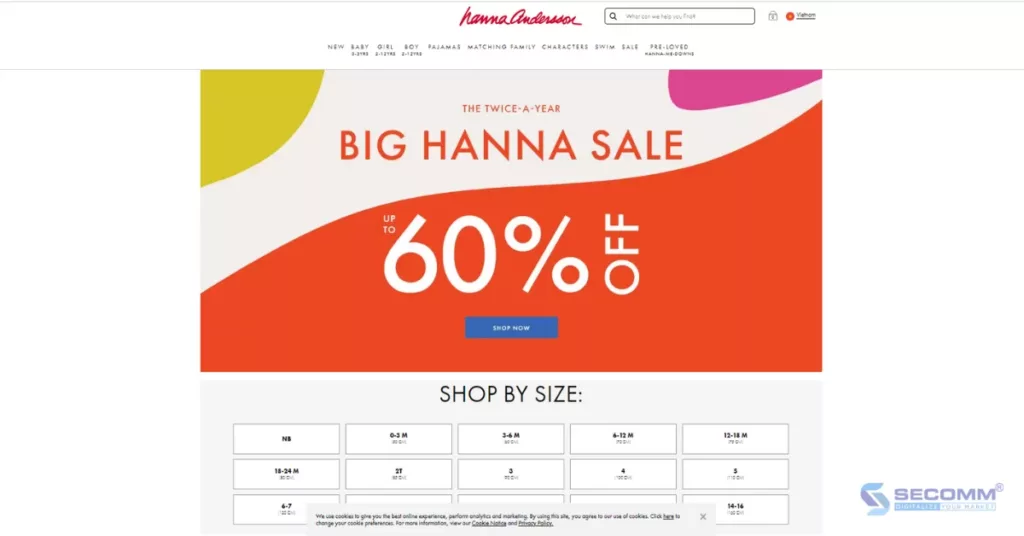
- Website: https://www.hannaandersson.com/
- Platform: Salesforce Commerce Cloud
- Traffic: 1.4M/month
- Ranking: 5,908 (USA) & 32,358 (Worldwide)
OshKosh B’gosh
OshKosh, a globally beloved children’s clothing brand, has achieved significant success by utilizing Salesforce Commerce Cloud to create an eCommerce website that delivers an exceptional online shopping experience. Presently, the website receives more than 900,000 monthly visitors and provides numerous appealing shopping incentives to its customers, including a rewards program that offers unexpected gifts, birthday presents, and discount vouchers.
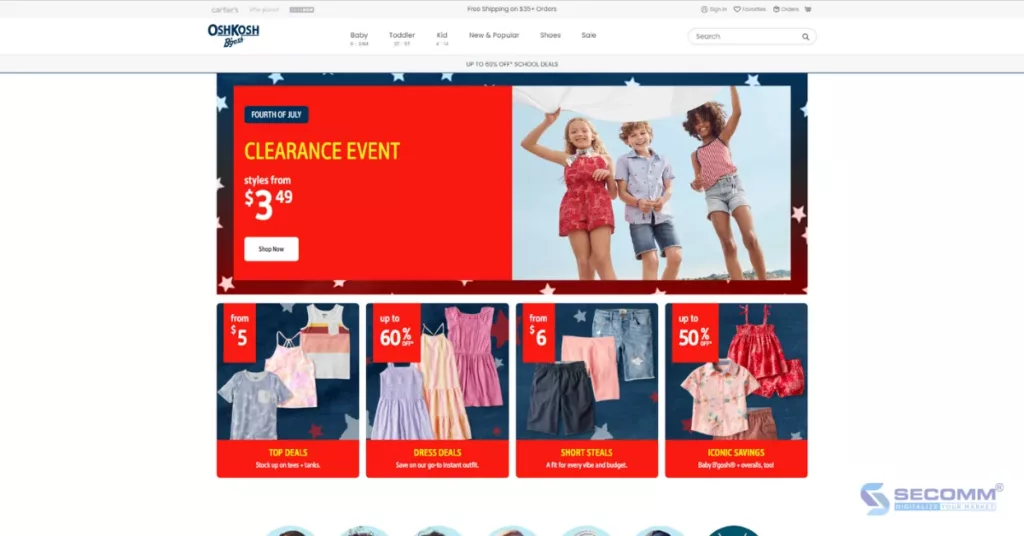
- Website: https://www.oshkosh.com/
- Platform: Salesforce Commerce Cloud
- Traffic: 919.4K/month
- Ranking: 11,805 (USA) & 56,197 (Worldwide)
Janie and Jack
Janie and Jack, another children’s fashion brand, has built an eCommerce website using the Salesforce Commerce Cloud platform. The company provides a wide variety of products for boys, girls, infants, as well as items such as jewelry and home decor. Notably, Janie and Jack has entered into a collaboration with Disney to offer fashion items featuring beloved Disney characters for children.
Additionally, the brand offers a gift-wrapping service that allows customers to select their preferred products, gift boxes, wrapping paper, and greeting cards. Customers can choose to wrap gifts themselves or take advantage of Janie and Jack’s professional gift-wrapping service.

- Website: https://www.janieandjack.com/home?lang=en
- Platform: Salesforce Commerce Cloud
- Traffic: 764.8K/month
- Ranking: 9,339 (USA) & 51,103 (Worldwide)
Children Salon
Children Salon, established in 1952, is one of the leading brands in high-end fashion for children. They offer many products, including clothing, shoes, and hats for boys, girls, and teenagers. The company specializes in designing and producing children’s fashion collections for top global brands such as Versace, Givenchy, Burberry, Dolce & Gabbana, Calvin Klein, and more. Additionally, customers who purchase these designer products on the Children Salon website can enjoy discounts of up to 60%.
Children Salon’s eCommerce website is built on the Magento platform, featuring advanced functions like filtering products by size and age, displaying available sizes, and currency conversion for product prices, among others. The website currently receives over 600,000 monthly visits.

- Website: https://www.childrensalon.com/
- Platform: Magento
- Traffic: 647.5K/month
- Ranking: 56,386 (USA) & 90,938 (Worldwide)
Motherhood Maternity
Motherhood Maternity’s eCommerce website is a well-known and trusted fashion shopping destination for expectant mothers. The website, built on the Shopify platform, garners around 400,000 monthly visits.
Beyond its wide array of clothing and supportive accessories, Motherhood offers an “Expert Guide” section dedicated to sharing valuable knowledge about prenatal healthcare. Furthermore, the “Preggie Perks” program allows customers who shop on the website to have the chance to receive discount vouchers or unique gifts, conveniently delivered with their products to their doorstep.

- Website: https://www.motherhood.com/
- Platform: Shopify
- Traffic: 426.8K/month
- Ranking: 17,468 (USA) & 98,316 (Worldwide)
HATCH Collection
HATCH Collection, a renowned global brand, specializes in offering fashion and beauty products for expectant mothers. Despite its establishment in 2011, the brand has chosen to maintain only two physical stores in California and New York, as HATCH’s primary focus lies in online retail.
Operating through its eCommerce website, HATCH has introduced several programs for their customers. One notable initiative is “NIKKI’s List,” wherein customers respond to specific questions, enabling HATCH to generate personalized product recommendations. The HATCH website is constructed and managed using the Shopify platform and receives approximately 223,000 monthly visits.
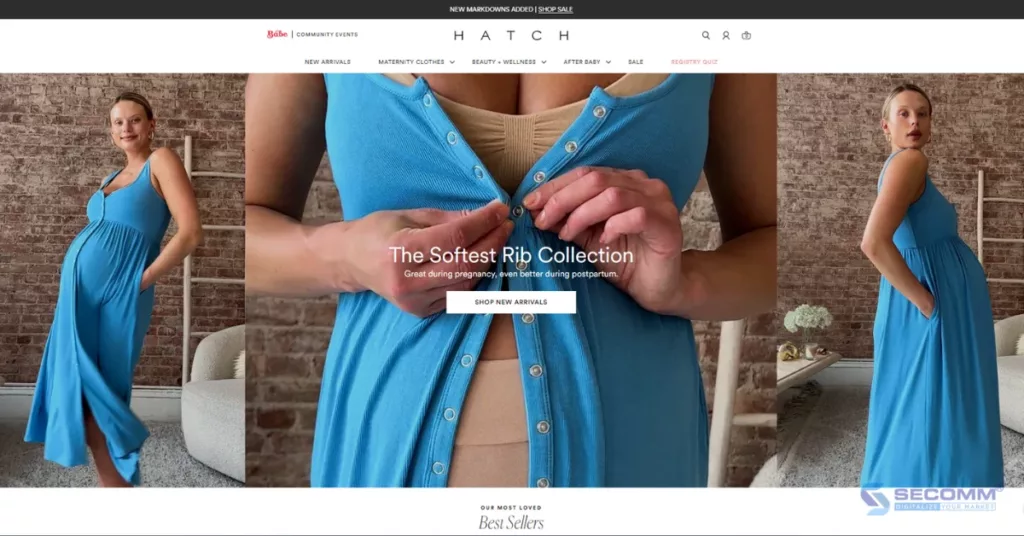
- Website: https://www.hatchcollection.com/
- Platform: Shopify
- Traffic: 223.7K/month
- Ranking: 40,787 (USA) & 204,740 (Worldwide)
The surge of the Covid-19 pandemic has made a significant impact on consumer shopping habits, particularly in the Baby sector, where a profound shift from offline to online shopping has been witnessed.
Presented here are 15 eCommerce websites, showcasing leading brands in the Mother & Baby industry, both in Vietnam and internationally. These brands exemplify their adaptability in capturing consumer trends and their commitment to enhancing technological infrastructure to compete for a share in the billion-dollar market.
With a track record of successfully implementing eCommerce solutions for a diverse clientele across various countries in recent years, SECOMM specializes in offering expert consultation and tailored eCommerce deployment solutions, tailored to the specific requirements of each industry.
For a free consultation, contact us or call directly to the SECOMM hotline at (02871089908).
 2
2

 10,165
10,165

 0
0

 1
1
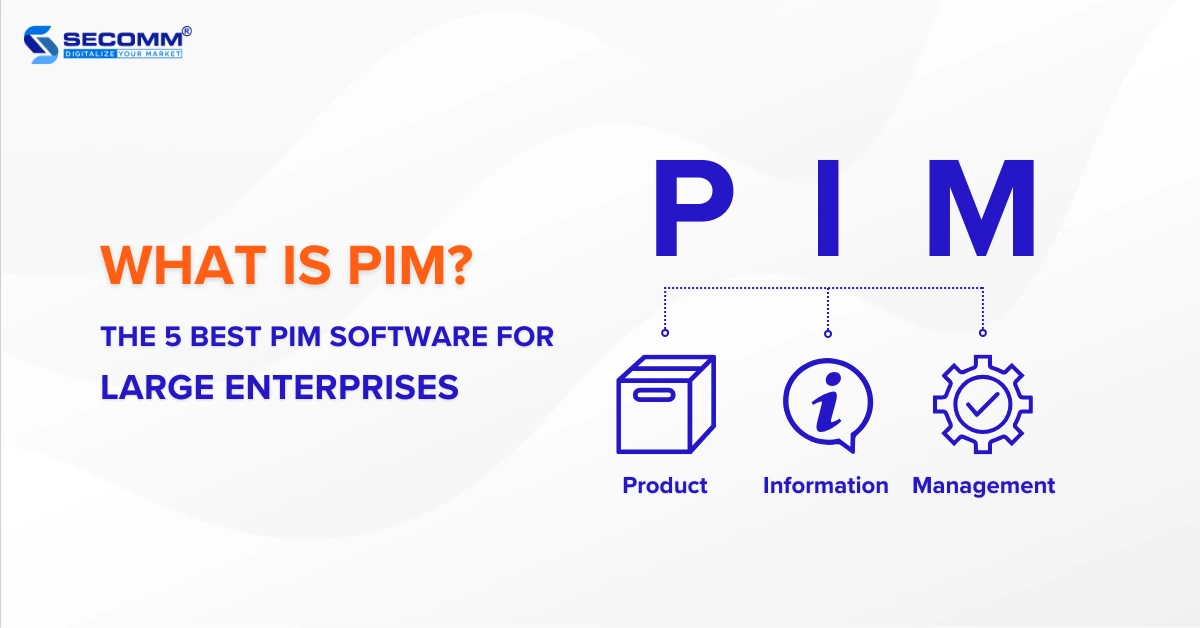
WHAT IS PIM? THE 5 BEST PIM SOFTWARE FOR LARGE ENTERPRISES
PIM is an essential management system that helps synchronize product information across various systems like ERP, POS, CRM, SCM, etc., and a brand’s global sales channels. It’s considered the powerful ‘right hand’ of large corporations for comprehensive information management.
What is PIM?
PIM or Product Information Management is a system or platform used to collect, organize and manage detailed product information for businesses. PIM includes information such as product descriptions, images, prices, product attributes, customer ratings and reviews.
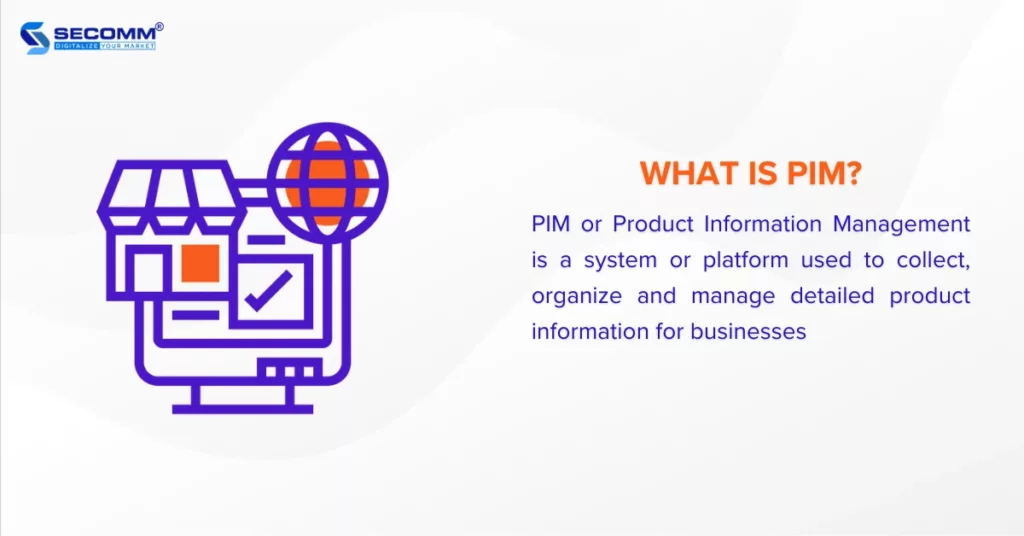
PIM systems often integrate data from ERP, CRM, POS, and other business management systems related to a company’s products. Once integrated, shared data.
Related article: What is POS? Why your eCommerce business need it?
Benefits of using PIM software
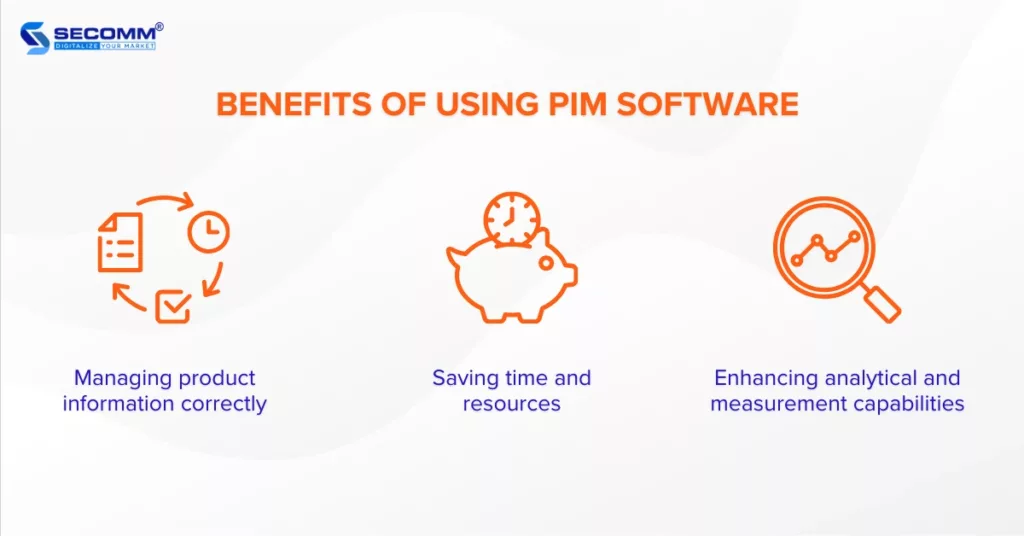
Managing product information correctly
PIM software allows businesses to accurately and consistently collect, organize, and manage product information. This ensures that product information is updated correctly and comprehensively across all sales channels, from eCommerce websites, mobile apps, and social media to marketplaces like Shopee, Lazada, Tiki, Sendo, Amazon, and more. When accurate product information is provided to customers, businesses can enhance trust and reputation for their brand.
Saving time and resources
A PIM system automates the processes of data entry, processing, and product information distribution. This saves time and effort for employees while reducing the risk of errors compared to manual data entry. With more efficient workflows in place, PIM allows employees to focus on other, more critical tasks.
Enhancing analytical and measurement capabilities
PIM software enables efficient analysis and measurement of product information. By monitoring, evaluation, and data analysis of product details, businesses can gain insights into the performance of marketing campaigns, consumer trends, customer behaviors, and more. Therefore, this empowers them to make more informed and effective business decisions for the future.
Top 5 PIM software for Vietnamese businesses
Akeneo
Akeneo is a widely embraced PIM platform known for its broad range of services, including open-source PIM and cloud-based PIM systems, etc.
Currently, Akeneo offers three primary PIM solution packages:
- Community Edition: Free of charge – Designed for small and medium-sized enterprises looking to efficiently manage and distribute product information at a minimal cost.
- Growth Edition: Starting at $25,000 per year – Tailored for mid-sized companies aiming to unlock the potential of product information management.
- Enterprise Edition: Pricing upon request – Catered to large corporations in need of a specialized PIM system.
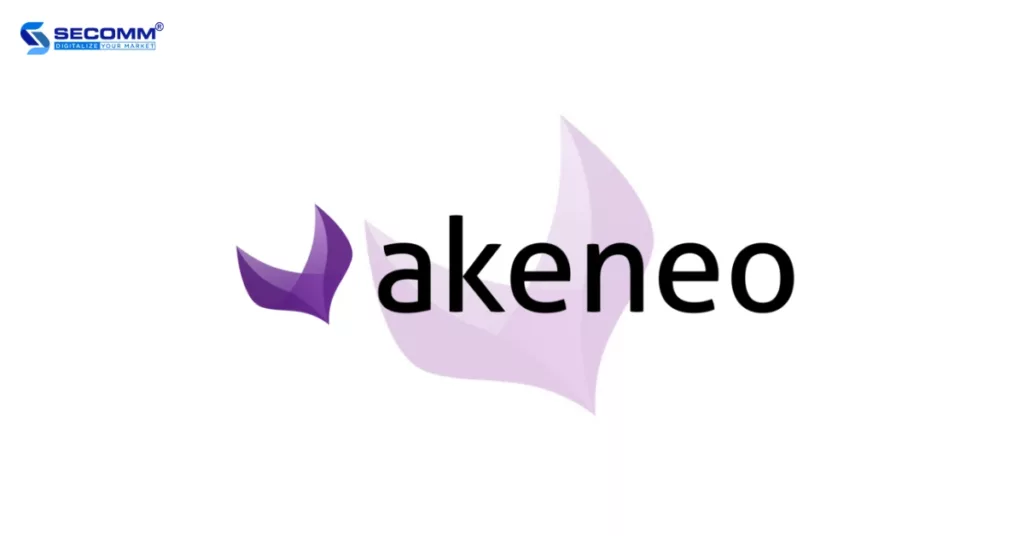
Pros:
- Effective product information management: Akeneo enables businesses to easily manage product information, from data input to classification and organization, creating a precise and consistent source of product data.
- High integration: Akeneo seamlessly integrates with other systems such as ERP, CRM, POS, and eCommerce platforms (Magento, Shopify, WooCommerce, etc).
- Scalability: Akeneo provides APIs and an open development framework, allowing businesses to expand and customize the PIM platform based on their specific needs.
Cons:
- High costs: The cost of using Akeneo is relatively high compared to other PIM systems.
- Complexity: Akeneo has some highly complex features that require time and expertise to effectively implement. Moreover, training employees and managing the Akeneo PIM system may demand a certain investment.
- Customer support: Some users find that Akeneo’s customer support can only address general knowledge and may not be able to resolve technical issues or address industry-specific concerns for each brand.
1WorldSync
1WorldSync is a company that specializes in providing solutions for managing product information and synchronizing product data for large enterprises. Their platform is built on a global network for product data synchronization, connecting suppliers, retailers, distributors, and various stakeholders worldwide.
1WorldSync currently offers four customizable solutions tailored to the needs of large enterprises:
- Base: Geared towards businesses looking for quick and efficient global product content management.
- Plus: Leverages product content to boost marketing strategies and sales initiatives, and ensures compliance with transparent information policies.
- Pro: Delivers a visual data solution along with premium support services for setting up and managing high-quality product portfolios.
- Premier: Enhances brand visibility in the eCommerce market through carefully curated. high-quality content.
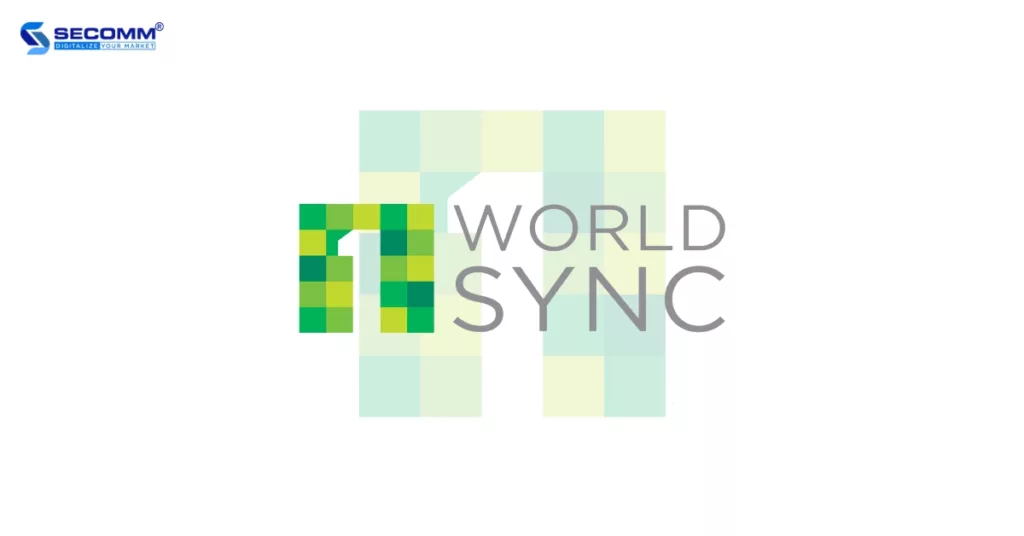
Pros:
- Comprehensive product information management: 1WorldSync offers a robust platform for managing product information, including images, descriptions, technical attributes, barcodes, and other details. This helps businesses efficiently maintain and update product information.
- Global product data synchronization: 1WorldSync establishes a global network for product data synchronization, enabling businesses to connect and share product information with partners and customers worldwide. This network ensures the consistency of product information across various sales channels.
- Enhancing customer experience: By providing detailed, accurate, and consistent product information across sales channels, 1WorldSync improves the shopping experience and product evaluations for customers.
Cons:
- High costs: Since 1WorldSync is a PIM system designed for each business, the cost of using 1WorldSync can be relatively high
- Complex regulations and standards: Businesses must ensure that managing and sharing product information on 1WorldSync complies with legal regulations and standards, such as privacy rights, data protection, and industry standards.
- Complex and user-unfiendly: The interface and workflow on 1WorldSync can be relatively complex and challenging to understand for new users. It requires time and resources to train employees and adapt to the new system.
Sales Layer
Sales Layer is a PIM platform tailored for efficient product data management across medium and large businesses on a global scale. This PIM solution is designed with customization in mind, and its pricing varies depending on specific business needs, with a starting cost of $1,000 per month.
Sales Layer currently offers several solution packages, including:
- Premium: An ideal choice for businesses seeking a swift and sustainable PIM system implementation.
- Enterprise: A comprehensive solution providing all the essential features for elevating a medium-sized business into a global enterprise.
- Enterprise Plus: A specialized PIM solution adept at effortlessly handling intricate data challenges within businesses.
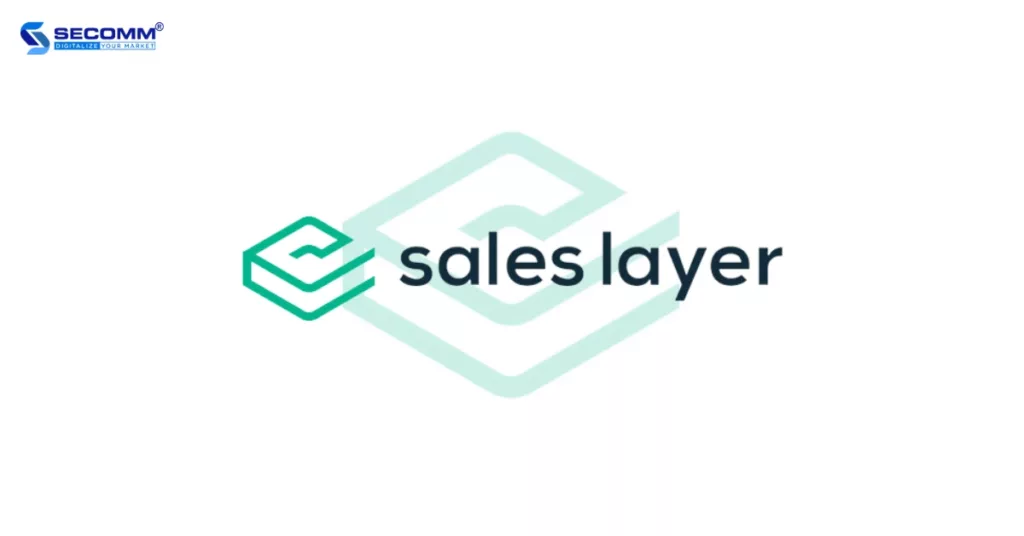
Pros:
- Centralized product information management: The Sales Layer provides a centralized platform for managing product information, ensuring data consistency.
- Workflow and process control: Sales Layer offers tools for managing workflows and work processes to organize and manage product information updates and approvals, guaranteeing data quality.
- Rapid information retrieval and search: The Sales Layer incorporates algorithms that enable swift retrieval and searching of information to meet specific user demands.
Cons:
- Complex implementation process: One of the drawbacks of the Sales Layer is its relatively intricate deployment and initial configuration, especially for businesses with existing and large-scale systems.
- Specialized training requirements: Sales Layer may necessitate a certain amount of training time to become familiar with the interface and functionalities of this PIM system. Training employees and ensuring proficiency in using the Sales Layer can be time-consuming and resource-intensive.
- Limited technical support: In the event of issues or technical problems, support from the Sales Layer may not fully meet expectations or provide a quick resolution.
Salsify
Salsify is a cloud-based product information management (PIM) platform that offers businesses a solution to efficiently manage and distribute product information across various sales channels. Salsify functions as a software a service (SaaS) application, with usage costs tailored to each business, typically ranging from $2,000 to $5,000 per month.
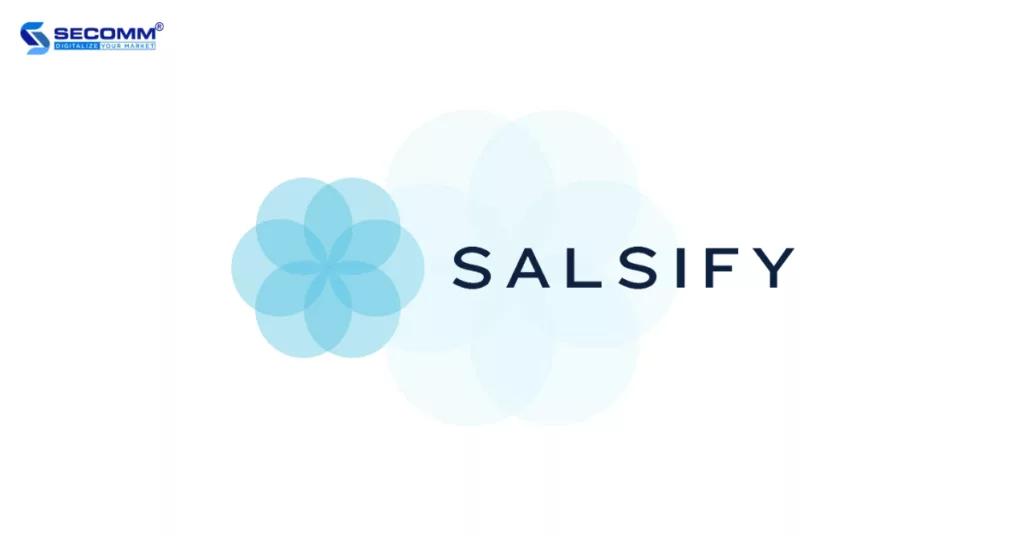
Pros:
- Comprehensive workflow management: Salsify offers the capacity to manage workflow procedures, permitting the adaptation, monitoring, and endorsement of alterations in product data, guaranteeing accuracy and proficient control of work processes.
- Multilingual and multiregional compatibility: Salsify backs the management of product data in several languages and geographic regions, facilitating effective expansion into international markets.
- Seamless integration with various systems: Salsify permits integration with diverse business management systems and tools like ERP, CRM, SCM, POS, and more, streamlining business processes.
Cons:
- High deployment and maintenance costs: The initial deployment and ongoing maintenance expenses for a PIM system on Salsify can be relatively high compared to other PIM systems. This might impact a business’s long-term financial resources.
- Initial data input challenges: Importing initial product data and information into Salsify can be challenging and time-consuming, particularly when dealing with a large volume of product details from various sources. This process requires meticulous attention to ensure accuracy.
- Complexity in usage: Salsify offers a wide array of features and product management capabilities, but it also comes with a corresponding level of of complexity. Learning how to use Salsify effectively may necessitate time spent delving into guides and documentation.
inRiver
inRiver is a PIM system developed to efficiently manage and distribute product information across various sales channels and different eCommerce platforms such as Adobe Commerce, Shopify, WooCommerce, BigCommerce, etc. The cost of using inRiver is approximately $1,000 per month.
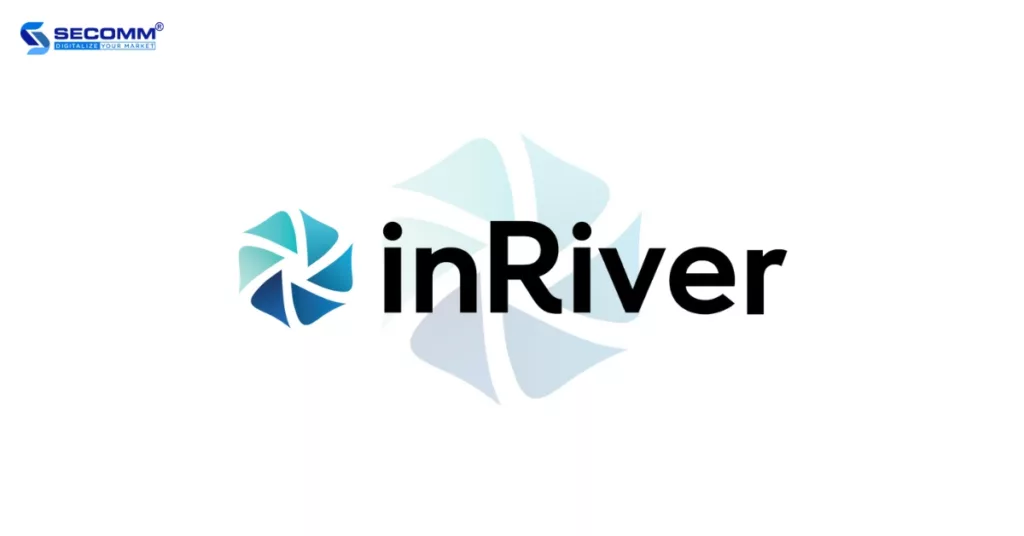
Pros:
- Product variations management: inRiver supports the management of information regarding product variations, including color options, sizes, styles, and other details. inRiver enables comprehensive and diverse product information display, effectively meeting customer needs.
- Integration with DAM support: inRiver supports integration with Digital Asset Management (DAM) systems, allowing the management and linkage of digital assets such as images, videos, and product-related documents. This enhances the management and distribution of multimedia content related to products.
- High scalability: inRiver is designed to expand its capabilities according to a business’s specific requirements, catering to diverse business needs and objectives.
Cons:
- Complex user interface: Some users may find it challenging to navigate River’s user interface due to its relatively complex nature, requiring training to become familiar with and use effectively.
- Resource-intensive PIM system implementation: Implementing and maintaining inRiver demands a highly skilled workforce.
- Complex customization capabilities: Customizing and integrating inRiver with existing systems and workflows can be intricate and require technical expertise. This can result in difficulties and increased costs associated with system integration and customization.
Above is a summary of the top 5 PIM software options tailored for large-scale businesses, each with its own unique set of advantages and disadvantages. Depending on the requirements for PIM system development and budget considerations, companies can explore and select the most appropriate PIM solution.
Get in touch with SECOMM for more information!
 2
2

 15,041
15,041

 0
0

 1
1
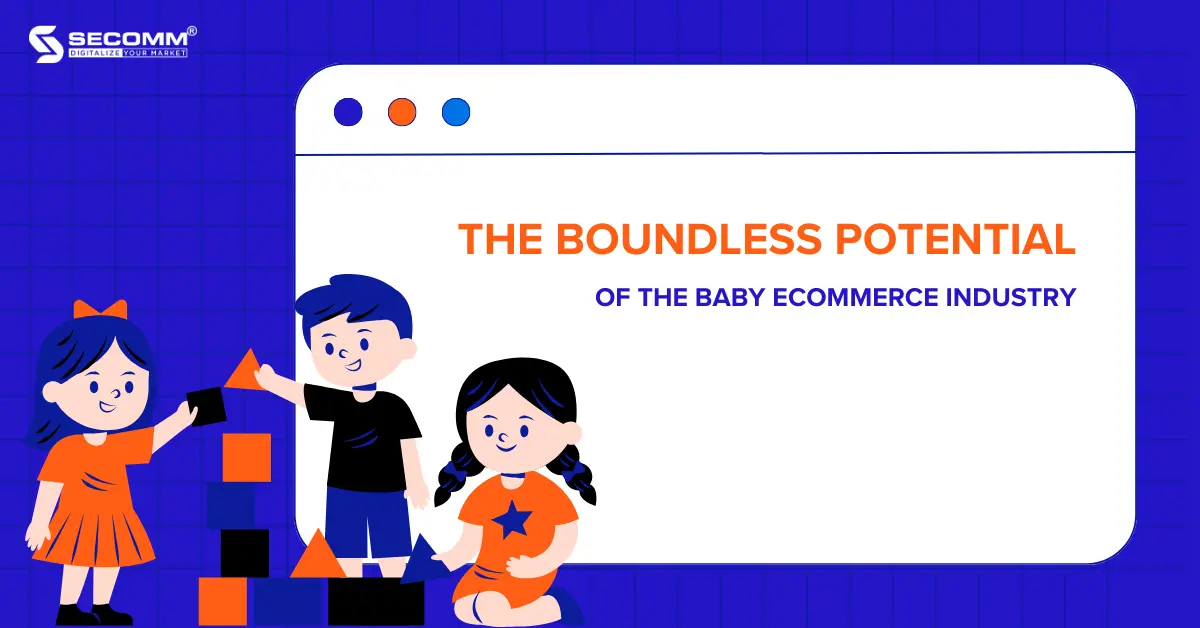
THE BOUNDLESS POTENTIAL OF THE BABY ECOMMERCE INDUSTRY
Recent statistics indicate that Vietnam has a population of 24.7 million children and roughly 24.2 million women of childbearing age. Moreover, with an annual birth rate of approximately 1.5 million children, Vietnam stands out as a prospective market for the baby industry. As a result, it comes as no surprise that many baby brands have been progressively establishing and expanding their stores year by year. Additionally, the industry benefits from the momentum created by the pandemic and the evolving trend of transitioning from offline to online shopping.
3 reasons for baby brands to get on board with eCommerce
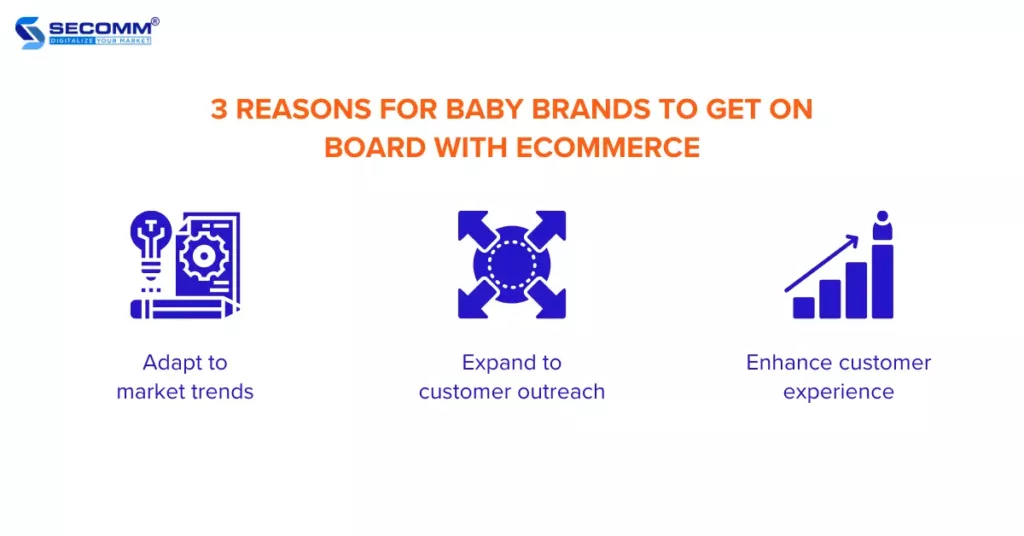
Adapt to market trends
While offline businesses experienced a downturn during the period of social distancing, leading to the contraction of many retail chains, online commerce has been flourishing. Even as society progresses towards a “reopening” phase in the post-pandemic world, the preference for online shopping remains strong. The demand for various products, spanning from timepieces, cosmetics, and groceries, to mom-and-baby essentials, on eCommerce websites and marketplaces continues to steadily surge.
Hence, the solution for Baby enterprises to align with market trends involves the implementation of an O2O (Online to Offline) model. This approach integrates offline sales (leveraging existing physical store networks) with online channels. Among these channels, establishing an eCommerce website is paramount for businesses to promptly deploy sales and marketing strategies, attracting customers and preventing potential loss to competitors.
Expand to customer outreach
When physical stores are constrained by location, staffing, and operating hours, online stores remain open and accessible from anywhere worldwide. This offers Baby businesses the opportunity to extend their reach to a large pool of potential customers on the Internet.
By implementing effective strategies like optimizing SEO, running advertising campaigns, or leveraging social media, Baby businesses can swiftly boost their brand recognition, attract a diverse clientele to their eCommerce website, and facilitate round-the-clock product sales.
Top Vietnamese Baby eCommerce sites
Con Cung
Launched in 2011, the Con Cung retail chain quickly gained recognition and became the top choice for many Vietnamese families to shop for mom-and-baby products, offering a catalog of over 2000 items. In 2016, with the investments received, Con Cung significantly expanded its store chain from 100 in 2016 to 400 in 2020 (currently at 700 stores).
Recognizing the evolving consumer landscape with a shift from offline to online shopping, the brand proactively intensified its online retail efforts through its eCommerce website and mobile app, enriching the shopping experience for its customers. With this in mind, Con Cung has set an ambitious target of reaching 1 billion USD in revenue by 2023 and aims to capture a 30% market share, envisioning a 2 billion USD in revenue by 2025, with at least 30% coming from eCommerce.
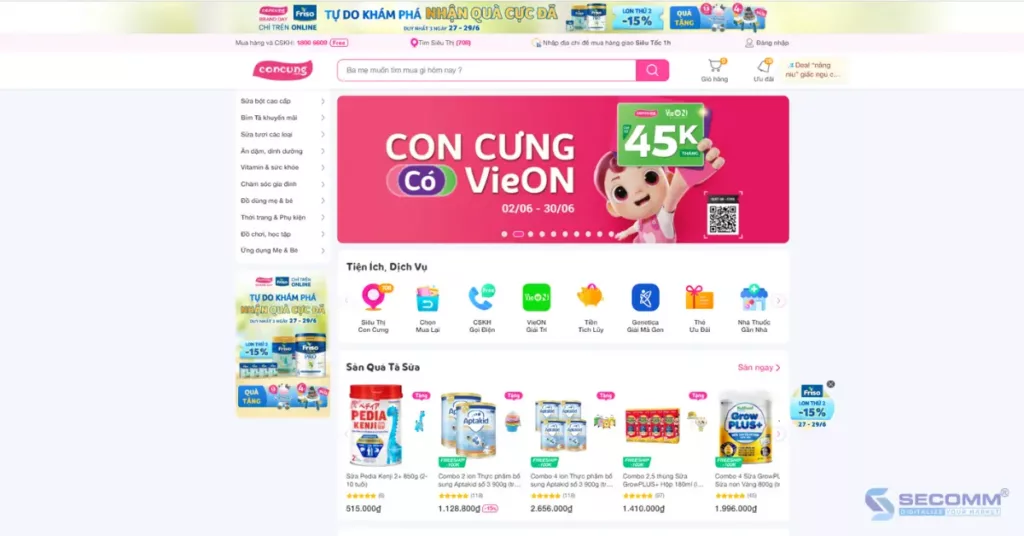
Therefore, in recent times, Con Cung has made an effort to attract customers to its eCommerce website. They consistently promote various enticing programs, including “Monday Freeship Day” and the “Stuffed Animal Fiesta for 99K.”
Additionally, Con Cung has kept pace with the Mobile Commerce trend by introducing the ‘Con Cung’ mobile app, available on both App Store and Google Play. This app has garnered highly positive user feedback and currently ranks 24th in the Shopping category.
Particularly, this retailer’s delivery service has earned high praise from customers. With a network of over 700 stores across the country. Con Cung offers lighting-fast 1-hour delivery through its “Pink Warrior” delivery team. Beyond partnering with third-party delivery providers such as Grab Expres, Giao Hang Nhanh, Giao Hang Tiet Kiem, the brand also maintains a dedicated team of delivery warriors who cater to customer’s specific time preferences.
Kids Plaza
Established in 2009, Kids Plaza offers more than 10,000 mom-and-baby products, certified safe for babies from top-notch brands in Vietnam and around the world. In the competitive race, Kids Plaza has consistently fortified its position by embracing the O2O business model.
This strategy involves harmoniously blending traditional in-store retail with a variety of online channels, including a dedicated website, eCommerce platforms, Zalo stores, mobile applications, and more. Kids Plaza has rolled out enticing customer loyalty programs such as Kicoin, the convenient Freeship policy covering a 7km radius for all purchasing channels, and exclusive discounts for expectant mothers when shopping in brick-and-mortar stores.
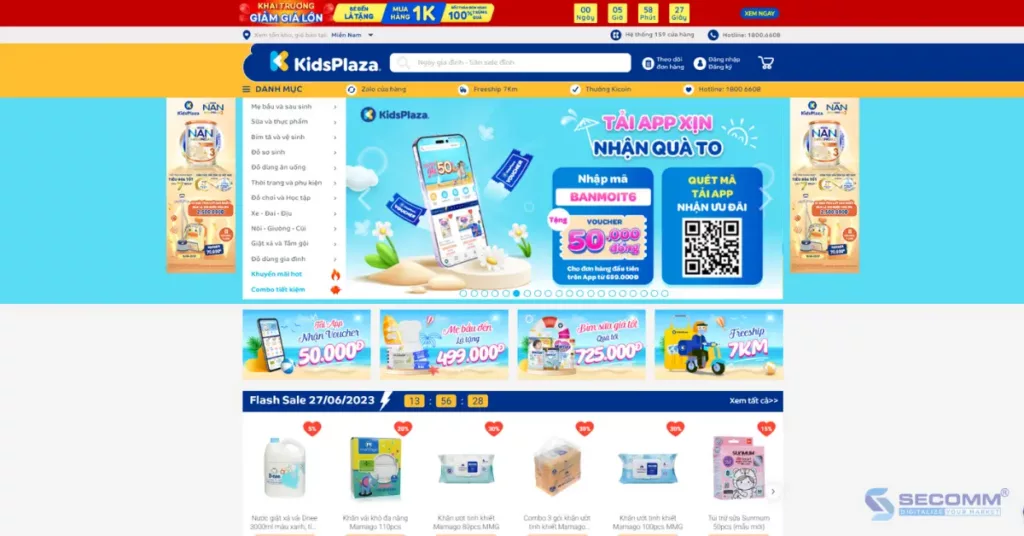
Customers aren’t only satisfied by the seamless shopping experience, affordable prices, and appealing promotional offers but also by exceptional product quality. All products undergo strict quality control before being officially offered for sale to provide the best experience and service, ensuring customers’ peace of mind while shopping.
Kids Plaza also demonstrates its care for expectant moms and babies through programs like the free antenatal classes, which have been conducted for over a decade and have successfully aided numerous mothers during their childbirth journeys. Moreover, the brand hosts annual community events and maintains an insightful knowledge-sharing blog to help elevate health awareness among both mothers and children.
Bibo Mart
The mom-and-baby retail chain, Bibo Mart, was established in 2006 and specializes in offering a wide range of products for mothers and babies, including maternity clothing, diapers, formula, and strollers. Similar to Con Cung and Kids Plaza, Bibo Mart hasn’t lagged behind in the eCommerce race. After years of operation and growth, Bibo Mart has identified a new vision for investing in an eCommerce system to meet the online shopping needs of its customers.
Currently, online sales at Bibo Mart account for 14.5% of the total revenue and are expected to increase to over 30% in the next five years. Beyond frequently offering attractive incentives to encourage customers to shop on their website and app, Bibo Mart has introduced a loyalty program with four tiers: Loyal, Silver, Gold, and Diamond. Customers are assigned membership ranks based on their specified spending levels and earn BiXu points for continued exclusive benefits.
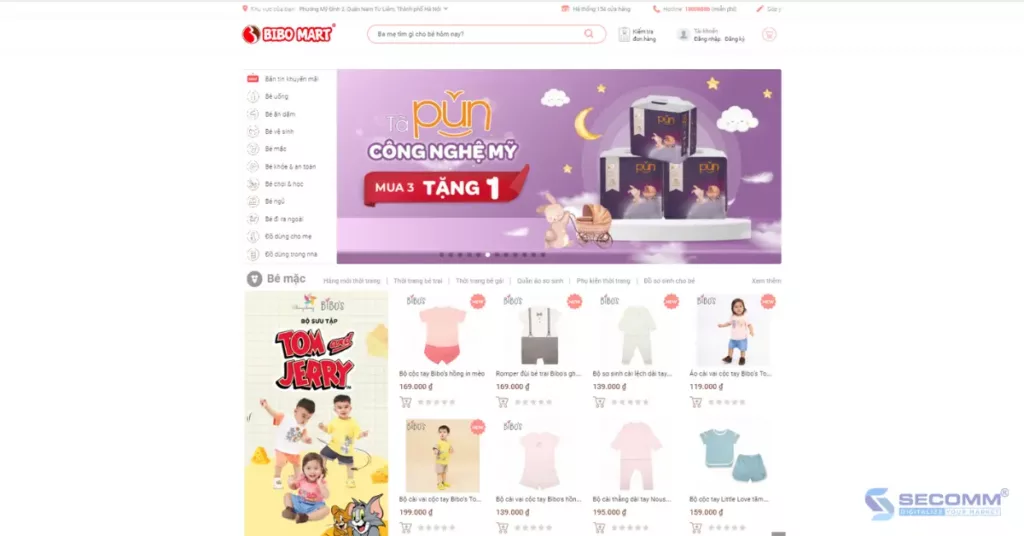
Notably, customers can use a QR code on the app to scan for product info or accumulate points when shopping in physical stores. Bibo Mart also demonstrates its commitment to its customers by providing maternal and childcare knowledge through blogs and free online seminars and classes for mothers as well as those caring for their health during pregnancy and postpartum.
The potential of the Baby eCommerce market in Vietnam is enormous, and the success of major players like Con Cung, Kids Plaza, and Bibo Mart has encouraged the participation of other businesses. However, for a Baby eCommerce business to succeed, it’s important to build a comprehensive and feasible strategy, both short-term and long-term. Particularly, eCommerce websites and mobile apps are the two crucial keys that determine the success or failure of a business in the eCommerce race.
Having partnered with many businesses in implementing eCommerce websites and apps over the years, SECOMM has accumulated practical experience to assist businesses in swift and effective deployment.
Feel free to contact us or call SECOMM’s hotline at (02871089908) for a free consultation.
 2
2

 12,780
12,780

 0
0

 1
1
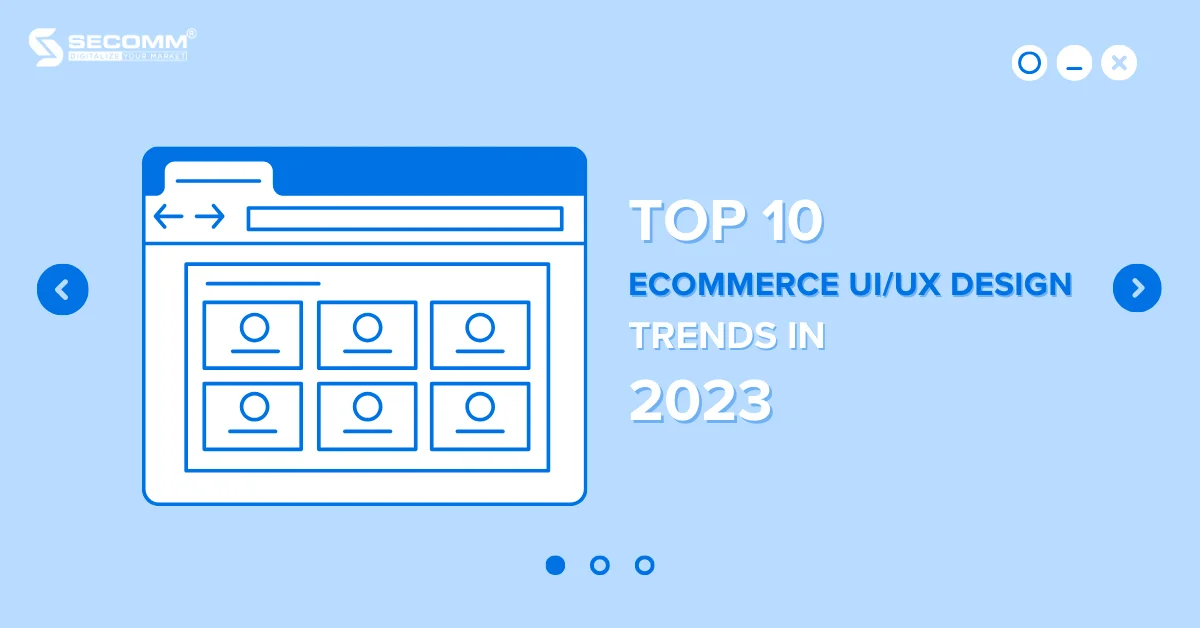
TOP 10 ECOMMERCE UI/UX DESIGN TRENDS IN 2024 AND BEYOND
As new UI/UX design trends emerge, designers must stay up-to-date to create the most engaging and user-friendly interfaces for businesses. UI/UX design plays a vital role in crafting excellent user experiences and improving online business efficiency.
In this article, SECOMM will discuss the latest UI/UX design trends for the year 2024 and beyond
What is UI/UX design?
User Interface (UI) and User Experience (UX) are often regarded as two interrelated aspects when it comes to designing interfaces for any online product or service, especially in the case of eCommerce websites.
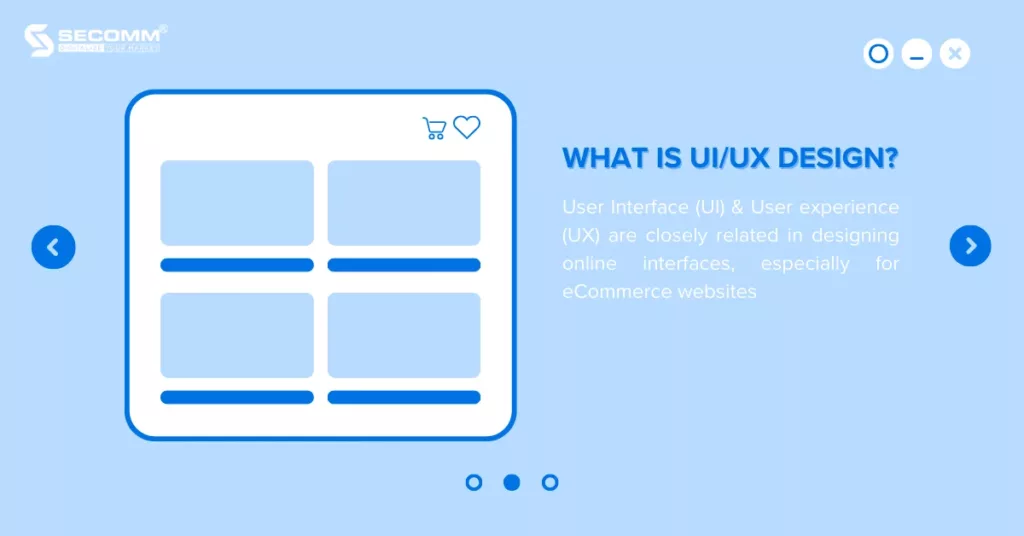
UI design encompasses the creation of various elements like call-to-action buttons, navigation bars, charts, and images, all based on choices of colors, layouts, fonts, and more, to craft an intuitive, appealing, and visually engaging user interface. In design, UI serves as a means to convey messages from businesses and brands to their users.
On the other hand, User Experience (UX) involves the process of shaping the overall experience for users during their interaction with a product or service. This encompasses meeting user requirements for ease of use and functionality, strategizing and structuring information, designing interaction workflows, and assessing effectiveness through research on user habits and behaviors within eCommerce websites.
The role of UI/UX design in eCommerce
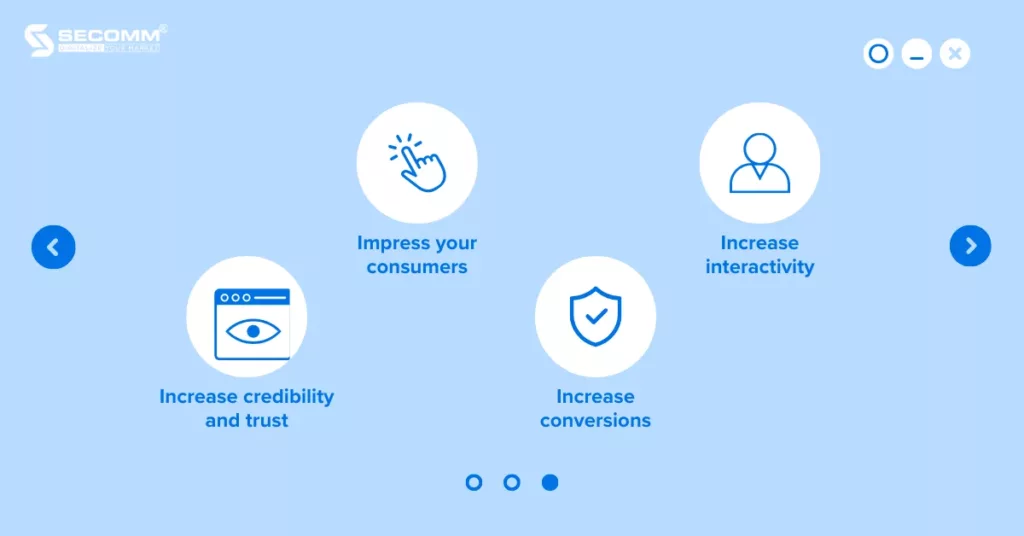
Impress your consumers
Expertly crafted UI/UX design can leave a lasting impact on users when they visit your eCommerce website. In the highly competitive eCommerce landscape, a remarkable UI/UX design can set your business apart and create a distinctive identity among market rivals.
Increase interactivity
Effective UI/UX design can help you enhance your interaction capabilities with consumers. For example, creating social media sharing buttons, user reviews, and intuitive search tools can streamline the customer’s journey to products and more.
Increase credibility and trust
A professional UI/UX design helps you establish trust with customers and cultivate a positive brand image. By offering clear security information, SSL certificates, and secure payment procedures, you can instill confidence in customers while mitigating the risks of personal data breaches and financial fraud.
Increase conversions
Starting with an investment in UI/UX design helps convert potential customers into actual customers. Through data analysis and user feedback, businesses can gain a deeper understanding of customer behavior and make interface adjustments to improve the user experience and overall business performance.
Related article: The 10 biggest eCommerce trends set to dominate in 2023
Top 10 UI/UX design trends
Dark Mode
Although the Dark Mode design trend isn’t new to website developers, it continues to be popular in 2023. The option to switch between light and dark modes offers users more flexibility when visiting an eCommerce website. Dark Mode enhances the browsing experience, especially for users who spend extended hours in front of screens. Furthermore, it can contribute to saving battery life on mobile devices or screens equipped with OLED displays.

3D Design
The 3D design trend is gaining more popularity in UI/UX design. 3D elements bring depth and realism to website interfaces, making them visually appealing and improving user interaction. UI/UX designers frequently utilize 3D elements for website components like CTA buttons, icons, banners, and backgrounds, or employ 3D animations for feedback and transition effects, creating a more engaging user experience that fosters a visual connection with users.
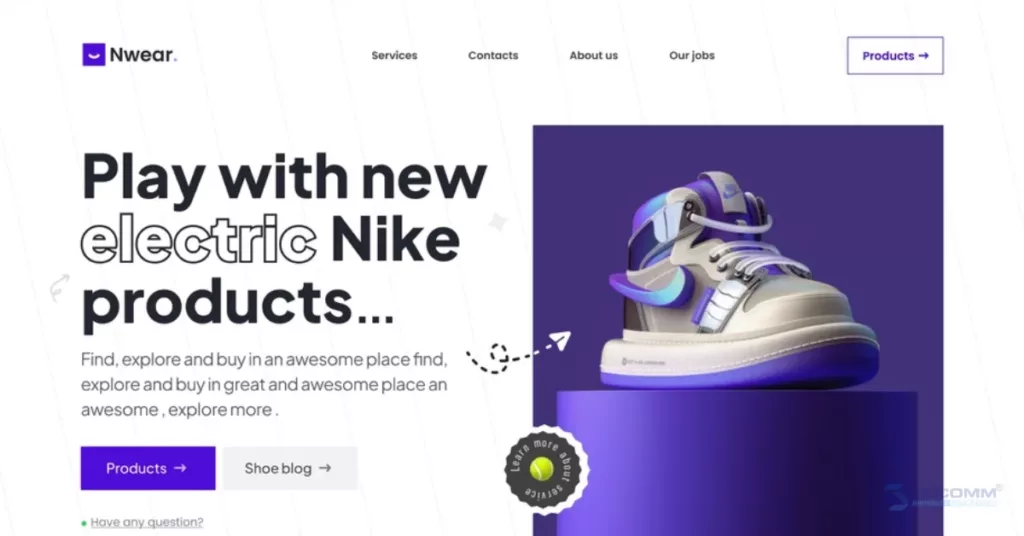
Neomorphism
Neumorphism is a design trend that blends aspects of both skeuomorphism and flat design. It creates a 3D effect by using shadow and highlight effects to achieve a sleek, modern look for websites. However, UI/UX designers must be cautious not to overuse neumorphism, as it can result in a cluttered, confusing interface or create effects contrary to what a business intends to convey.

Modern Minimalism
Modern Minimalism represents a UI/UX design trend that centers on crafting straightforward, user-friendly interfaces by removing extraneous elements and highlighting vital content. This style combines simplicity with modernity, providing users with a refined and user-friendly experience. The main challenge in implementing Modern Minimalism is finding the balance between simplicity and aesthetics, ensuring that the design remains both visually appealing and easy for users to navigate.
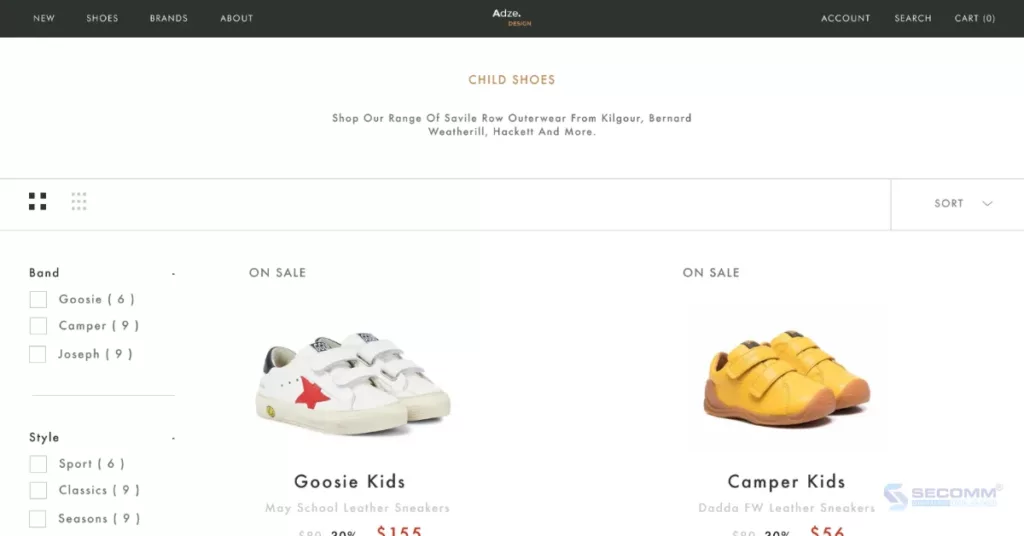
Dynamic Gradient
Dynamic Gradient is a design trend that produces color gradient effects that adapt according to user interactions or the time of day. It can offer users a more personalized and sophisticated experience. However, when implementing Dynamic Gradient in UI/UX design, it’s crucial for designers to strike a balance so that color intensity doesn’t become overpowering and doesn’t compromise readability.

Voice Interface
Voice Interface represents a UI/UX design trend where users can interact with an eCommerce website system using voice commands rather than traditional input methods such as keyboards, mice, or touchscreens. Voice Interface employs voice recognition technology to comprehend and respond to user commands, requests, or queries. In UI/UX design, Voice Interface introduces a fresh and user-friendly mode of interaction, thereby unlocking a plethora of opportunities for tailoring the user experience and delivering personalized services.

Micro-interactions
Micro-interactions are a design style that incorporates small elements, including subtle animations, specific sound effects, image responses to user actions or voice commands, and more, to create an engaging experience and enhance interaction on a website. Micro-interactions can also help guide users through the website interface effortlessly. When applying Micro-interactions, UI/UX designers need to ensure they won’t distract or annoy users.
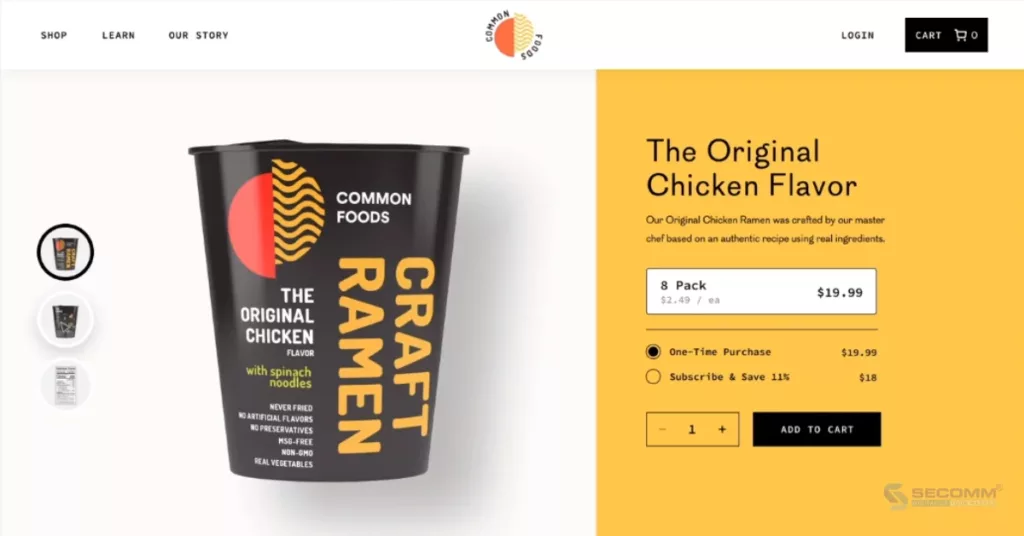
Augmented reality (AR)
Augmented reality (AR) is becoming increasingly popular in the UI/UX design community, especially in eCommerce websites related to technology, interior design, cosmetics, gaming, and more. AR allows users to interact with products/services as if they were in the real world, bridging the gap between online and offline shopping. However, due to its advanced technology, AR can sometimes pose challenges for older or less tech-savvy customers. Therefore, when designing the UI/UX, businesses must ensure that AR elements are intuitive and user-friendly.

Asymmetric Layouts
Asymmetric Layouts is a UI/UX design trend where elements and components aren’t arranged in the traditional symmetrical structure. Instead, elements are placed asymmetrically and inconsistently, creating a sense of balance and noticeable uniqueness in the design.
The strength of Asymmetric Layouts lies in their ability to capture users’ attention and create a distinctive experience through images and emphasis on essential content. However, when using Asymmetric Layouts, it’s essential to consider ensuring that the eCommerce website interface remains user-friendly, easy to navigate and maintains its aesthetic appeal.

Data Visualization
Data Visualization is a design trend that involves presenting complex data in a clear and visual manner using graphs, charts, and images. In UI/UX design, Data Visualization is used to transform intricate information into engaging visuals, simplifying data comprehension and interaction for users.
Therefore, when incorporating Data Visualization into UI/UX design, it’s essential to carefully choose appropriate data representation methods, utilize colors and graphical elements effectively, and ensure information is conveyed clearly and attractively.
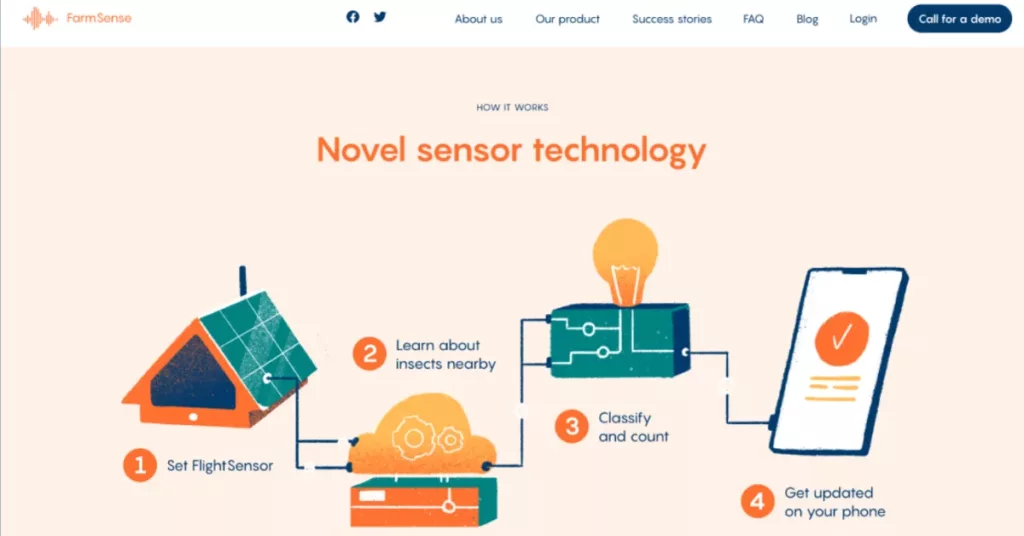
Those are the top 10 UI/UX design trends for eCommerce website in 2023. We hope that the valuable information in this blog will help you choose your best-fit style that conveys your brand’s essence.
Contact us now or call directly to the SECOMM hotline at (028) 7108 9908 for eCommerce consulting and implementation.
 2
2

 10,196
10,196

 0
0

 1
1
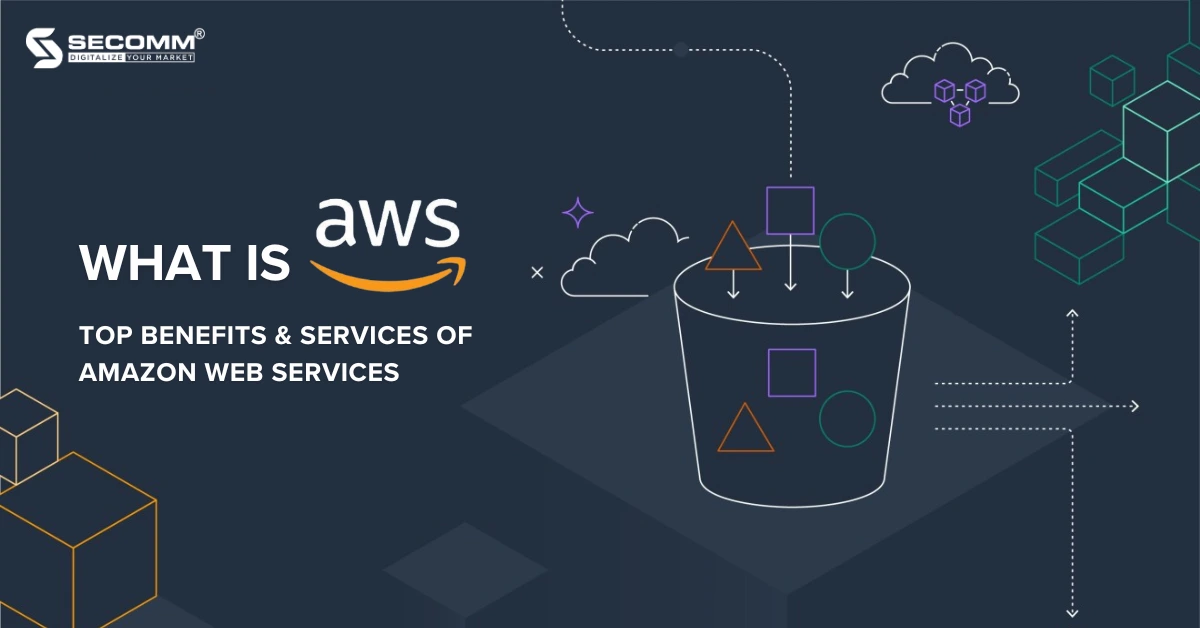
WHAT IS AWS? TOP BENEFITS & SERVICES OF AMAZON WEB SERVICES
In the cloud infrastructure service market, there are many large enterprises, but the first name that comes to mind for large enterprises is AWS.
What is AWS?
AWS (Amazon Web Services) is a cloud solution developed by the “giant” Amazon, trusted by millions of businesses, including fast-growing startups, colossal corporations and top-tier government agencies.
At present, AWS provides a comprehensive array of over 200 fully-featured services, accessible from data centers scattered across the globe. These services encompass blockchain, cloud computing, DevOps, storage, backup, recovery, and more.
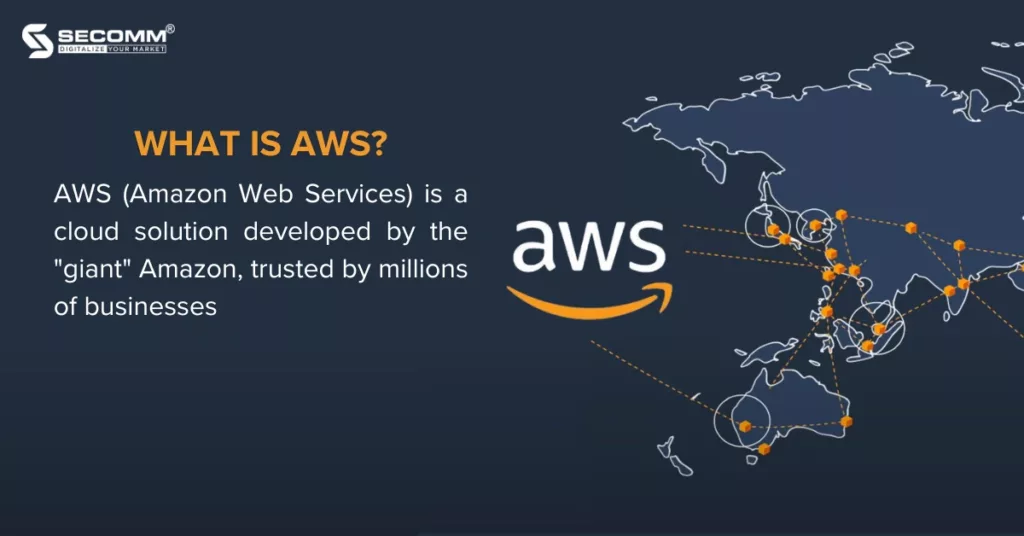
According to estimates published by the Synergy Research Group, Amazon’s market share surged to 32% during the initial quarter of 2023, maintaining its lead in the global cloud infrastructure market and surpassing all other tech titans, including Microsoft Azure, Google Cloud, Alibaba Cloud, IBM Cloud, Salesforce, Oracle, and Tencent Cloud
Benefits of deploying AWS
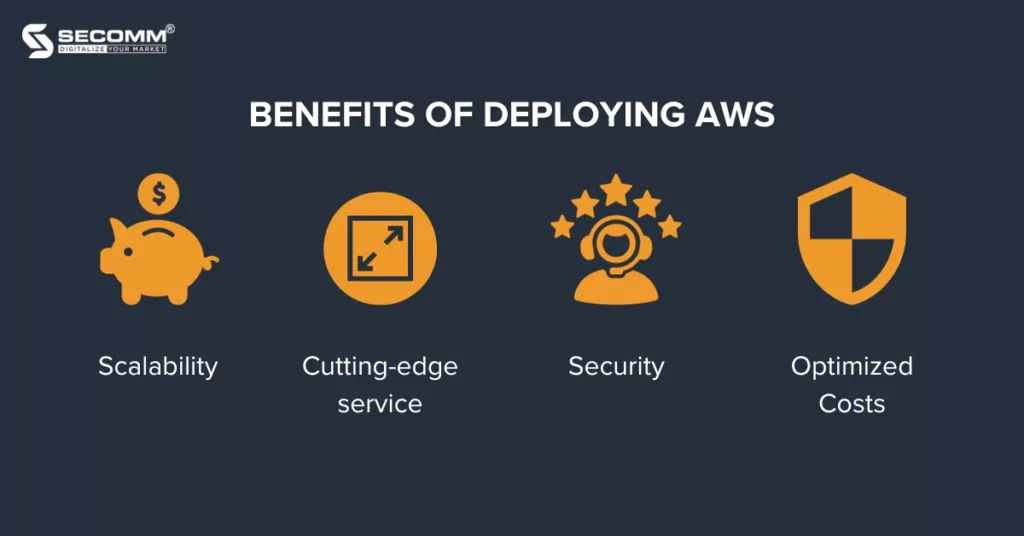
Scalability
AWS provides flexible scalability, enabling businesses to adjust resources according to their needs, whether it involves scaling up to handle high traffic or accommodating growth, all without the need for investments in physical infrastructure.
Moreover, AWS offers effortless integration with various services and technologies through APIs and management tools. This allows AWS to seamlessly integrate its applications with third-party services and incorporate new technologies into the existing system.
Cutting-edge service
With AWS, businesses can leverage cutting-edge technologies to experiment and innovate more swiftly. Since its inception, AWS has consistently introduced novel technologies that businesses can utilize for their digital transformation.
For example:
Back in 2014, AWS led the way in serverless computing with the introduction of AWS Lambda, enabling developers to execute code without the need to provision or manage servers.
In 2017, AWS launched Amazon SageMaker, a managed machine learning service that empowers both developers and data scientists, regardless of their prior experience.
Security
AWS employs an end-to-end approach to secure and fortify its infrastructure, encompassing physical systems, operational systems, and software. AWS adheres to international security standards, offering compliance checks for rules and regulations such as:
- ISO/IEC 27001: The foremost international standard for information security management.
- ISO 9001: A quality management system standard developed and issued by the International Organization for Standardization.
- PCI DSS: A mandatory information security standard for businesses involved in storing, transmitting, and processing payment card data, overseen by five international payment organizations, including Visa, MasterCard, American Express, Discover, and JCB.
Furthermore, AWS extends support to various other security standards and compliance certifications such as CSA, ISO 27017, ISO 27018, SOC 1, SOC 2, SOC 3, and more.
Optimized Costs
AWS employs a pay-as-you-go payment model, allowing businesses to use resources as needed without overspending their budgets.
Furthermore, AWS has earned the trust of many large enterprises due to its optimized costs. For instance, when businesses commit to using an AWS service or a bundle of services up to a specific monetary threshold (measured in USD per hour) over a 1 or 3-year duration, AWS offers more cost-effective solutions than the On-Demand pricing.
Furthermore, businesses can receive volume-based discounts based on the amount of services and resources they utilize within AWS. For example, in the case of Amazon S3, pricing is tiered, meaning the more a business uses, the less it pays per GB.
AWS key services
AWS offers a range of cloud services, below are some key AWS services:
Amazon EC2
Amazon EC2 (Amazon Elastic Compute Cloud) is a flexible cloud computing service that provides virtual servers for running applications. It allows businesses to rent and manage virtual machines to meet their specific needs.
Use cases for Amazon EC2:
- Running cloud-based and on-premises applications: Amazon EC2 provides secure, reliable, high-performance, and cost-effective computing infrastructure to meet business needs.
- Scaling for High-Performance Computing (HPC) applications: Access infrastructure and compute power on-demand to run HPC applications faster and cost-effectively.
- Developing Apple platforms: Build, test, and validate macOS workloads on-demand. Access environments in minutes, dynamically adjust capacity as needed, and benefit from AWS’s pay-as-you-go pricing model.
- Training and deploying Machine Learning (ML) applications: Amazon EC2 offers a collection of computing services, network connectivity (up to 400 Gbps), and specialized storage to optimize price performance for ML projects.

Amazon Simple Storage Service (S3)
Amazon Simple Storage Service (S3) is a cloud storage service that enables businesses to easily store and access data with durability and high reliability.
Use cases for Amazon S3:
- Building a data lake: Run big data analytics, artificial intelligence, machine learning, and high-performance computing applications to unlock deep insights from your data.
- Backup and recovery of critical data: Meet Recovery Time Objectives (RTOs), Recovery Point Objectives (RPOs), and compliance requirements with S3’s robust replication features.
- Cost-effective data storage: Transition data storage to Amazon S3 Glacier storage classes to minimize costs, eliminate operational complexity, and gain new deep insights.
- Running cloud-native applications: Build rapidly deployable, highly mobile, and web-based cloud-native applications that can automatically scale to meet high-demand configurations.

Amazon Aurora
Amazon Aurora is a high-performance managed relational database service built with compatibility for MySQL and PostgreSQL, outperforming other relational database management systems.
Use cases for Amazon Aurora:
- Modernize enterprise applications: Operate enterprise applications like Customer Relationship Management (CRM), Enterprise Resource Planning (ERP), supply chain, and payments with high availability and performance.
- Build SaaS applications: Support reliable, high-performance Software as a Service (SaaS) applications with the ability to scale version and storage capacity flexibly.
- Deploy globally distributed applications: Develop large-scale internet applications, such as mobile games, social networking apps, and online services, requiring scalability and recovery in multiple regions.
- Serverless technology applications: No need to manage capacity manually and only pay for the capacity used, with instant and detailed scalability to save up to 90% on costs.
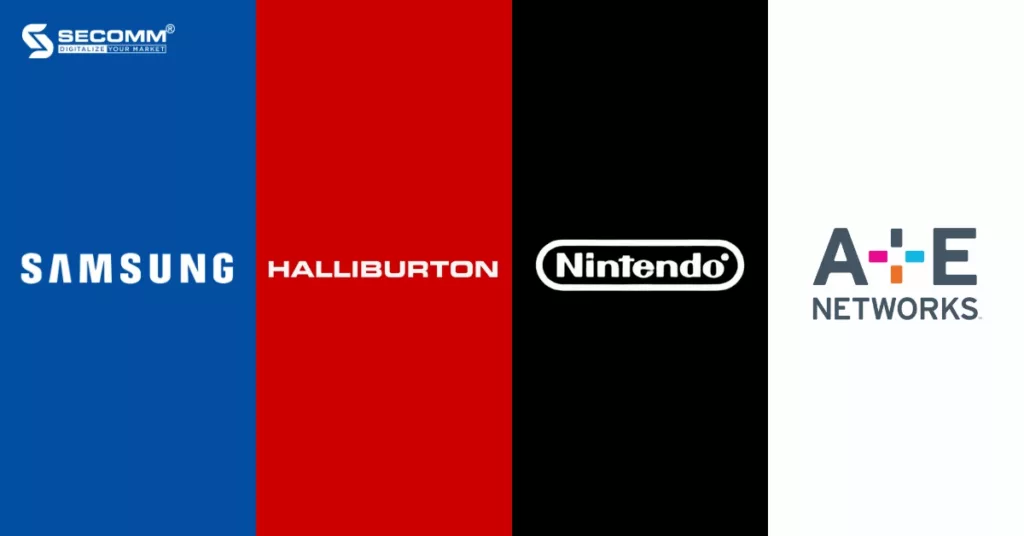
Amazon DynamoDB
DynamoDB is a NoSQL database designed to handle high scalability and low-latency response time applications. Amazon DynamoDB is fully managed, serverless, and designed to run high-performance applications at any scale.
Additionally, DynamoDB provides integrated security features, continuous backups, automatic multi-region replication, in-memory caching, and data loading and exporting tools.
Use cases for Amazon DynamoDB:
- Software application development: Build large-scale internet applications supporting super content user data and caching requirements with high synchronization and connectivity needs for millions of users and millions of requests per second.
- Create a media super data warehouse: Scale throughput and concurrency for media and entertainment workloads such as real-time live video streaming, and interactive content, while delivering lower latency with multi-region replication across AWS regions.
- Provide a seamless retail experience: Use design templates to deploy shopping carts, workflow tools, inventory tracking, and customer profiles. DynamoDB supports high-access events at a massive scale and can handle millions of requests per second.
- Scale gaming platforms: Focus on innovation without operational overhead. Build your gaming platform with player data, session history, and leaderboards for millions of users simultaneously.
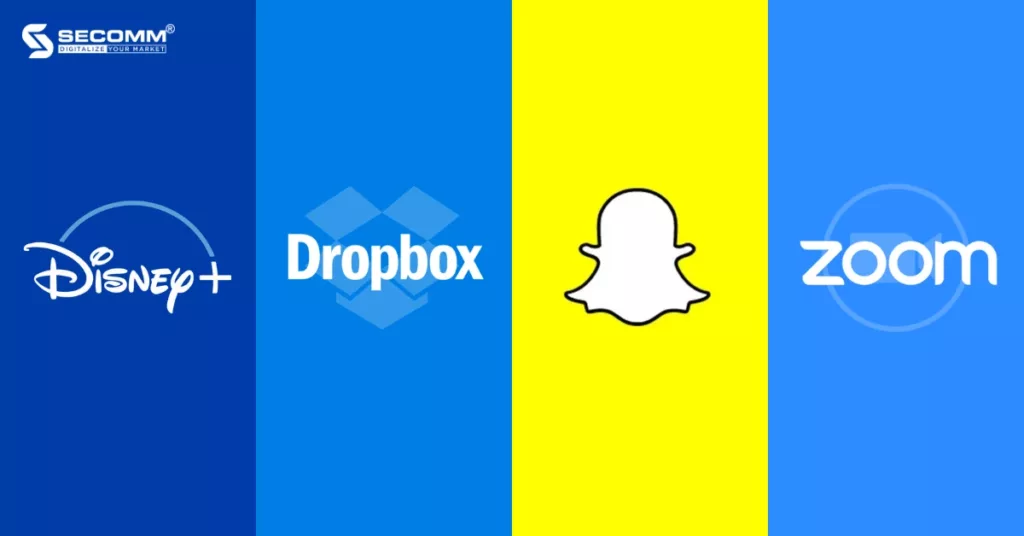
Amazon RDS
Amazon RDS (Amazon Relational Database Service) is a managed relational database service for MySQL, PostgreSQL, Oracle, SQL Server, and MariaDB, designed to set up, operate, and scale relational databases in the cloud with just a few clicks.
Use cases for Amazon RDS:
- Build mobile and web applications: Support developing applications with high availability, throughput, and scalable storage capacity. Take advantage of flexible usage-based pricing policies to suit various types of application usage.
- Migrate to a managed database: Innovate and develop new applications with Amazon RDS instead of worrying about managing your own database, which can be time-consuming, complex, and costly.
- Escape from legacy databases: Free yourself from expensive commercial databases by migrating to Amazon Aurora. When you move to Aurora, you can scale, perform, and make your commercial database highly available at 1/10th the cost.
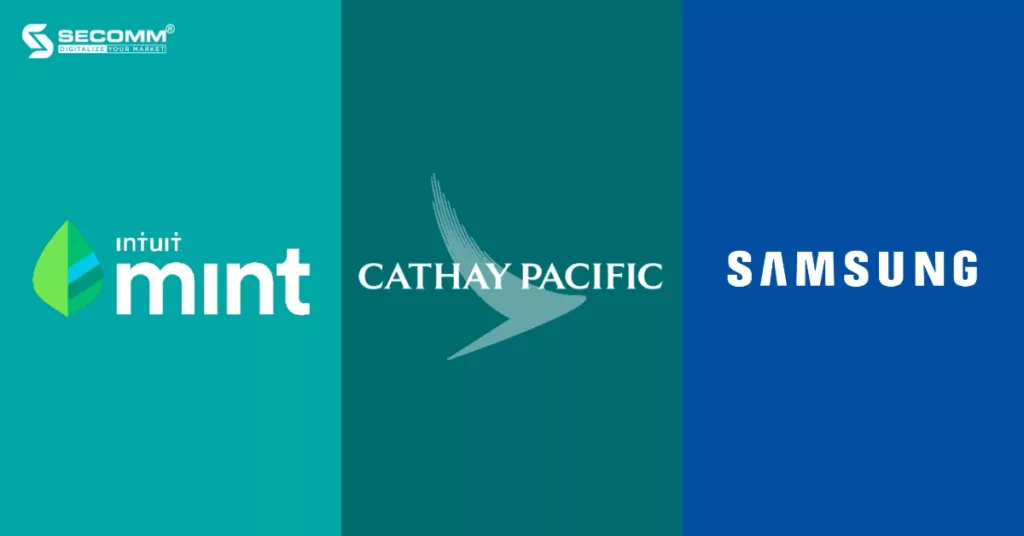
AWS Lambda
AWS Lambda is a serverless computing service that allows businesses to run code without the need to manage servers. AWS Lambda enables businesses to execute code when events occur, optimizing resource usage and reducing costs.
Use cases for AWS Lambda:
- Processing data at scale: Execute code at the capacity you need exactly when it’s required. Scale automatically to match your data volume and trigger custom events.
- Running interactive web and mobile backends: Combine AWS Lambda with other AWS services to create secure, stable, and scalable online experiences.
- Supporting powerful ML insights: Preprocess data before feeding it into your machine learning models. With access to the Amazon Elastic File System, AWS Lambda manages the scaling process and provides infrastructure to simplify scaling adjustments.
- Creating event-driven applications: Build event-driven functions to allow isolated devices to communicate easily with each other. Reduce costs by running applications at maximum demand without incidents or over-provisioning resources.
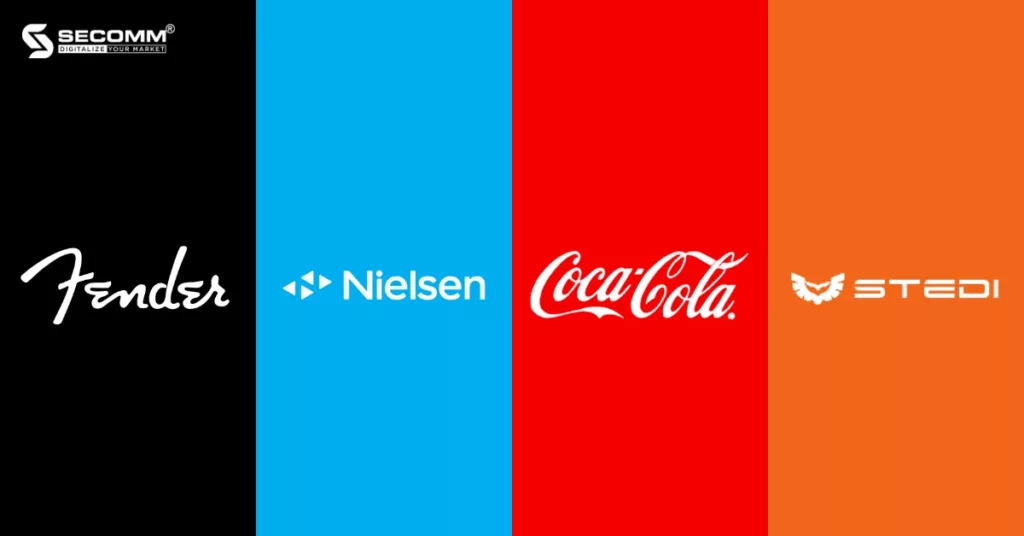
Amazon VPC
Amazon Virtual Private Cloud (Amazon VPC) allows businesses to define and launch AWS resources in a logically isolated virtual network, providing full control over the virtual network environment, including resource placement, connectivity, and security.
Use cases for Amazon VPC:
- Launching a simple website or blog: Enhance the security of your web application by enforcing rules for incoming and outgoing connections.
- Hosting multi-tier web applications: Define connectivity and network constraints between your web servers, application servers, and databases.
- Creating hybrid connections: Build and manage VPC networking compatible with AWS services and your on-premises resources.
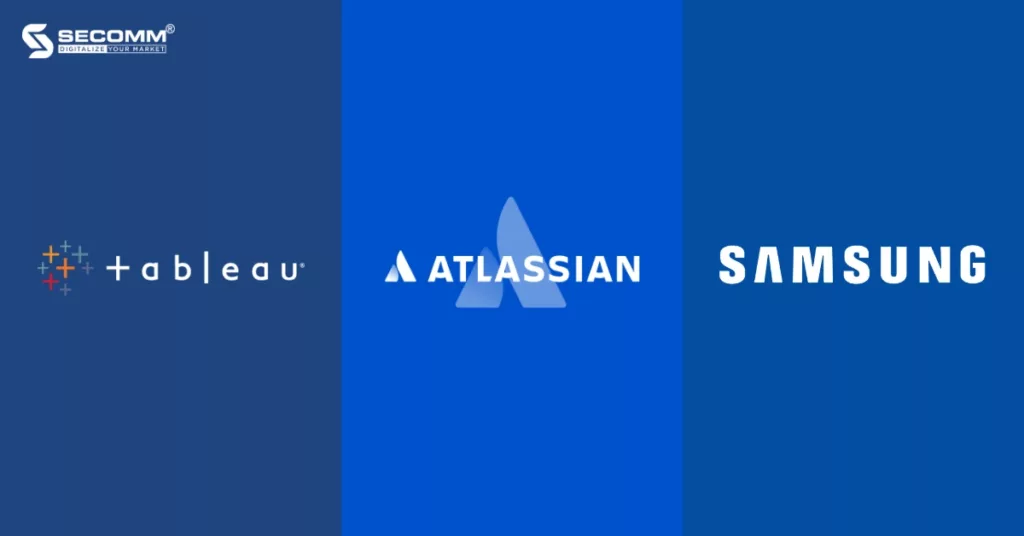
Amazon Lightsail
Amazon Lightsail is an AWS service designed to simplify the deployment and management of applications and websites in the cloud environment. It offers an easy-to-use virtual private server with pre-configured containers, storage capacity, databases, snapshots, and more, all at an affordable monthly price.
Use cases for Amazon Lightsail:
- Launching a simple web application: Use pre-configured development stacks like LAMP, Nginx, MEAN, and Node.js to quickly and easily get your content online.
- Creating custom websites: Build and personalize your personal, e-commerce, or blog website in just a few clicks with pre-configured applications like WordPress, Magento, Prestashop, and Joomla.
- Building applications for small businesses: Kickstart your business software, such as file storage and sharing, backups, financial and accounting software, and more.
- Setting up a testing environment: Easily create, delete, and test development sandboxes and testing environments to experiment with new ideas without risk.
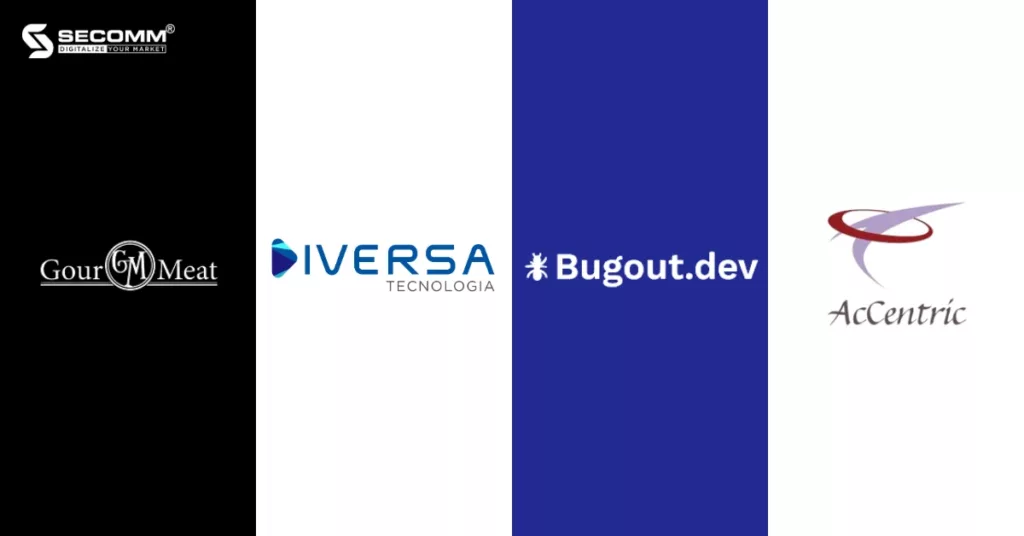
Amazon SageMaker
Amazon SageMaker is a service for building, training, and deploying machine learning models for any use case with fully managed infrastructure, tools, and workflows.
The primary application of Amazon SageMaker is the development of practical machine learning applications, including product recommendations, personalization, smart shopping, robots, and voice-enabled devices.
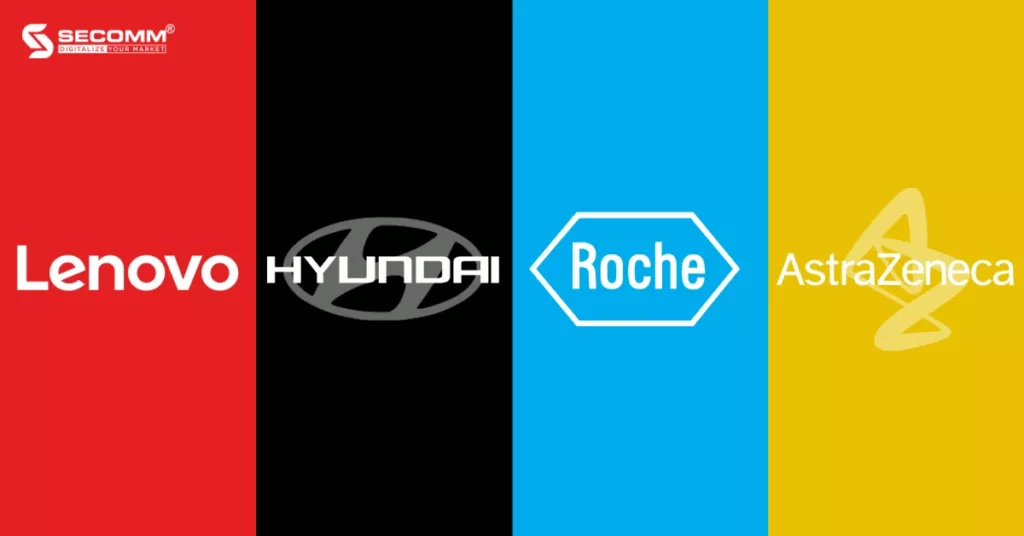
In over 16 years since its establishment to date, AWS has provided cloud services to millions of customers worldwide with a global-scale operational experience. In the near future, AWS may continue to maintain its leading position in this over 60 billion USD market with a market share range of 32-34%.
To learn more about AWS and how to deploy AWS for your business, contact SECOMM or call the Hotline at (02871089908) for a free consultation.
 2
2

 13,350
13,350

 0
0

 1
1
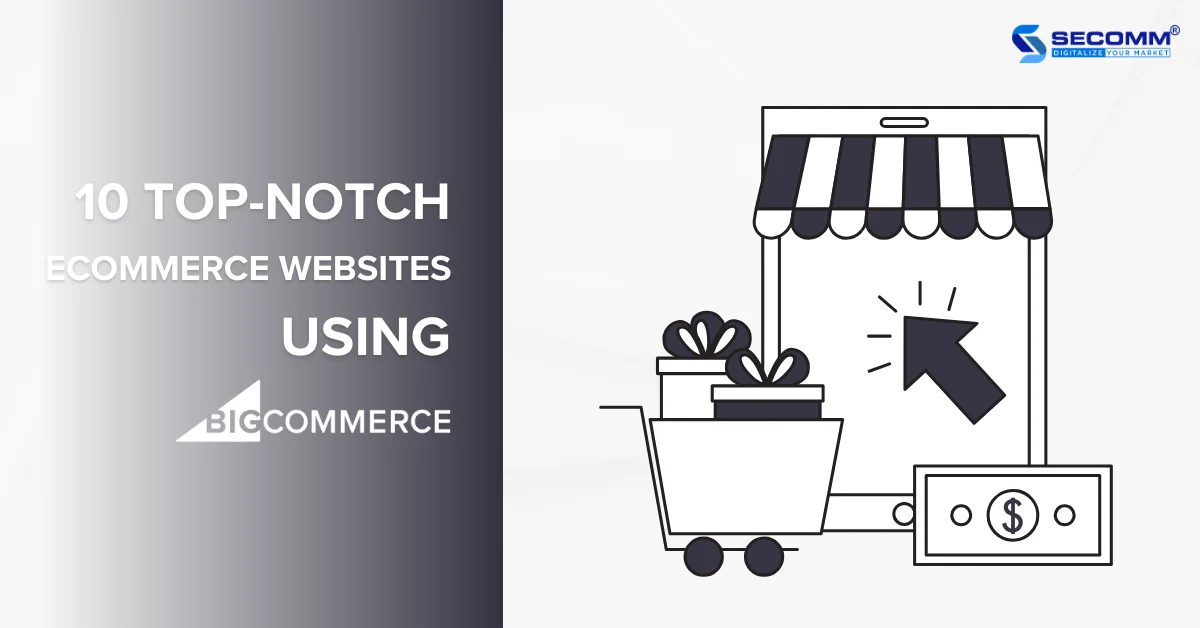
10 TOP-NOTCH ECOMMERCE WEBSITES USING BIGCOMMERCE
In recent years, BigCommerce has achieved a significant milestone as it emerges as one of the preferred platforms for eCommerce website development among numerous online businesses. According to BuiltWith, there are presently 45,952 operational websites utilizing this platform.
This article will highlight 10 notable eCommerce websites from around the world, spanning various industries, that have adopted BigCommerce for their operations.
Skullcandy
Skullcandy opened its first store in 2015 in Park City, Utah, and it remains the company’s exclusive physical retail location in the United States due to its primary online sales strategy. Skullcandy is a technology brand known for crafting headphones and speakers with a youthful and modern style. Their eCommerce website is developed using the BigCommerce platform.
Aside from seasonal promotions, Skullcandy provides customers with diverse payment choices, including PayPal, VISA, MasterCard, and even a Buy Now, Pay Later option through Klarna.
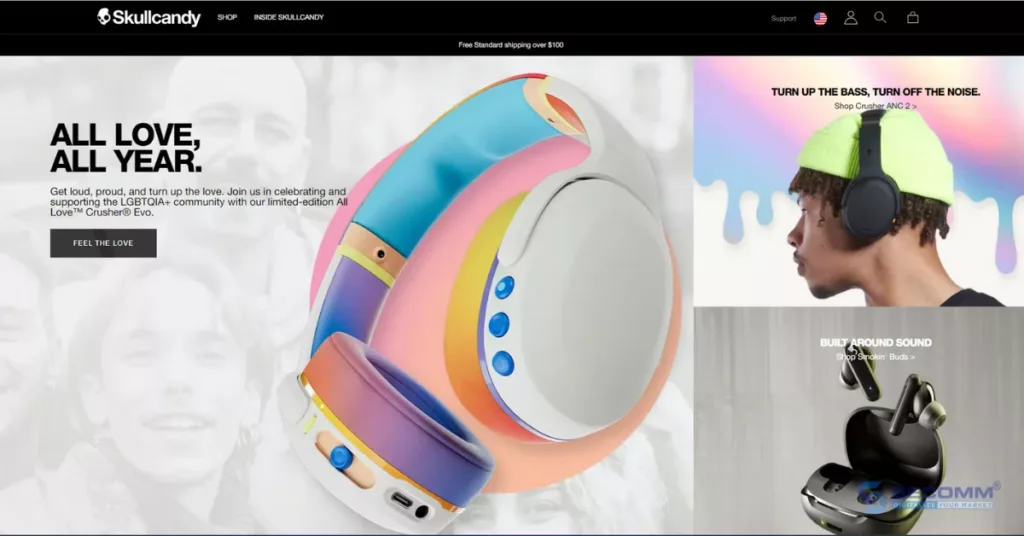
- Industry: Consumer Electronics
- Website: https://www.skullcandy.com/
- Traffic: 1.1M/month
- Ranking: 15,365 (USA) & 58,348 (Worldwide)
BURROW
BURROW is an online furniture brand that specializes in offering seasonal furniture and sofas with a minimalist, modern, and vibrant style. The company’s approach revolves around three key principles to deliver unique value to customers. First and foremost, they have built their eCommerce website on the BigCommerce platform, encouraging online shopping through enticing promotions, illustrative product videos, and free shipping. Secondly, their products are known for their custom designs, high durability, multifunctionality, compactness, portability, and versatility to fit into various spaces. Lastly, BURROW places a strong emphasis on building a community that connects customers from all around and enhancing brand awareness.

- Industry: Furniture
- Website: https://burrow.com/
- Traffic: 699.5K/month
- Ranking: 11,978 (USA) & 64,922 (Worldwide)
LARQ
LARQ is renowned for its stylish and compact reusable water bottles, designed with sustainability in mind. These bottles are manufactured using advanced technologies like PureVis and NanoZero to ensure high water quality. LARQ’s bottles possess self-cleaning capabilities, utilizing UV-C LED lights to eliminate up to 99.99% of bacteria.
These exceptional features led to a significant $1 million investment from Shark Tank. LARQ has developed its eCommerce website using BigCommerce, complete with a dedicated Basq Magazine section where they share valuable insights on hydration with their customers.
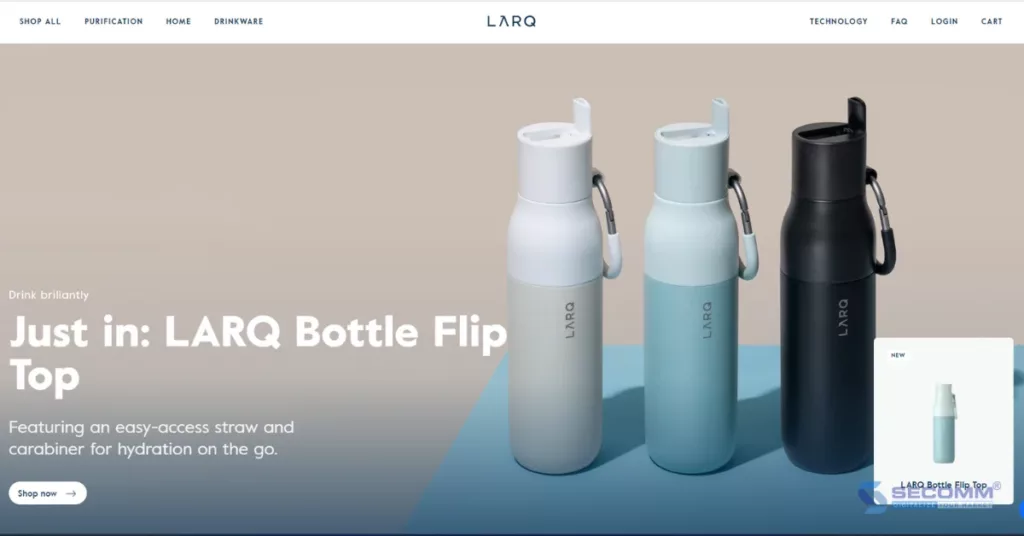
- Industry: Consumer Goods
- Website: https://www.livelarq.com/
- Traffic: 421K/month
- Ranking: 75,050 (USA) & 144,129 (Worldwide)
Molton Brown
The premium beauty brand, Molton Brown, hailing from the UK, has also used the BigCommerce platform to build their eCommerce website. Their product range, spanning fragrances, hand washes, essential oils, scented candles, and bath & body products, is entirely manufactured in the UK and is cruelty-free. Their product packaging is crafted from high-quality reusable glass, adhering to eco-friendly standards.
At present, the company exclusively offers online shopping services to customers in the US, Japan, and the majority of European regions. Molton Brown consistently introduces seasonal collections, special occasion sets, gender-specific product lines, and personalized gift recommendations, simplifying the shopping experience for their customers.

- Industry: Beauty and Personal Care
- Website: https://www.moltonbrown.com/store/index
- Traffic: 219.7M/month
- Ranking: 67,310 (USA) & 223,381 (Worldwide)
Tommie Copper
Tommie Copper is a brand that specializes in offering comfortable, lightweight fashion products designed to reduce pain and aid in functional recovery for both men and women. With a strong emphasis on expanding online sales, the company has invested significantly in its eCommerce website using the BigCommerce platform. They have also implemented various customer engagement programs to encourage more shopping. One notable initiative is the Customer Loyalty Program, featuring three tiers: Score, Performance, and Pro-Grade, with detailed and precise instructions on point accrual and redemption.
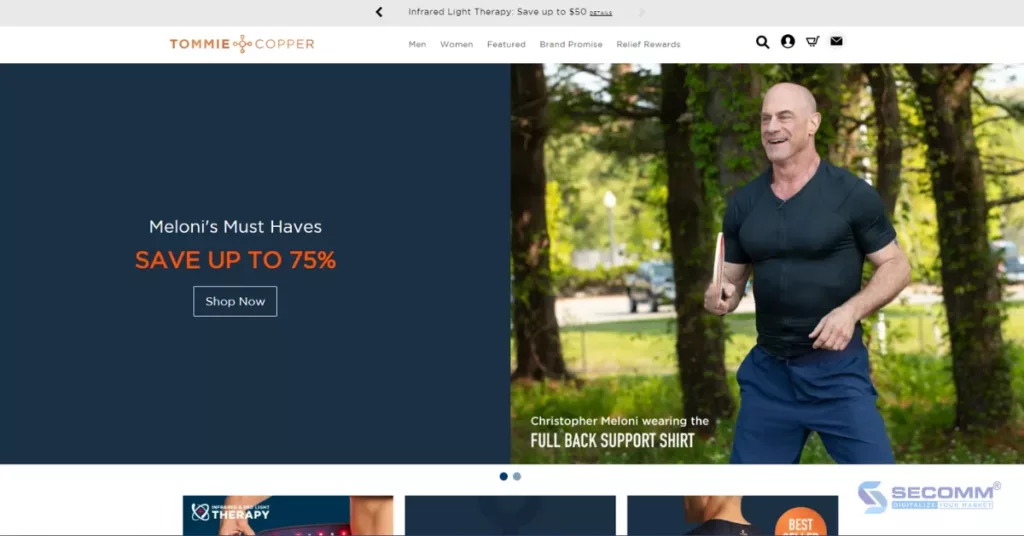
- Industry: Fashion
- Website: https://www.tommiecopper.com/
- Traffic: 217.8M/month
- Ranking: 34,370 (USA) & 202,065 (Worldwide)
Saddleback Leather
Saddleback Leather is a company specializing in handcrafted leather goods, and they develop their eCommerce website with BigCommerce. Their product range is extensive, encompassing items such as bags, backpacks, belts, and even intricately designed mouse pads. Visitors to their website are greeted with a distinct “Texan” design aesthetic and captivating narratives. Notably, customers can also become part of the Saddleback Club, granting them access to exclusive and appealing member-only offers.

- Industry: Leather Goods and Accessories
- Website: https://saddlebackleather.com/
- Traffic: 167.4M/month
- Ranking: 64,319 (USA) & 266,752 (Worldwide)
Barron Designs
Barron Designs stands as a top-tier brand specializing in the design and provision of premium interior and exterior products crafted from high-quality materials like wood, tiles, and stone. Their diverse product range includes wooden doors, stone fireplaces and chimneys, mailbox posts, engineered wood panels, and more. Barron Designs has developed its eCommerce website using the BigCommerce platform, offering a multitude of features to ensure the best shopping experience for customers.
When customers browse and click on their favorite products to view details, they can choose colors and select options such as fire resistance and UV protection before placing an order. The production and delivery times typically range from 2 to 4 weeks. For those interested in sampling a product, they can simply click on the option, and a complimentary mini-size sample will be sent to their doorstep. Furthermore, a discount coupon will be emailed to encourage customers to make a full-size purchase.

- Industry: Interior and Exterior Interior Design & Construction
- Website: https://www.barrondesigns.com/
- Traffic: 138.5M/month
- Ranking: 63,234 (USA) & 365,842 (Worldwide)
SugarBoo & Co
SugarBoo & Co is a well-known BigCommerce eCommerce website that offers a wide range of handmade products for personal and household use. It offers a diverse range of handmade products for both personal and household use, including items like notebooks, decorative pieces, ceramic dishes, baby toys, and more. To provide an excellent online shopping experience, the company offers multiple payment methods, including well-known options like ShopPay and AfterPay.
SugarBoo & Co’s blog section is filled with interesting content, regularly sharing tips on gift selection, the advantages of using ceramic products, home decorating ideas, and more. Plus, during special occasions and holidays, the website provides customers with a selection of discounted shopping suggestions.
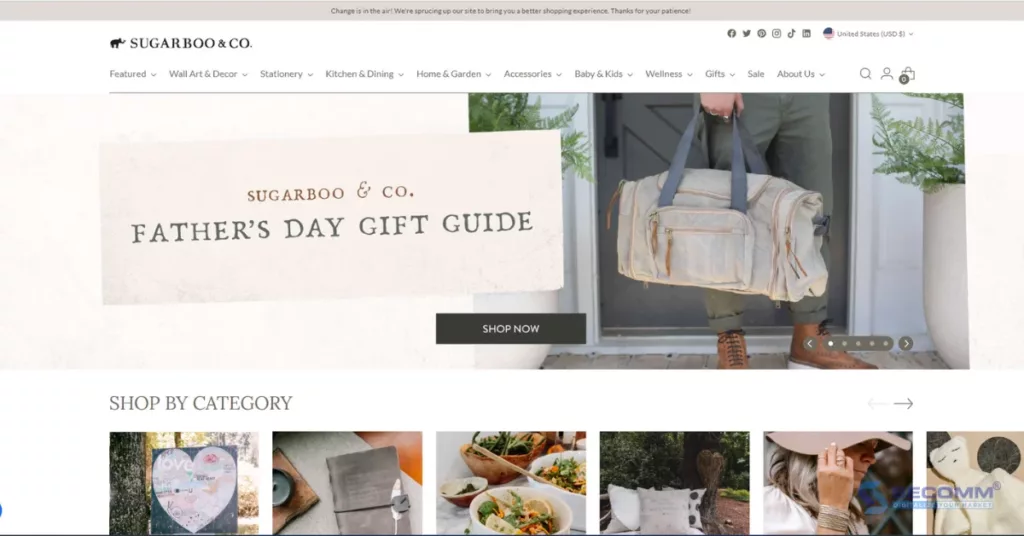
- Industry: Retail
- Website: https://sugarbooandco.com/
- Traffic: 43.3M/month
- Ranking: 341,993 (USA) &934,576 (Worldwide)
Autograph Foliages
Autograph Foliages is a prominent brand in the United States, specializing in landscaping solutions for both homes and commercial establishments. The company offers a diverse range of collections, including seasonal and holiday-themed foliage like Christmas decorations, catering to the needs of families and businesses. What sets Autograph Foliages apart is its enduring partnerships with major entities such as Walt Disney World, Universal Studio, Warner Bros, and Seaworld Parks & Entertainment, a testament to the superior quality of its foliage products.
Their website, developed on the BigCommerce platform, prominently displays new and seasonal products. To access the pricing details for specific items, customers must register an account on the website. They can also subscribe to receive weekly newsletters containing valuable tips on plant care, decoration, and more.
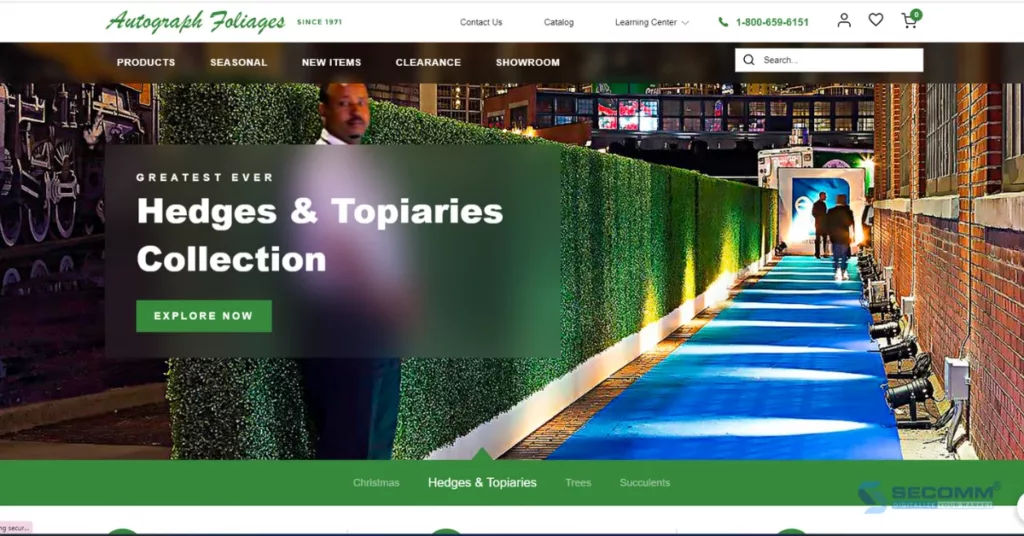
- Industry: Artificial Plants and Trees
- Website: https://autographfoliages.com/
- Traffic: 24.9K/month
- Ranking: 260,791 (USA) & 1,441,394 (Worldwide)
Body Bliss
Established in 1999 and officially launched its products in 2000, Body Bliss specializes in a wide range of personal care items. With over two decades of development, the company has continually researched and refined its products to prioritize customer health, using gentle and environmentally friendly ingredients.
Body Bliss’s BigCommerce website follows a minimalist design, featuring well-organized product categories for easy customer navigation. The site also offers appealing incentives such as complimentary gifts and free shipping. Furthermore, the company uses Instagram to engage with customers and it is seamlessly integrated into the website to keep customers updated on the latest updates.

- Industry: Cosmetics
- Website: https://bodybliss.com/
- Traffic: 7.1K/month
- Ranking: 3,416,815 (USA) & 9,843,202 (Worldwide)
This is SECOMM’s summary and review of 10 eCommerce websites that have achieved success using the BigCommerce platform, effectively capturing customers and leading in their industries.
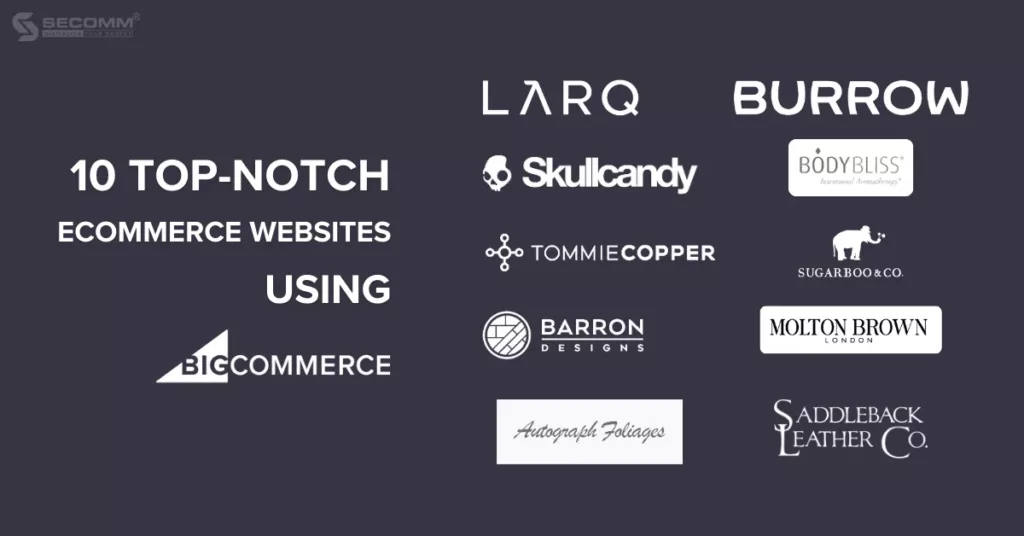
Related content: BigCommerce 2023: Pricing, Features, Pros and Cons
With a wealth of experience helping clients in various countries deploy eCommerce, SECOMM specializes in providing consulting services with professional eCommerce deployment solutions.
Get in touch with SECOMM or call the hotline at 02871089908 today to receive free support and expert guidance.
 2
2

 3,353
3,353

 0
0

 1
1
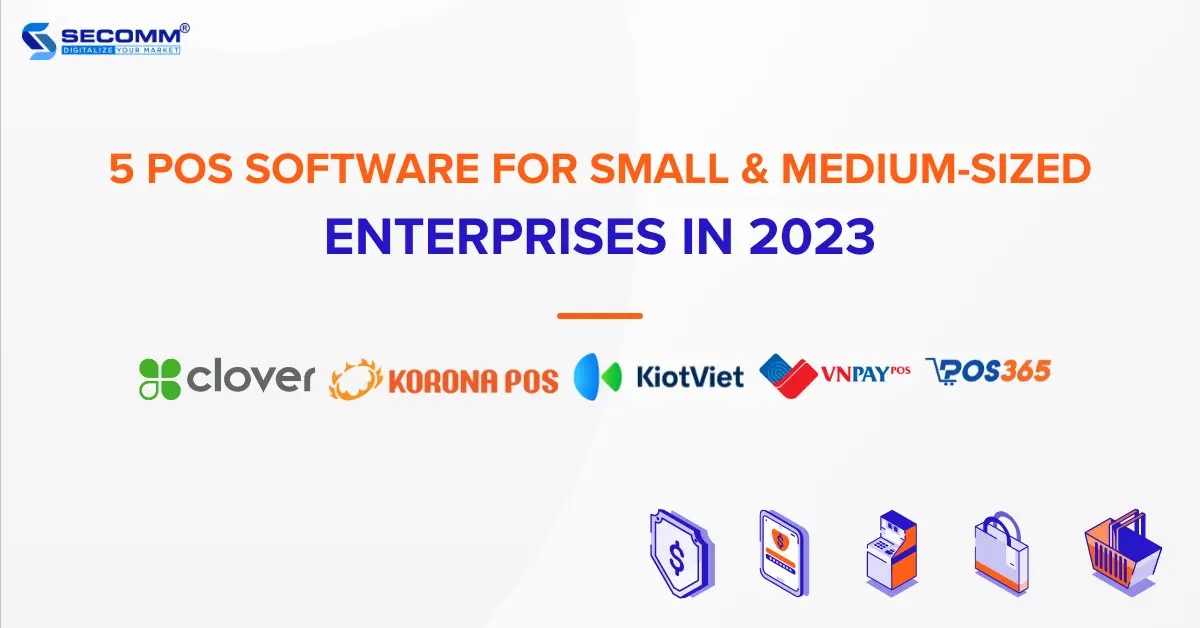
5 POS SOFTWARE FOR SMALL & MEDIUM-SIZED ENTERPRISES IN 2023
Point of Sale (POS) is a system employed by businesses to handle sales transactions, monitor inventory levels, manage customer relationships, generate revenue reports, and conduct business analysis, among other functions. By implementing POS, businesses, particularly SMEs, gain a comprehensive understanding of their operational activities and streamline their management processes.
In this article, SECOMM will evaluate and compare the five most widely-used POS software solutions among small and medium-sized enterprises, including Clover, KORONA POS, KiotViet, and POS365.
Clover
Clover is a POS software developed by Clover Network Inc, aimed at offering an integrated solution for handling sales and payments for both small and medium-sized businesses. Clover provides POS solutions across various industries, including restaurants, services, retail, and more. Specifically, the costs associated with implementing Clover’s POS for retail SMEs are categorized into three primary packages:
- Starter: $799 + $14.95 per month (One-time payment option available) or $60 per month (Monthly payment option) – This package includes an 8″ merchant-facing POS.
- Standard: $1,799 + $49.95 per month (One-time payment option available) or $135 per month (Monthly payment option) – This package includes a 14″ merchant-facing POS
- Advanced: $2,398 + $64.90 per month (One-time payment option available) or $185 per month (Monthly payment option) – This package includes a 14″ merchant-facing and a handheld POS.
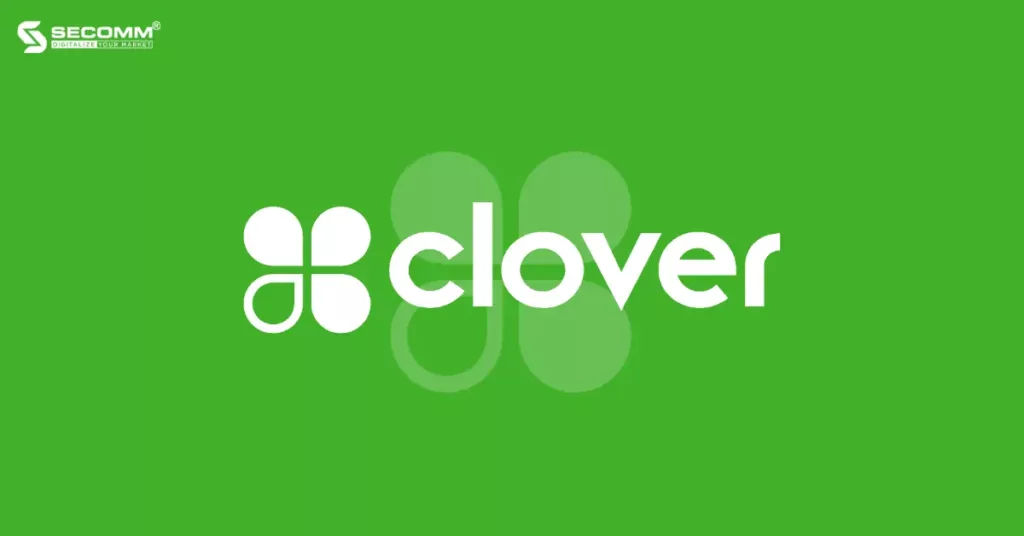
Pros
Ease of Use: The Clover interface is intuitive and user-friendly, making it easy to navigate on the touchscreen and access system functions.
Customization: Users have the flexibility to tailor the interface and configure the system to meet their individual needs. This includes modifying screen layouts, customizing function buttons, and setting options to align with specific business operations.
Offline Support: Clover is equipped to function offline, a valuable feature in the event of an internet connection disruption. Transaction data is securely stored and automatically synchronized once connectivity is restored, ensuring uninterrupted business operations.
Cons
High Initial Costs: Clover carries a higher initial price tag compared to alternative POS solutions, particularly for businesses choosing the comprehensive payment package. This may pose a barrier for smaller businesses operating with limited financial resources.
Invoice Formatting Limitations: Clover has some limitations regarding invoice formatting and customization, which can pose challenges for businesses with specific requirements for invoice formats and content. For example, adding special liquor consumption taxes, collecting stamps on invoices for grocery stores, and so on.
Rely on the Clover Ecosystem: Clover POS functions optimally within the Clover ecosystem and may not seamlessly integrate with diverse management systems such as CRM, ERP, etc., offered by different brands.
Korona POS
KORONA POS is a retail system developed by KORONA, intended to assist in sales management, payments, and inventory control for small and medium-sized businesses.
Currently, KORONA POS offers a range of solution packages for businesses to select from:
- Core: $59 per month – Suitable for small businesses or individuals managing a single store.
- Advanced: $69 per month – Geared towards small and medium-sized businesses handling a single store and inventory tracking.
- Plus: $89 per month – Ideal for small and medium-sized businesses managing multiple stores and keeping track of inventory.
- Enterprise: Custom Quote – Tailored for medium-sized businesses with specific customization requirements.
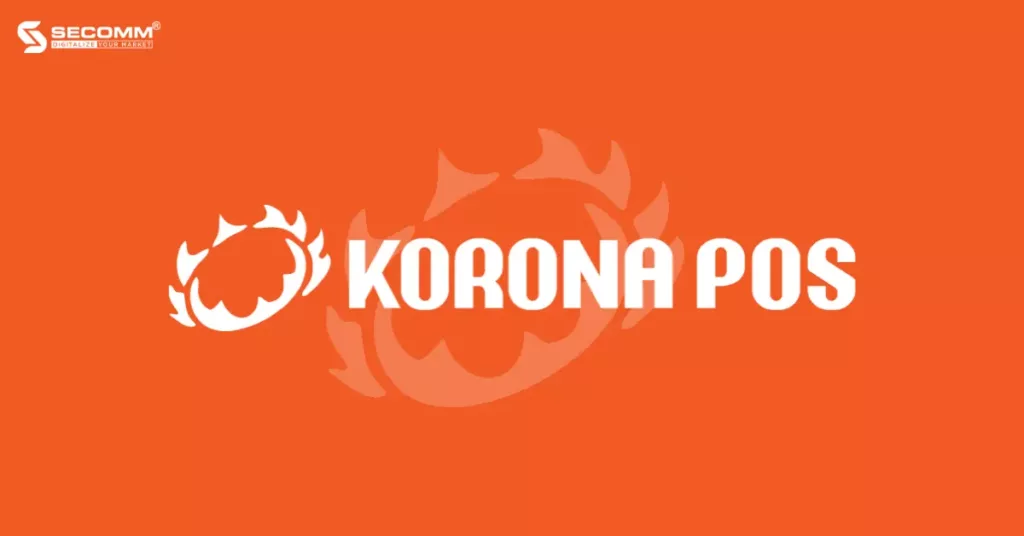
Pros
User-Friendly Interface: KORONA POS boasts a straightforward and user-friendly interface, ensuring ease of use even for employees lacking prior experience with POS systems.
Regular Updates and Upgrades: KORONA POS offers frequent updates and improvements to enhance its features and resolve issues, all while ensuring uninterrupted daily business operations.
Cross-Platform Compatibility: KORONA POS is compatible with multiple platforms, including desktops, laptops, tablets, and smartphones. This flexibility enables sales staff to process transactions and manage sales from virtually any location.
Cons
Internet Required: KORONA POS relies on a continuous internet connection to operate. Disruptions in the network connection can lead to interruptions or even render transactions and management tasks impossible.
Vendor Risk: When businesses adopt KORONA POS, they become reliant on the vendor for system maintenance and upgrades. Any issues or service deviations from the vendor can have an impact on the business’s operations.
POS System Migration Challenges: If a business has been using a different POS system and intends to switch to KORONA POS, the transition process can be intricate and may require a significant investment of time, effort, and resources to migrate all data effectively.
KiotViet
KiotViet is a business management and retail point-of-sale system catering to retail stores and restaurants. KiotViet provides an array of sales management features and tools, encompassing payment processing, inventory control, customer management, order handling, delivery, reporting, and business analysis.
KiotViet offers three options for implementing their POS system:
- Support: 200,000 VND per store per month – Ideal for small businesses, startups, or online retailers.
- Professional: 270,000 VND per store per month – Tailored for professional business models.
- Premium: 370,000 VND per store per month – Suited for businesses with multiple sales channels or a larger staff.
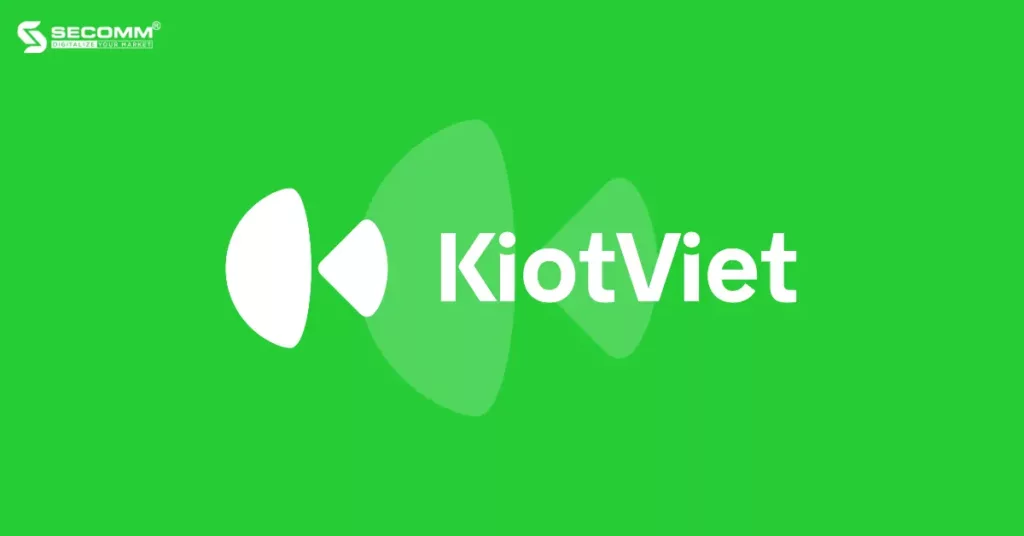
Pros
Ease of Use: KiotViet has a user-friendly interface with tailored support for Vietnamese users, eliminating the need for extensive technical expertise during setup and operation.
Seamless Integration: KiotViet offers flexible integration with various peripherals like printers, barcode scanners, payment devices, and other applications such as inventory management, HR management, and financial systems. This results in a comprehensive POS system for effective business management.
Efficient Inventory Management: KiotViet facilitates efficient inventory management, simplifying the process of updating product information and merchandise categories. Therefore, businesses can maintain control over inventory levels, monitor stock movements, and ensure on-time product availability.
Cons
License fee: KiotViet necessitates monthly or yearly license fee, which may pose challenges for small or recently formed businesses operating with limited funds.
Limited customization: While KiotViet provides some customization options, the capacity for complex customization to cater to individual business requirements may be limited.
Limitations in Niches Industries: KiotViet primarily targets retail and restaurant businesses, which implies that certain features or management procedures may not be well-suited or could be restricted for niche industries such as electronics, pets, agriculture, and others.
VNPAY-POS
VNPAY-POS, an ‘All-in-one’ solution developed by VNPAY, consolidates numerous features into a single device to comprehensively fulfill a business’s sales and payment management requirements.
VNPAY currently extends two primary options to businesses and organization using VNPAY-POS:
- Free service usage for businesses/organizations with payment fees exceeding 275,000 VND/month. For payments lower than this threshold, a flat fee of 275,000 VND/month/machine is applicable.
- Device rental is available at an affordable rate of just 165,000 VND/month. Businesses/organization achieving payment volumes surpassing 30,000,000 VND/month/machine qualify for free device rental.
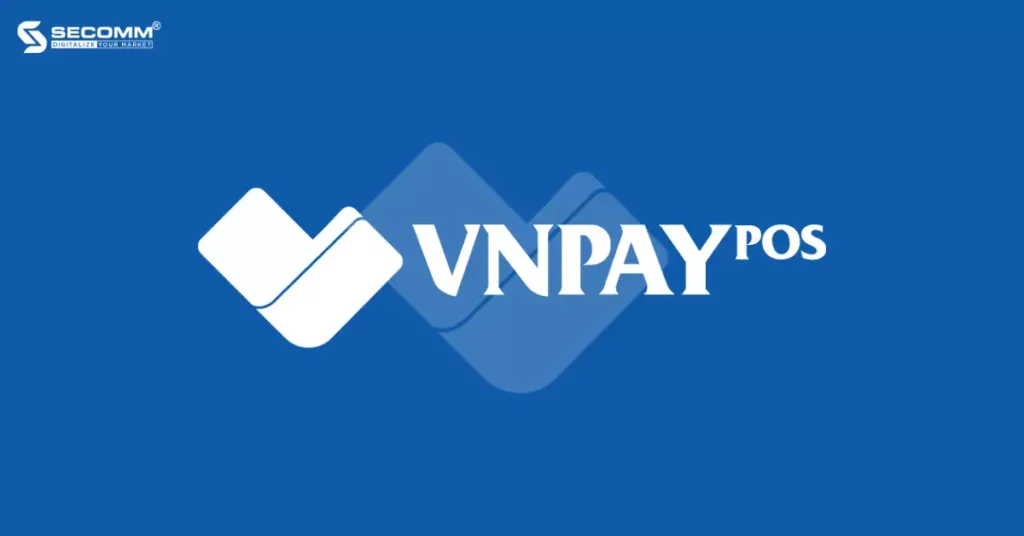
Pros
Diverse Payment Methods: VNPAY-POS allows businesses and individuals to accept payments from customers using a range of electronic payment methods, including e-wallets, bank cards, QR codes, and bank transfers.
Appealing Incentives and Comprehensive Support: In addition to its core features, the solution offers advanced functionalities like support for 0% installment plans, cross-selling services, quick and professional 24/7 registration assistance.
Optimized Sales and Business Management: A VNPAY SmartPOS device goes beyond payment processing, performing various tasks such as digital menu display, item selection, order placement, invoice printing, sales management, data extraction, and more. This streamlines operational costs for businesses.
Cons
Ongoing Costs: VNPAY POS may entail increasing monthly ongoing costs or transaction charges for payment processing, potentially straining businesses with limited financial resources.
Feature Limitations: In comparison to certain other POS systems, VNPAY-POS has limitations in its feature set, particularly in tailoring solutions to meet the specific needs of individual businesses.
Hardware Compatibility: VNPAY-POS mandates specific hardware prerequisites for operation, such as tablets or mobile devices supported by VNPAY. This could necessitate an initial investment for adopting VNPAY-POS.
POS365
POS365 is a cloud-based POS system developed by 365 Technology Corporation. POS365 provides a comprehensive solution for retail businesses, restaurants, cafes, and related industries.
Currently, POS365 offers three packages for businesses:
- Basic: 1,650,000 VND for 12 months – Designed for businesses looking to experience the product.
- Popular: 3,300,000 VND for 2 years with an additional 1-year free – Tailored for SMEs.
- Lifetime: 6,600,000 VND for a lifetime – Intended for businesses already familiar with POS365.
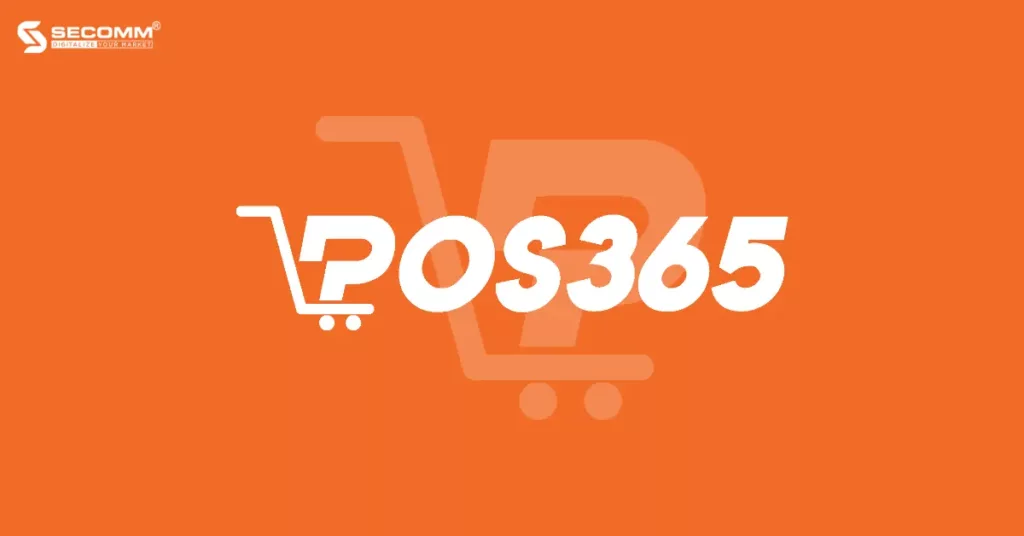
Pros
Vietnamese business-friendly: POS365 has a modern interface that’s easy to navigate, with features thoughtfully tailored to Vietnamese business practices.
Diverse Features: POS365 offers a comprehensive set of sales and business management tools, encompassing inventory control, order processing, warehouse management, customer relations, staff oversight, and business reporting.
Multi-Branch Management: POS365 facilitates the management of multiple branches and sales points through a unified system, simplifying business expansion and operation oversight.
Cons
Limited customization: POS365 comes with certain limitations regarding customization and specific business requirements adjustments. This can pose challenges for businesses with unique needs or customization preferences.
Internet required: POS365 relies on a stable internet connection to function. If there’s an internet disruption, payment processing and business management may experience interruptions.
Limited security: Because POS365 is an online system, there’s a higher risk of cyberattacks or data breaches. Businesses need to implement appropriate security measures to safeguard customer information and business data.
Related content: Top 5 best POS software for large-scale enterprises in 2023
Above is a brief overview of 5 POS software solutions widely used by SMEs to enhance business efficiency. Businesses need to consider various factors to select the most suitable POS system.
 2
2

 9,766
9,766

 0
0

 1
1
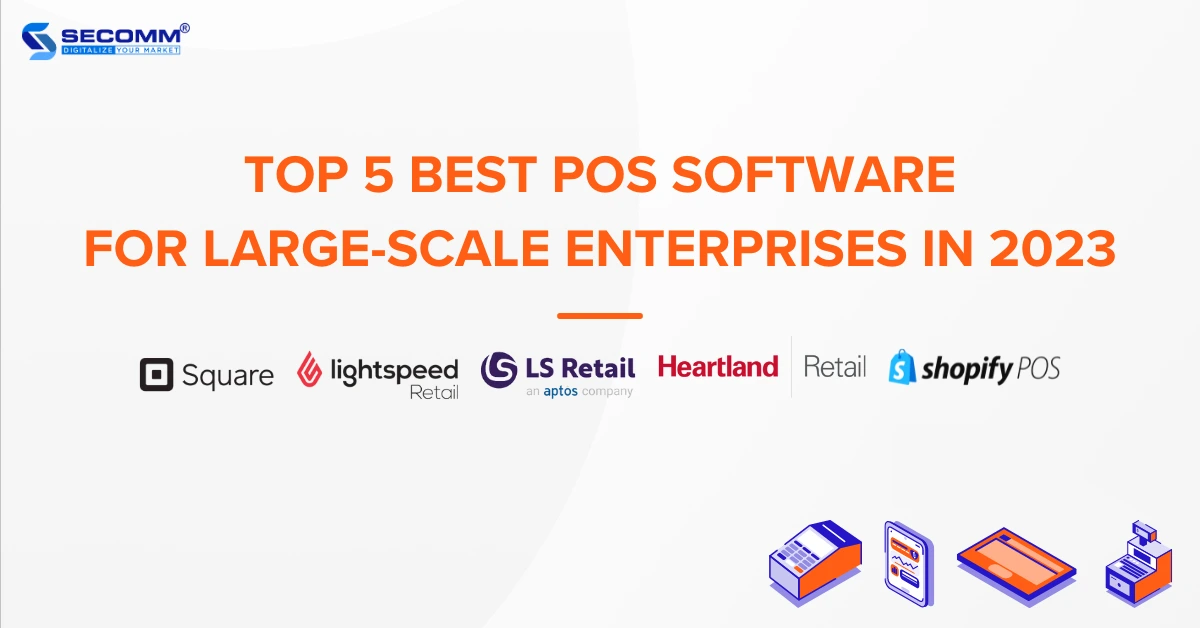
TOP 5 BEST POS SOFTWARE FOR LARGE-SCALE ENTERPRISES
Much like searching for the right eCommerce platform that fits a business model, the quest for a suitable POS system can be equally challenging, especially for large enterprises.
In this article, SECOMM will delve into the top five widely favored POS software solutions by large corporations today, including Square, Lightspeed Retail, LS Retail, Heartland Retail, and Shopify POS.
Square Point of Sale
Square POS, developed by Square, is a highly favored POS system among many international large-scale enterprises due to its cost-free setup. However, Square applies fees for each transaction executed on the POS, amounting to 2.6% and 10 cents for every tap, dip, or swipe. For the ‘Buy Now, Pay Later’ payment scheme, the fees are 6% and 30 cents. Furthermore, Square provides a tailored POS package for businesses generating revenue exceeding $250,000.
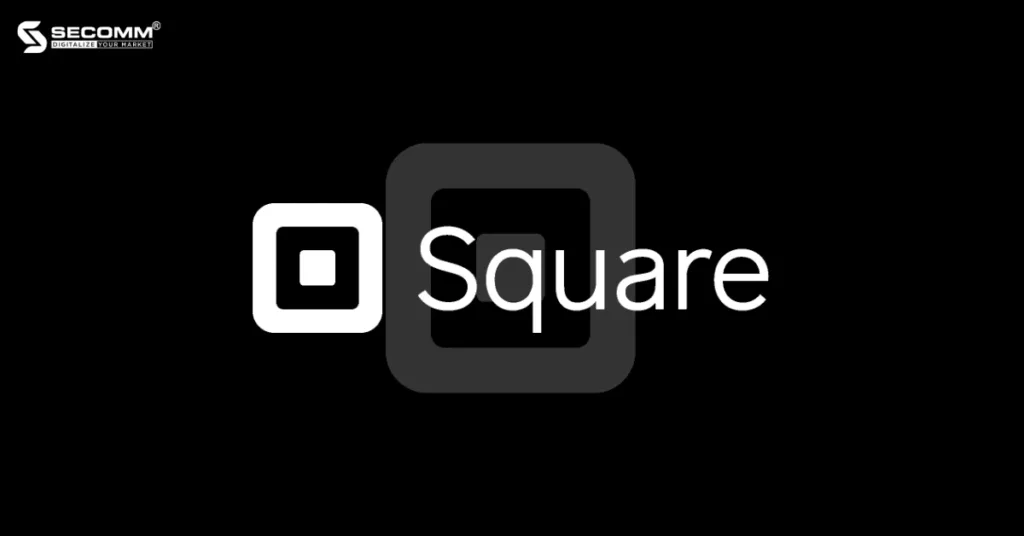
Types of POS system: Tablet-based POS system, Mobile POS system, Cloud-based POS system.
Pros
It’s free: Square software is completely free to use, without any charges for setup or monthly licenses.
It’s User-Friendly: Square offers a straightforward and intuitive user interface, making it easy for users to quickly adapt to and utilize the system effectively.
It’s flexible: Square empowers businesses to execute sales transactions from virtually anywhere using mobile devices like smartphones or tablets. This flexibility enables businesses to reach and serve customers at any time and place.
Cons
Costs Increase with Each Transaction: Square applies transaction fees (2.6% + 10 cents) to every payment processed. While its fee structure is relatively competitive, businesses with substantial sales volumes may find these fees impacting their overall profitability.
Limited Hardware Compatibility: Typically, POS systems are designed to work seamlessly with hardware provided by Square. This means that businesses might encounter challenges when attempting to utilize hardware from alternative suppliers or integrate with existing brand-specific POS systems.
Feature Constraints: Square does have some feature limitations compared to other POS systems. For instance, functionalities like multi-store management, membership card integration, or compatibility with various other business management software may be limited.
Lightspeed Retail
Lightspeed Retail is a tailored POS solution crafted for businesses operating across diverse industries. It earns praise for its wide-ranging features, high level of customization, and its seamless integration capabilities with various applications and services.
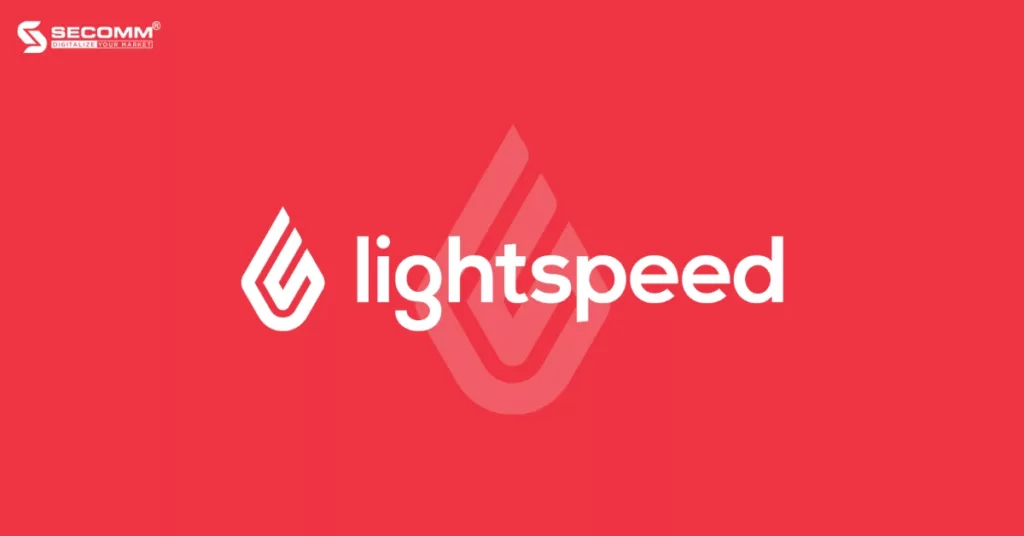
Types of POS system: Tablet-based POS system, Mobile POS system, and Cloud-based POS system.
Pros
Multi-Industry: Lightspeed Retail is specifically crafted to cater to a wide array of industries, including retail, restaurants, coffee shops, spas, salons, and more. This versatility positions Lightspeed as a multifunctional solution across various sectors.
Integration and Scalability: Lightspeed seamlessly integrates with numerous other applications and services, encompassing inventory management systems, online ordering platforms, integration with online sales channels, and much more. This flexibility enables businesses to scale and tailor the system to meet their unique requirements.
Customer Support: Lightspeed earns accolades for its top-notch customer support, offering assistance through phone, email, and online channels. The friendly and professionally trained support team is adept at resolving a multitude of issues.
Cons
High Costs: Lightspeed is associated with a higher price point in comparison to several other available POS solutions in the market.
Complex Initial Setup: The initial setup and configuration of Lightspeed can prove intricate for users lacking prior tech experience. Accurate installation, coupled with appropriate configuration, is essential to guarantee stable operation.
Internet Required: As an online POS system, Lightspeed relies on a consistent internet connection for optimal performance. Any disruptions or instability in the internet connection can lead to transaction processing issues and hinder system access.
LS Retail
LS Retail stands as a top-tier provider of POS and ERP software grounded in the Microsoft Dynamics platform. It is meticulously tailored to oversee the entirety of business operations across diverse sectors, including retail, restaurants, hotels, pharmacies, and gas stations.
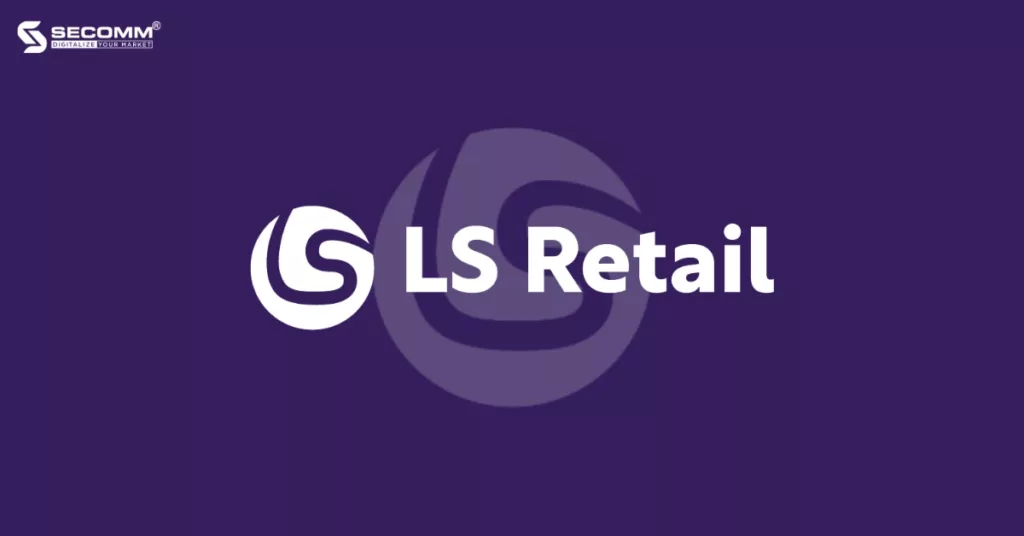
LS Retail extends three solution packages for businesses to select from:
- LS Express: Priced at $99 per month, this solution caters to small-scale businesses.
- LS Central: Offering a comprehensive POS and ERP solution for businesses (Development costs vary based on project complexity).
- LS First: Strategically designed for large corporations, with a particular emphasis on the restaurant industry (Development costs vary based on project complexity).
Types of POS system: Tablet-based POS system, Mobile POS system, and Cloud-based POS system.
Pros
Holistic Management: LS Retail offers an integrated POS and ERP solution, facilitating the synchronization of business data and more efficient management across both systems.
Multi-Channel Sales: LS Retail supports a diverse array of sales channels, encompassing traditional brick-and-mortar stores, eCommerce websites, and mobile point-of-sale (mPOS) kiosks. This broadens business horizons, reaching a larger pool of potential customers.
Efficient Inventory Management: LS Retail delivers real-time inventory management algorithms, empowering businesses to govern stock levels, item locations, and optimize procurement processes. This results in reduced shortages and excess inventory, ultimately enhancing operational efficiency.
Cons
High Costs: As LS Retail is a comprehensive POS and ERP solution, both ownership and maintenance costs may be considerably high for businesses.
Technical Expertise Required: Implementing LS Retail mandates that your business’s workforce possesses specialized technical skills and undergoes dedicated training
Dependency on Microsoft Dynamics: LS Retail is built on the Microsoft Dynamics platform, meaning the implementation and enhancement of the LS Retail system hinge on the evolution of Microsoft Dynamics, influencing bug fixes and the incorporation of the latest updates to some degree.
Heartland Retail
Heartland Retail is a cloud-based point-of-sale (POS) platform tailor-made for retail businesses.
As of now, Heartland levies a fee of $89 per month per point of sale for their POS software. Furthermore, this platform provides payroll services starting at $89 per month for 1-5 employees and payment processing services with a cost of 2.6% per successful transaction, alongside 10 cents for each tap, dip, or swipe.
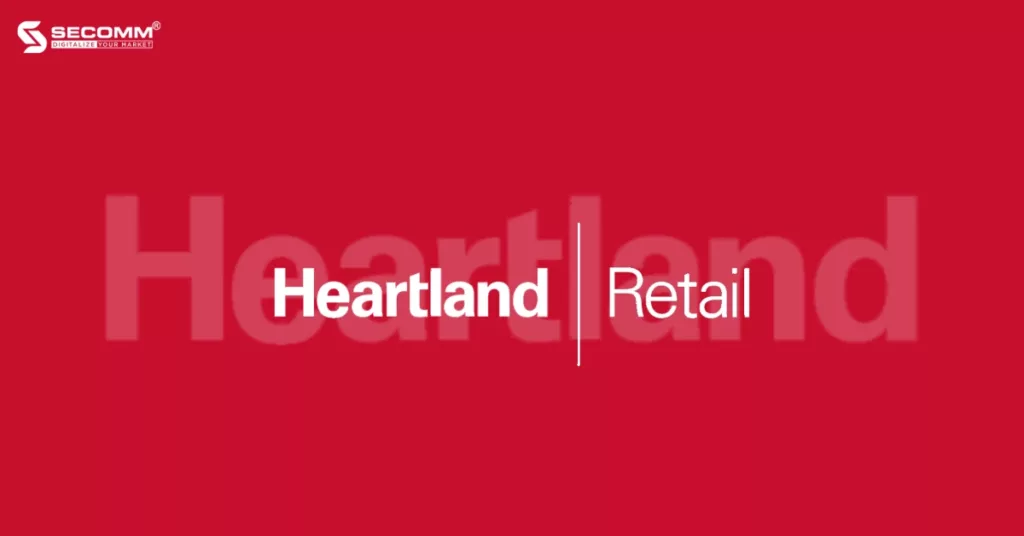
Type of POS system: Cloud-based POS system
Pros
User-Friendly Interface: Heartland Retail boasts a user-friendly and intuitive interface. Sales staff can easily navigate between functions, process payments, and engage with customers effortlessly.
Smart Reporting and Analysis: Heartland Retail offers sophisticated analytical tools and reporting capabilities, empowering businesses to gain a deeper insight into their performance and consumer trends.
Integration with Auxiliary Systems: Heartland Retail is equipped to seamlessly integrate with various auxiliary systems, including accounting, human resources management, and customer relationship management (CRM) systems. This integration facilitates the creation of a comprehensive information system, enhancing the efficiency of different departments within the organization.
Cons
Inefficient Customer Support: Numerous customer feedback reports cite limitations in customer support, with varying response times from Heartland Retail’s support team and inconsistent answers or solutions. This can pose difficulties for businesses requiring swift assistance or specific solutions.
Multi-Store Management Constraints: Heartland Retail lacks robust and flexible multi-store management features for companies operating beyond the U.S., as the company’s primary headquarters is exclusively located in the U.S.
Limited New Features and Updates: Heartland Retail doesn’t frequently introduce new features and updates, unlike some other POS systems. This limitation may hinder the adoption of the latest technologies and trends in the industry.
Shopify POS
Shopify POS is a POS solution designed by Shopify, catering to businesses utilizing their platform and seeking sales management software to effectively manage their business affairs. The usage cost for Shopify POS amounts to $89 per month per location, with a reduced rate of $79 per month per location for businesses opting for an annual subscription.
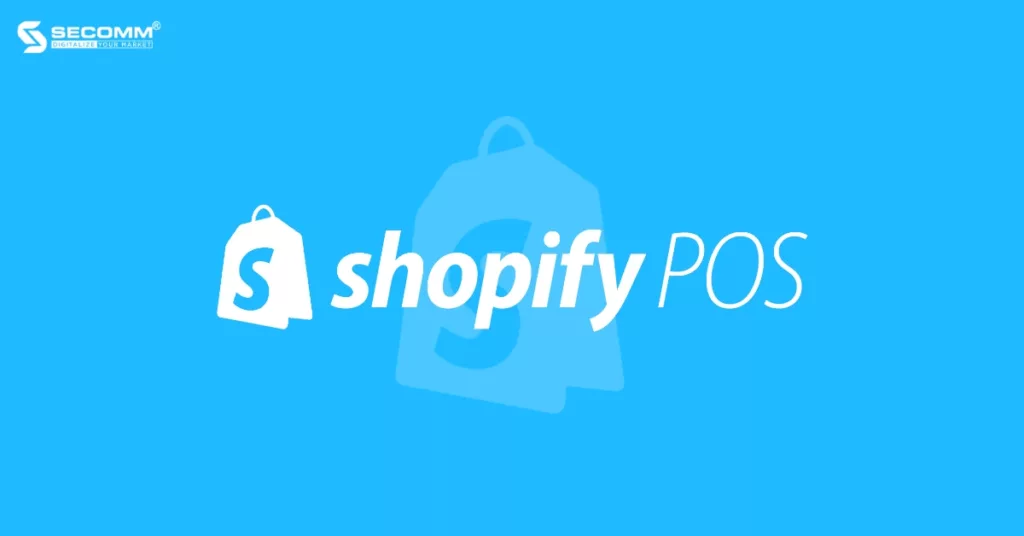
Pros
Ease of Use: Shopify POS boasts a straightforward and friendly admin interface, designed for quick staff adaptation, reducing training time, and minimizing data entry errors.
Seamless Integration with the Shopify Platform: It smoothly integrates with eCommerce websites built on the Shopify platform, enabling businesses to efficiently manage both physical and online stores from one centralized platform, resulting in time and resource savings.
Customization: Shopify POS enables businesses to customize the interface, product labels, invoices, and create brand introduction pages for brick-and-mortar stores, among other features.
Types of POS system: Tablet-based POS system, Mobile POS system, Cloud-based POS system
Cons
Exclusive to the Shopify System: Since this software is built by Shopify, it can only be integrated with this platform.
Complexity with Multiple Stores: While Shopify POS offers multi-store management capabilities, handling and configuring various stores can become intricate as the number of stores grows. Businesses must invest sufficient time in meticulous management, maintenance, and information updates for each individual store.
High Transaction Fees: When using Shopify POS, businesses are required to pay transaction fees (ranging from 2.4% to 2.6%) for each transaction. These fees can add up, especially for businesses with a large volume of transactions.
Above is a brief comparison of five POS software systems widely used by many large businesses to enhance the efficiency of their operations. Businesses need to consider various factors to select the most suitable POS system.
 2
2

 15,234
15,234

 1
1

 2
2
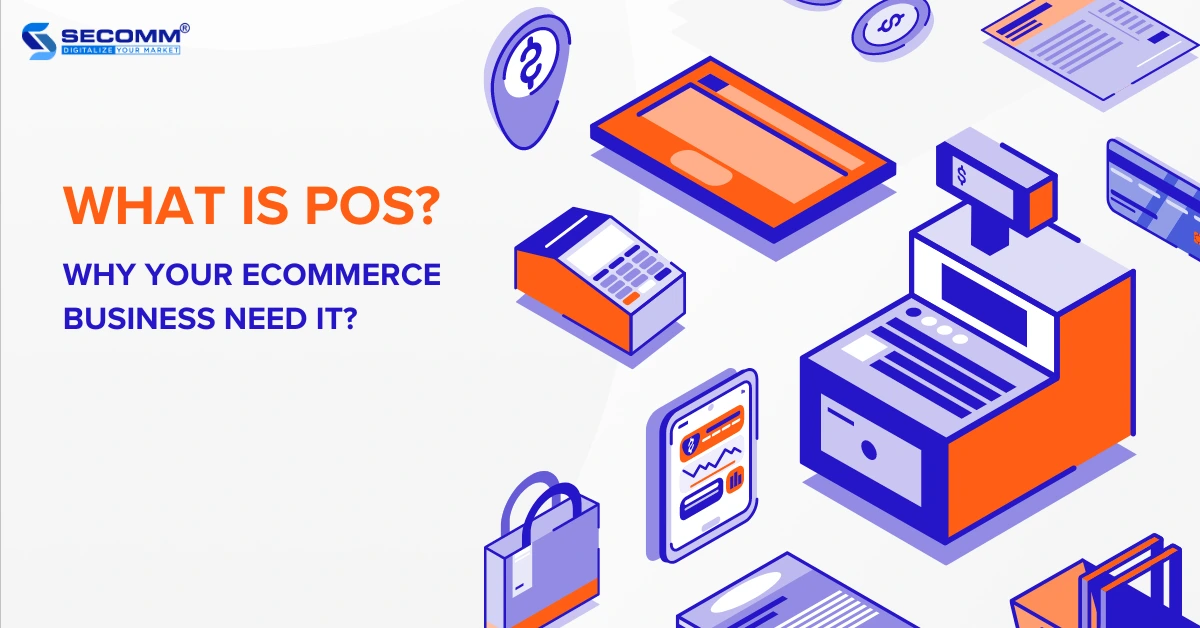
WHAT IS POS? WHY YOUR ECOMMERCE BUSINESS NEED IT?
The Point of Sale (POS) software system stands as a crucial management system for all types of enterprises, be it online, offline, or O2O (online to offline) businesses.
What is POS?
POS or Point of Sales is sales management software that empowers businesses to efficiently monitor all their business activities, anytime and anywhere. In essence, POS is a complete system comprising both hardware and software components, or it can be as straightforward as a point-of-sale device, such as a computer, tablet, smartphone, receipt printer, and so on.
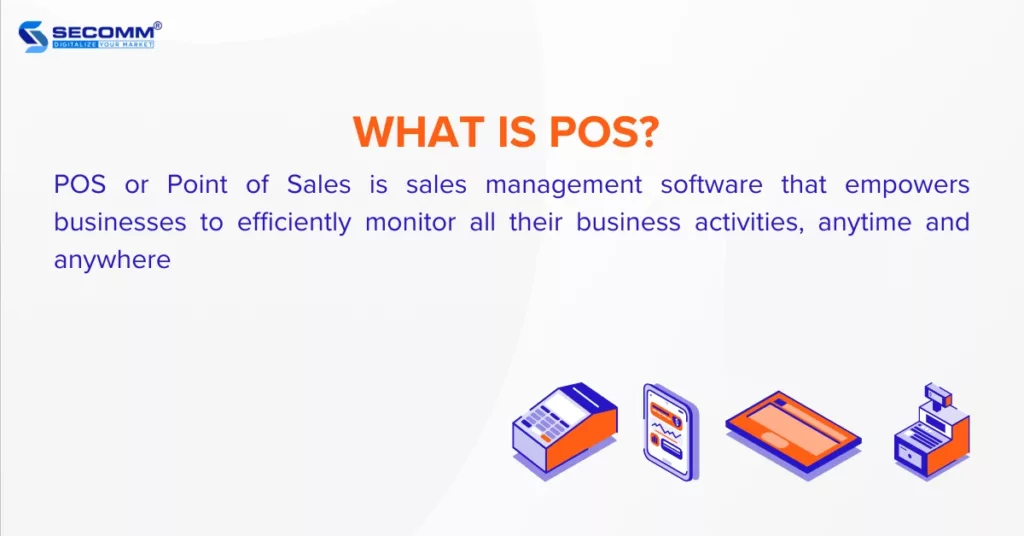
With its robust management capabilities, POS helps businesses oversee and process sales transactions, calculate payments, generate invoices, manage inventory, handle customer relationships, and deliver crucial insights regarding sales performance.
Types of POS system
There are four main types of POS systems that businesses commonly use today, including Legacy POS system, Tablet-based POS system, Mobile POS system and Cloud-based POS system.
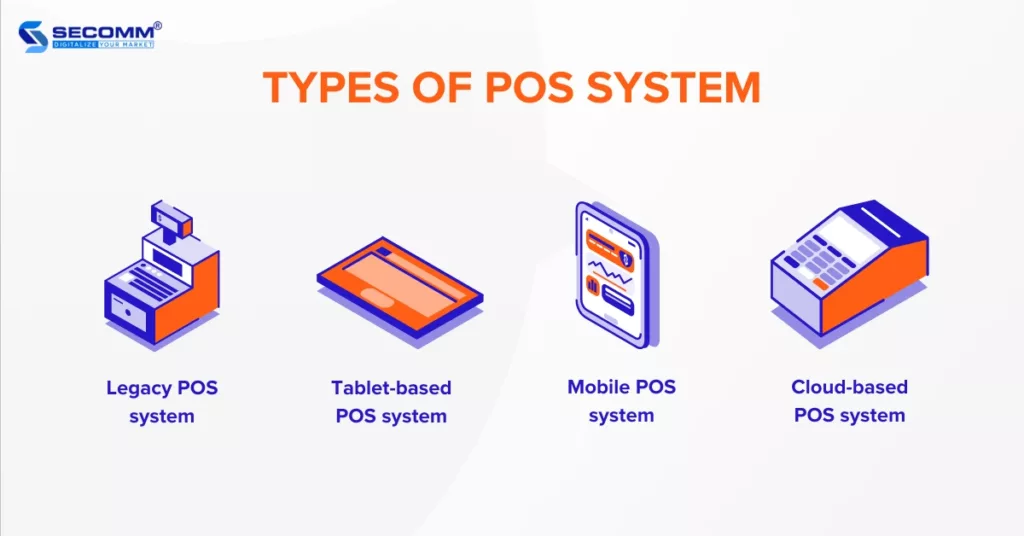
Legacy POS system
The Legacy POS system, also known as on-premise POS, is a type of point-of-sale system that relies on conventional hardware and software to handle sales transactions and manage local data. This means that all transactions and information are stored on a single device, with businesses only able to access the data from that specific device.
As a result, traditional POS systems often require installation and configuration at each individual point of sale, and they typically lack remote accessibility. This can slow down the integration process with eCommerce systems.
For example, some legacy POS systems include Aloha, Oracle MICROS, Squirrel Systems, and more.
Tablet-based POS system
A Tablet-based POS system is a type of POS system that employs tablets as the main devices for processing sales transactions, rather than relying on conventional computers or standalone POS equipment.
Due to its reliance on hardware that is familiar to many, integrating this POS system with eCommerce platforms and training staff tends to be more straightforward compared to legacyPOS systems.
Examples of well-known Tablet-based POS systems include Lightspeed POS, Square, Shopify POS, and others.
Mobile POS system
A Mobile POS system is a type of POS that employs mobile devices like smartphones, tablets, or wearable devices for handling sales transactions. This allows sales staff to move freely within the store or conduct transactions directly at the customer’s location.
This functionality enables sales associates to access product details and customer records via the Mobile POS system, facilitating inventory checks and offering personalized recommendations to customers. Just like Tablet-based POS systems, integrating and training staff to use Mobile POS systems is generally uncomplicated.
Some widely used Mobile POS systems include Lightspeed POS, Clover, Square, and others.
Cloud-based POS system
A Cloud-based POS system leverages cloud computing technology to store and process sales data. Instead of keeping data on local computers or in-house servers, this system adopts an online approach to manage and access data from any device with an internet connection.
The majority of modern POS systems are cloud-based because they offer various advantages, including remote accessibility, flexibility, easy integration, and scalability. They enable businesses to oversee multiple points of sale from a unified platform, providing real-time data and insights for informed decision-making. Furthermore, Cloud-based POS systems reduce hardware demands and installation costs when compared to other POS solutions.
Some prominent examples of top Cloud-based POS systems for businesses include Lightspeed POS, Square, Clover, and others.
Benefits of using POS software
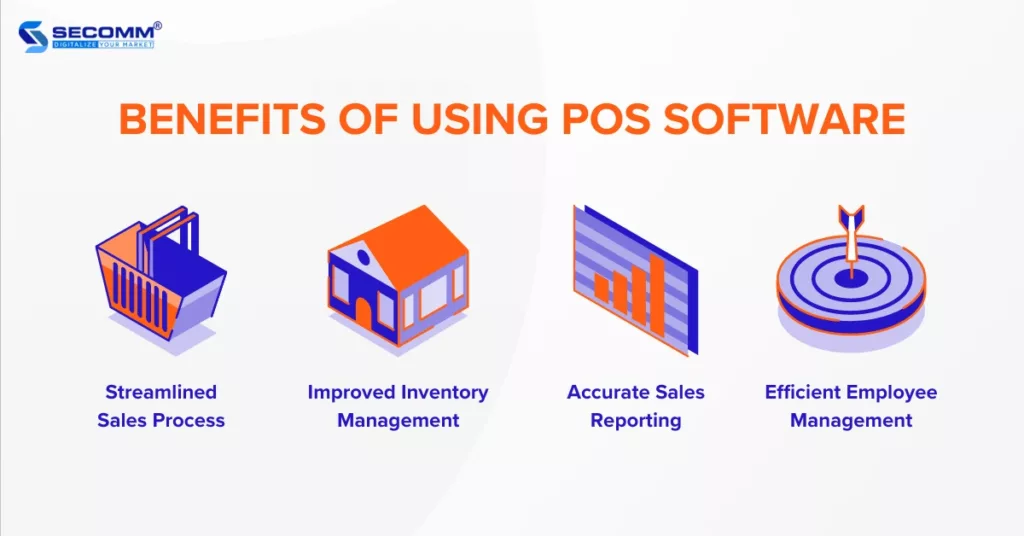
Streamlined Sales Process
The POS system streamlines and automates the sales process, ensuring faster and efficient transactions. Businesses can swiftly process payments, precisely calculate totals, and produce invoices or receipts within mere seconds.
Improved Inventory Management
The POS system empowers businesses to actively monitor and manage their inventory in real-time, receiving alerts when products are running low and automatically initiating reorder processes. This helps prevent stock shortages or excess inventory, ultimately optimizing inventory levels and reducing storage expenses.
Accurate Sales Reporting
The POS system offers the ability to analyze and report detailed revenue data, empowering businesses to monitor their performance, understand consumer trends, identify favored products, and so forth. Consequently, this data forms the basis for businesses to strategize for the future.
Efficient Employee Management
The POS system simplifies the process of monitoring each employee’s sales volume, work hours, and performance indicators. Consequently, businesses can obtain precise data for calculating individual commissions, streamline payroll processing, and identify high-performing team members or those requiring further training.
Overall, POS stands as a vital management software within any eCommerce business framework. Businesses should conduct thorough research on different POS system types to choose the most fitting and effective management software in line with their business model and strategy.
Contact SECOMM or dial our Hotline at (02871089908) for consultation and the implementation of your POS system
 2
2

 9,316
9,316

 0
0

 1
1
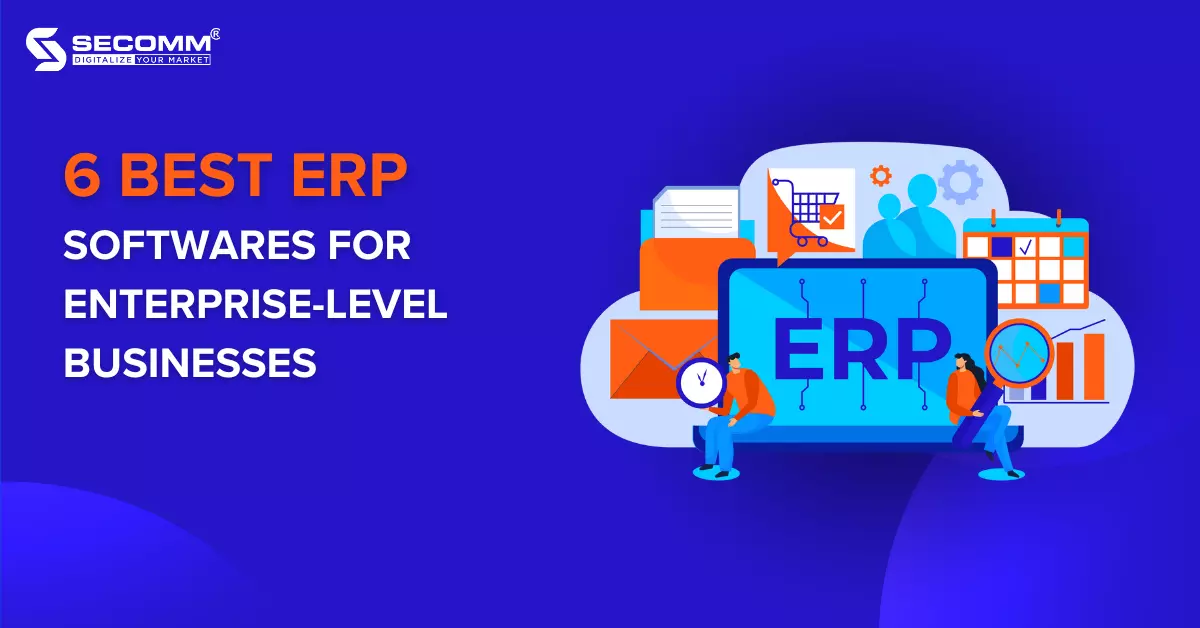
6 BEST ERP SOFTWARES FOR ENTERPRISE-LEVEL BUSINESSES
Data holds significant value for eCommerce enterprises across all sizes, yet effectively managing and monitoring it is no simple task. Hence, the advent of ERP software emerges as a superior solution, enabling the amalgamation of all business data into a singular database for seamless accessibility, analysis, and oversight.
Nevertheless, to fully unlock the capabilities of ERP, businesses must opt for software equipped with features aligned with their specific business requirements. Recently, six prominent ERP software solutions are widely adopted by many eCommerce enterprises: Oracle Netsuite, Acumatica, Odoo, Sage x3, SAP S/4 HANA, and Microsoft Dynamics 365.
What is ERP?
ERP stands for Enterprise Resource Planning, is a software solution designed to assist businesses in gathering, storing, analyzing, and overseeing all data pertaining to their business operations from diverse internal departments, all within a single database. This data encompasses:
- Business financial data
- Sales and marketing data
- Production, inventory, and supply chain data
- Human resource management functions, and more
Integrating ERP software into eCommerce operations empowers businesses to centrally manage data originating from multi-channel sales and marketing endeavors, encompassing sources like websites, social media, mobile devices, and brick-and-mortar stores.
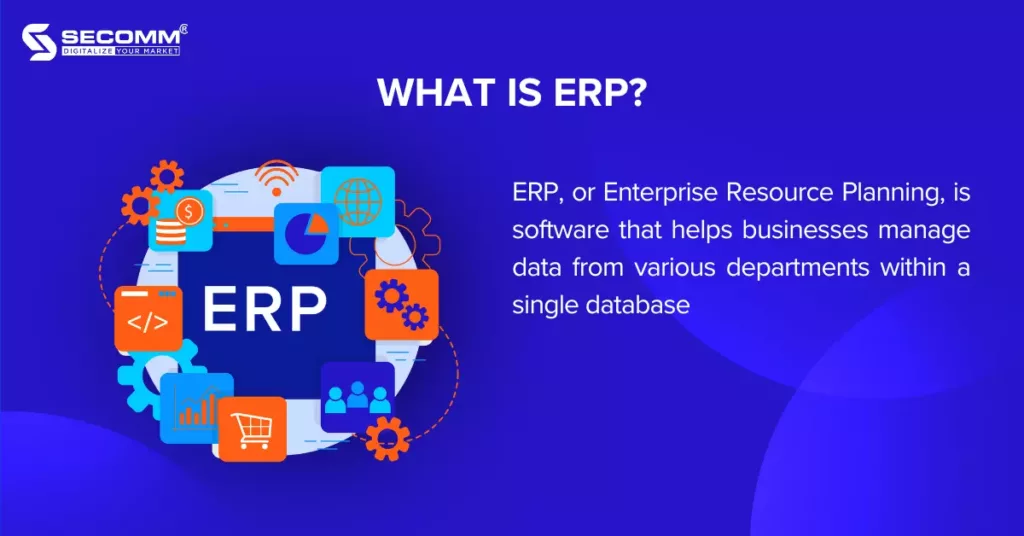
Types of ERP Systems
On-premise ERP
On-premise ERP software, also referred to as ERP in-house, is installed and stored directly on the business’s servers and internal infrastructure. When utilizing on-premise ERP, the business assumes responsibility for managing hardware, IT infrastructure, software updates, and maintenance.
Cloud-based ERP
Cloud-based ERP software is supplied, stored, and managed by a third-party provider. This allows users to access it remotely from any device with an internet connection and is also known as Software as a Service (SaaS). In this scenario, the provider takes charge of infrastructure management, encompassing servers, storage, data backups, updates, and software maintenance.
Hybrid ERP
Hybrid ERP software is a combination of both on-premise and cloud-based ERP solutions. In the hybrid ERP model, specific modules of the ERP system are stored on-premise, while others are stored in the cloud. This approach enables businesses to leverage advantages from both software models. For instance, critical data or modules can be kept on-premise for control and heightened security, whereas less critical data or modules can be hosted in the cloud for effortless accessibility and future expansion.
Advantages of Using ERP in eCommerce
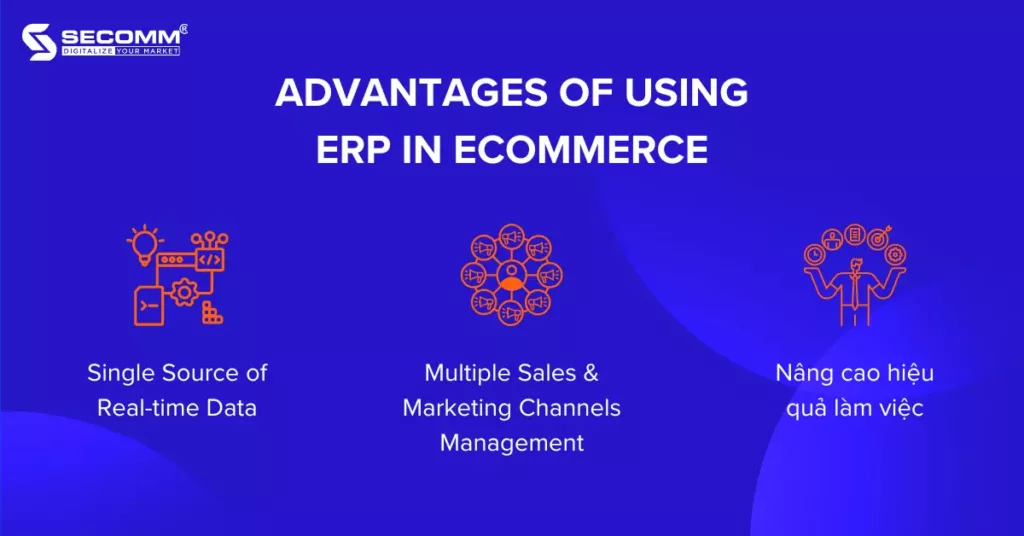
Single Source of Real-time Data
One notable advantage of ERP software is its real-time integration capability, which consolidates diverse departmental data into a unified database. This consistency streamlines data management, especially considering the substantial volume of data that eCommerce businesses accumulate daily, much of which pertains to purchasing behavior.
As a result, when integrating this data with other business information, enterprises can uncover and implement distinctive approaches to:
- Cultivate brand identity
- Increase sales
- Create marketing campaigns to enhance conversions
- Trim unnecessary operational expenses, and more
For instance, ERP software provides businesses with reports encompassing details about best-selling products, canceled orders, recurring customer lists, cart abandonment rates, interactions with social media posts, and more. In turn, businesses can amalgamate all this data within a shared database to gain a holistic perspective of the current landscape and swiftly make pertinent adjustments for eCommerce expansion.
Multiple Sales & Marketing Channels Management
eCommerce enterprises employing a variety of channels in their sales and marketing strategy will likely need to evaluate sales performance and engagement levels across each channel to gauge their efficacy. ERP software assists businesses in concurrently managing sales channels within a centralized database.
Through analyzing integrated ERP data from various channels, encompassing social media, websites, mobile apps, eCommerce platforms, and more, enterprises can understand why one sales channel surpasses others and determine which marketing campaigns yield favorable conversions and which ones require enhancement.
Boost Productivity
Insufficiently integrated business data can lead to difficulties in accessing accurate and updated information. This may compel businesses to manually input extensive data, potentially resulting in errors.
Conversely, the use of ERP can facilitate nearly impeccable automated data entry. Moreover, this software supports other automated processes, like invoice generation and marketing campaign automation, among others. This frees businesses from monotonous manual tasks, enabling them to concentrate on pivotal tasks that enhance revenue.
Top 6 eCommerce ERP Software
Oracle NetSuite
Oracle NetSuite serves as a cloud-based ERP solution, delivering a comprehensive set of tools for effectively managing business operations. This software empowers eCommerce enterprises to automate functions across multiple domains, including sales management, marketing, customer relations, financial control, inventory management, and more.
What sets Oracle NetSuite apart is its adaptability and scalability, catering to businesses of various scales and industries. It streamlines eCommerce workflows while enhancing operational efficiency, all facilitated by real-time insights available through a unified dashboard.
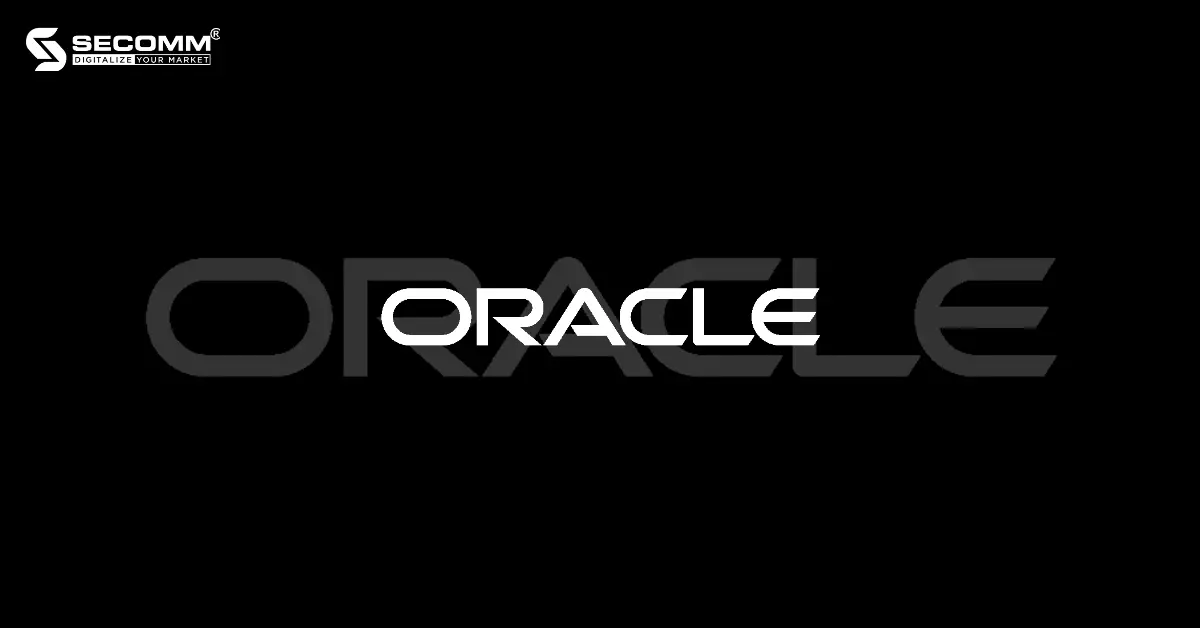
Key features of Oracle NetSuite encompass:
- eCommerce Capability: Facilitating efficient management of eCommerce outlets, multichannel sales, product catalog administration, online order handling, and seamless omnichannel shopping experiences.
- Order & Inventory Management: Optimizing order fulfillment processes and live monitoring of inventory levels and control.
- Customer Relationship Management (CRM): Empower businesses with CRM functionalities for overseeing customer interactions, sales workflows, marketing endeavors, and personalized customer experiences.
- Financial Management: Oracle NetSuite aids in financial oversight by providing shared ledgers, budget planning, revenue recognition, and comprehensive financial reporting.
- Real-time Reporting & Analytics: NetSuite integrates real-time analytics and reporting tools into a customizable dashboard, offering support for data-driven decision-making.
Pros:
- Easily accessible on multiple computer and mobile browsers.
- User-friendly and intuitive interface suitable for a wide range of users.
- Real-time reporting capability.
- Easily customizable and expandable to match individual business needs.
Cons:
- Undisclosed pricing, causing challenges in estimating deployment costs.
- Complex deployment procedures.
- Being primarily a cloud-based ERP, Oracle NetSuite might restrict businesses’ control.
- Dependence on internet connectivity.
- While NetSuite allows for customization, there are limitations on the extent of flexibility in these customizations. Hence, complex customization needs might require additional development or alternative solutions.
Cost: Estimated deployment costs for Oracle NetSuite can commence at $10,000. Nevertheless, this is not a fixed price and will be tailored according to each business’s specific deployment requirements.
Acumatica
Acumatica stands as a cloud-based ERP software designed to cater to businesses of all sizes, particularly those in rapid development. It offers adaptable cloud storage alternatives, including both public and private clouds, ensuring convenient access and secure handling of business data.
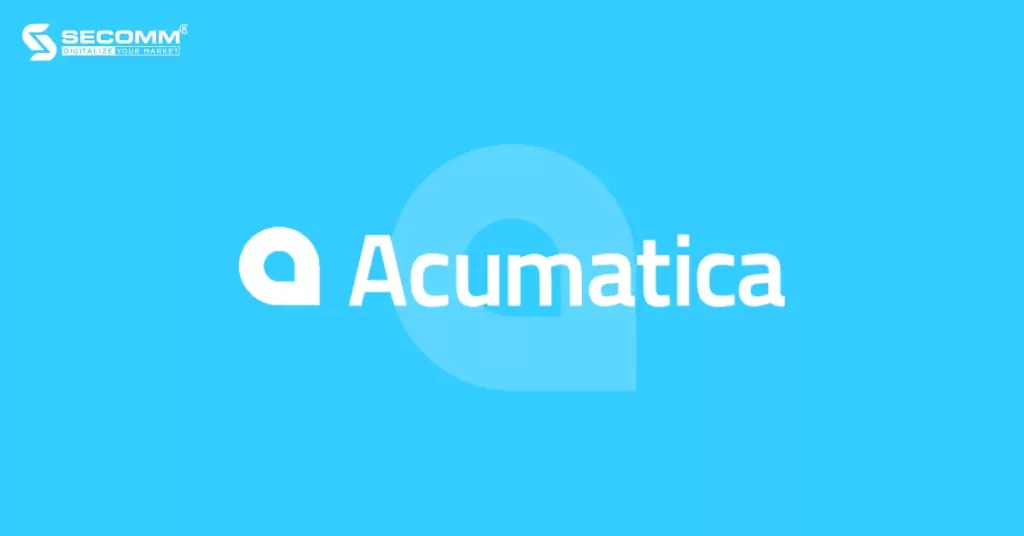
Prominent features of Acumatica including
- eCommerce Integration: Acumatica empowers businesses to seamlessly integrate with popular eCommerce platforms like Amazon, Magento, Shopify, BigCommerce, and more. The integration process is designed to be swift and smooth, enabling businesses to harness specific eCommerce functionalities such as order management, inventory synchronization, shipping, and taxation.
- Financial Management: Acumatica equips businesses with tools to streamline financial operations, automate accounting procedures, generate financial reports, and manage general ledgers. This ERP solution furnishes real-time insights into financial performance, supporting informed decision-making based on precise and updated financial data.
- Inventory Management: Acumatica delivers an array of tools to efficiently manage and optimize inventory. Moreover, it facilitates real-time monitoring and predictive analysis of inventory, enabling businesses to minimize stock shortages and unnecessary inventory costs.
Pros:
- The flexible modular structure allows businesses to register and use the modules they need, and easily add or modify modules over time based on developmental needs.
- Real-time data delivery anytime, anywhere, and on any device.
- The software can be easily integrated with modern technologies in the future.
- An outstanding solution that meets the specific needs of various industries, including construction, distribution, manufacturing, and eCommerce retail.
Cons:
- The pricing is not publicly disclosed, which makes it difficult for businesses to estimate deployment costs.
- The flexibility in the modular structure can lead to additional costs when the demand for additional modules increases rapidly over time.
Cost: Estimated costs for deploying Acumatica can range from $15,000 to $40,000 per year. However, this is not a fixed price and will be customized based on the specific deployment needs of each business.
Odoo
Odoo is an open-source ERP software in a modular form that can be customized to support businesses in efficiently managing various aspects of their operations, such as customer relationship management (CRM), accounting, inventory management, and more. Odoo provides an optimal solution for businesses of all sizes and industries.
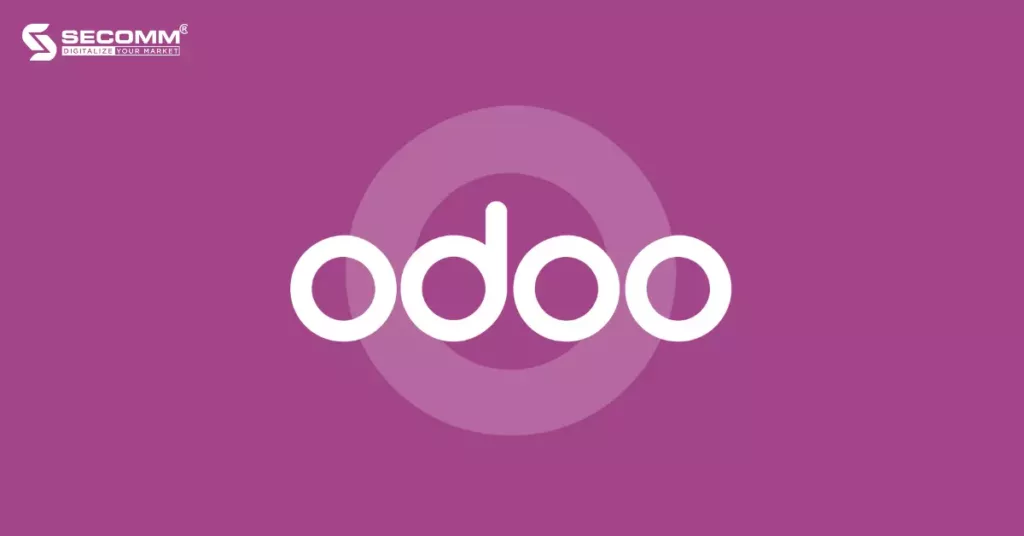
Key Features of Odoo:
Odoo offers a comprehensive set of features and modules ranging from basic to advanced, catering to all business operational needs in eCommerce. It stands out with the following features:
- Webstore Creation: Odoo provides a web builder that enables businesses to swiftly establish and manage their online presence. Businesses can design and customize professional eCommerce websites through drag-and-drop features, utilizing available templates and features such as page creation, content management, integrated blogging, SEO, and more.
- Customer Relationship Management (CRM): Odoo supports effective customer relationship management with features for managing potential customers, interacting with existing customers, handling sales processes, and segmenting customer groups. Moreover, the CRM module can integrate with other Odoo modules for streamlined tracking and operation.
- Product Management: Using Odoo, businesses can efficiently manage their products by creating and organizing product catalogs, defining attributes, managing product pricing, tracking product availability, and overseeing product lifecycle stages.
- Inventory Management: Businesses can utilize Odoo to track inventory movements and optimize order fulfillment. The system also supports features such as barcode scanning, serial number tracking, real-time batch management, and updates.
- Marketing: Businesses can automate marketing campaigns using Odoo. From email marketing and social marketing to SMS marketing, Odoo assists businesses in creating, executing, and automating the monitoring of campaign effectiveness. Additionally, integrating Odoo with social media platforms helps businesses increase their potential customer reach, nurture leads, and achieve rapid conversions.
Pros:
- Complete range of customizable features from basic to advanced.
- Offers a variety of modules spanning from sales management, and marketing, to financial management and inventory control. Modules are integrated and share data with each other.
- Intuitive and user-friendly interface.
- Capability to display all detailed information on a single unified database.
- High degree of customization to suit specific business needs.
Cons:
- Complex setup process.
- While Odoo offers customization capabilities, complex customization needs substantial investments in terms of time, costs, and technical expertise.
- Limited customer support.
- Performance and scalability fall short of meeting the demands of large enterprises.
Cost: Businesses receive free usage if they utilize only a single module and there’s no restriction on the number of users. However, if a business uses two or more modules, the pricing structure is determined based on:
- Number of users
- Number and type of modules used
Sage x3
Sage X3 is a hybrid ERP software solution designed to meet the needs of medium-sized and large enterprises in managing and operating business activities across multiple locations or countries.
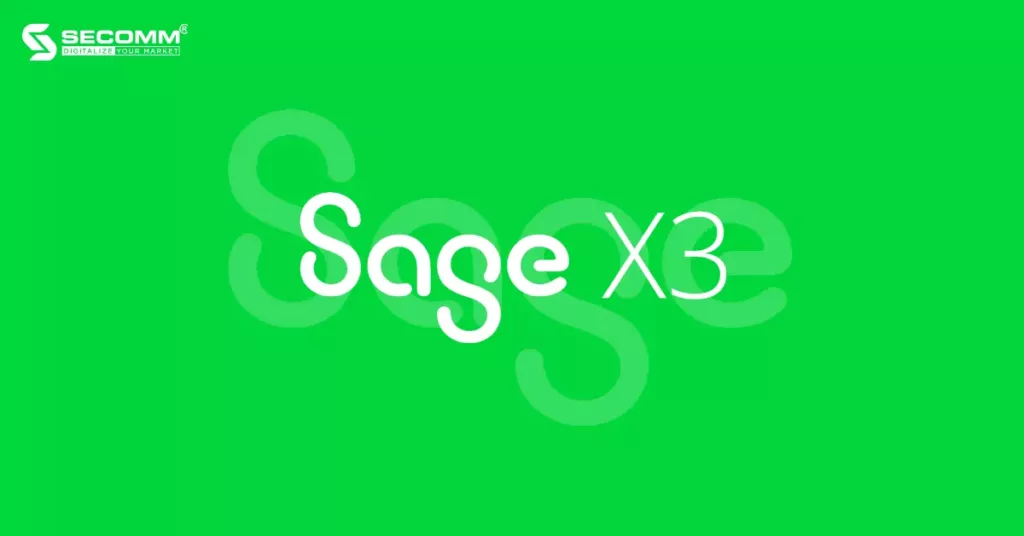
Key features of Sage X3:
Sage X3 offers a range of features from basic to advanced to support business management and operations processes, with a focus on product management, supply chain management, and financial management.
- Product Management: Sage X3 provides businesses with flexibility in managing product-related processes through solutions such as Bill of Materials (BOM) planning, Quality Control, Shop Floor Control, and Project Management.
- Supply Chain Management: Sage X3 offers comprehensive integration of solutions including Purchasing, Inventory Management, Sales Management, and Customer Service to help businesses capture customer demands and enhance supply chain operations efficiency.
- Financial Management: Sage X3 provides businesses with a set of solutions to monitor real-time financial data, aiding in strategic decision-making. Solutions encompass budgeting and accounting, fixed asset management, and financial reporting.
Pros:
- Real-time data reporting and updates, enhancing financial management processes and decision-making optimization.
- Intuitive and user-friendly interface.
- High scalability and extensive customization options.
- Offers tailored support for specific industry workflows.
Cons:
- Undisclosed pricing complicates cost estimation for deployment.
- Absence of live chat support for direct customer assistance on the website.
- Lack of social media integration.
Cost: Estimated implementation costs for Sage ERP can commence at $128,000. However, this figure is not fixed and will be adjusted based on the unique deployment requirements of each business.
SAP S/4 HANA
SAP S/4 HANA (High-Performance Analytic Appliance) is a leading hybrid ERP software designed for large-scale enterprises. SAP S/4 HANA is considered the next-generation comprehensive ERP solution by SAP, incorporating artificial intelligence technology. It is designed to optimize business processes, cater to specific industry requirements, and support decision-making processes. The software offers solutions in financial management, supply chain management, sales management, customer relationship management, and more.
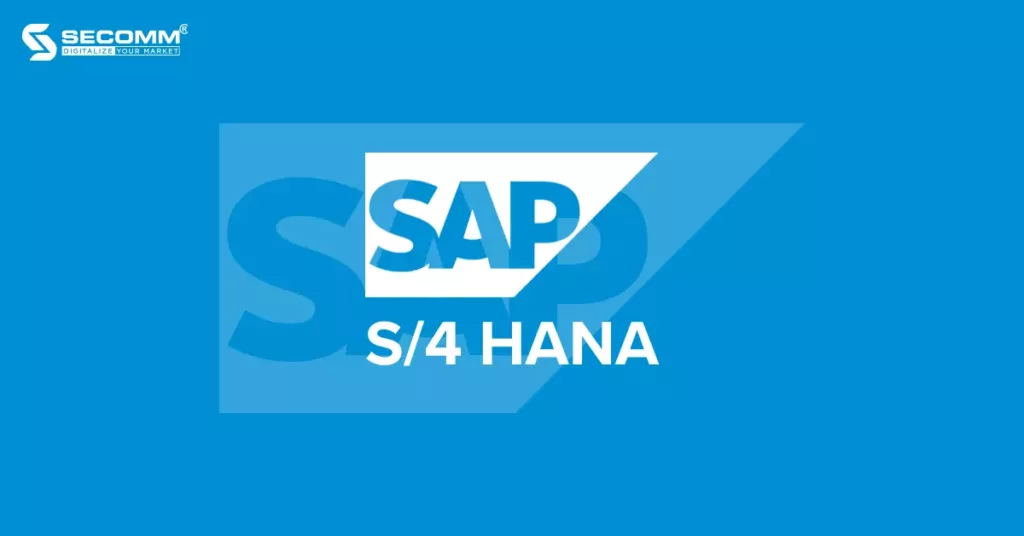
Key Features of SAP S/4 HANA:
- In-Memory Computing Technology: With this technology, SAP S/4 HANA can process and analyze real-time data while performing calculations and accessing data about 10,000 times faster than current technologies. This enables businesses to instantly access accurate and updated data, ensuring more confident decision-making.
- Consolidated Reporting: This ERP provides a solution for businesses to generate consolidated reports such as balance sheets, profit and loss statements, and cash flow statements. Additionally, businesses can visualize both aggregated and unaggregated financial information using SAP Analytics Cloud.
- On-Cloud and On-Premise Deployment: This offers businesses the flexibility to choose their preferred deployment model. On-cloud deployment promotes scalability, accessibility, and reduces infrastructure costs, while on-premise deployment grants businesses more control over data and customization options.
- User Experience: SAP S/4 HANA offers an enhanced user experience through the modern and intuitive SAP Fiori user interface. Personalized and responsive dashboards allow access to the system across multiple devices.
Pros:
- Real-time data retrieval using in-memory computing technology.
- Streamlined data simplification accelerates processing, enhances system performance, and ensures data consistency.
- Diverse features and industry-specific solutions effectively tackle sector-specific business requirements and challenges.
Cons:
- Due to its comprehensive and advanced nature, deploying it can be intricate.
- Given the modern technologies and features of SAP S/4 HANA, businesses must have relevant knowledge and skills for successful implementation.
Cost: The pricing details for SAP S/4 HANA are not publicly disclosed, though businesses can access a 30-day free trial with certain feature limitations.
Microsoft Dynamic 365
Microsoft Dynamics 365 software stands out as a superior hybrid ERP solution tailored for large enterprises. Depending on individual business needs, the ERP system can seamlessly integrate with diverse Microsoft applications to optimize various aspects of business operations, including sales, inventory, and financial management. Microsoft Dynamics 365 is well-equipped to provide effective support for numerous industries such as manufacturing, financial services, healthcare, eCommerce, and more.
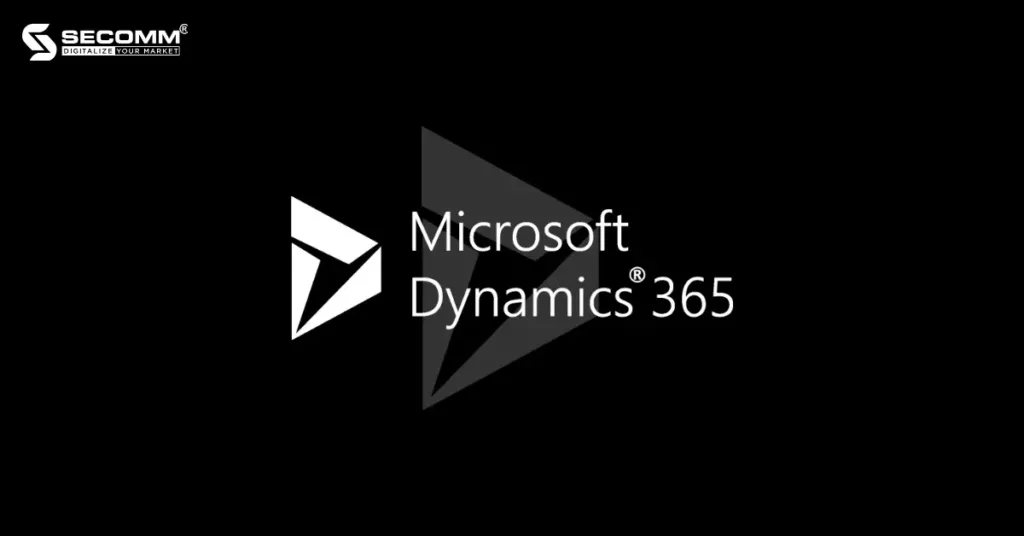
Key Features:
- Supply Chain Management: Enterprises establish an intelligent and automated supply chain by harnessing real-time, in-depth data insights that aid in forecasting, planning, and inventory management.
- Commerce Management: Businesses enable customers to make purchases anywhere, anytime, and on any device by facilitating consistent interactions across online and offline channels.
- Marketing Management: Companies can predict, create, and distribute content through appropriate channels while delivering personalized customer experiences.
- Intelligent Order Management: Streamlining and automating order fulfillment processes using AI technology and real-time omnichannel inventory reporting. Additionally, it proactively addresses order disruptions by restructuring order flows.
- Customer Data Management: Utilizes AI to gather and analyze customer data, revealing new insights while maintaining a balance between personalized experiences and data security. Leveraging these insights, businesses enhance campaigns to boost customer retention and loyalty.
- Customer Service Management: Connects with customers across all engagement channels, addressing inquiries via chatbots and remote portals. Centralizes relevant data on a single dashboard, optimizing costs and enhancing decision-making for future requirements.
Pros:
- Smooth integration with other Microsoft products.
- Seamless operation of interconnected modules, spanning from marketing and commerce to supply chain.
- Automated workflows empowered by AI technology.
- Highly adaptable and scalable, aligning with business expansion needs.
- Cloud ecosystem facilitates effortless connectivity to on-premise systems across devices with internet access.
- Comprehensive reporting and in-depth analysis bolster data-informed decision-making.
- Trial support enables businesses to evaluate suitability before full deployment.
Cons:
- The software’s utilization of AI technology and advanced functionalities demands specific knowledge and skills for successful implementation, contributing to intricate and time-consuming deployment processes.
- Module costs are relatively elevated, ranging from $50 to over $1000 per user per month. Thus, businesses should make the most of the trial version to ensure alignment with needs and budget.
- Storage capacity restrictions might necessitate supplementary purchases, incurring additional expenses.
Cost:
Businesses can avail of a free 30-day trial of Microsoft Dynamics 365. Depending on the module, the software offers two pricing categories:
- First Dynamic 365 app
- Subsequent qualifying Dynamic 365 app
Subsequent pricing is applicable solely to individuals licensed to utilize the first app.
As an example, in the Financial Management module:
- The initial app license cost is $180 per user per month.
- Subsequent pricing for additional apps, for users already licensed for the first app, stands at $30 per user per month.
For detailed pricing information on other modules, businesses can refer to Microsoft Dynamics 365’s pricing page.
The aforementioned is a summary of 6 eCommerce ERP software options tailored for large-scale businesses, showcasing their unique features and respective strengths and weaknesses.
To gain a more comprehensive insight into ERPs and to select the ERP software that best suits your business requirements, contact SECOMM or call the SECOMM Hotline (02871089908) for a free consultation.
 2
2

 7,361
7,361

 0
0

 1
1
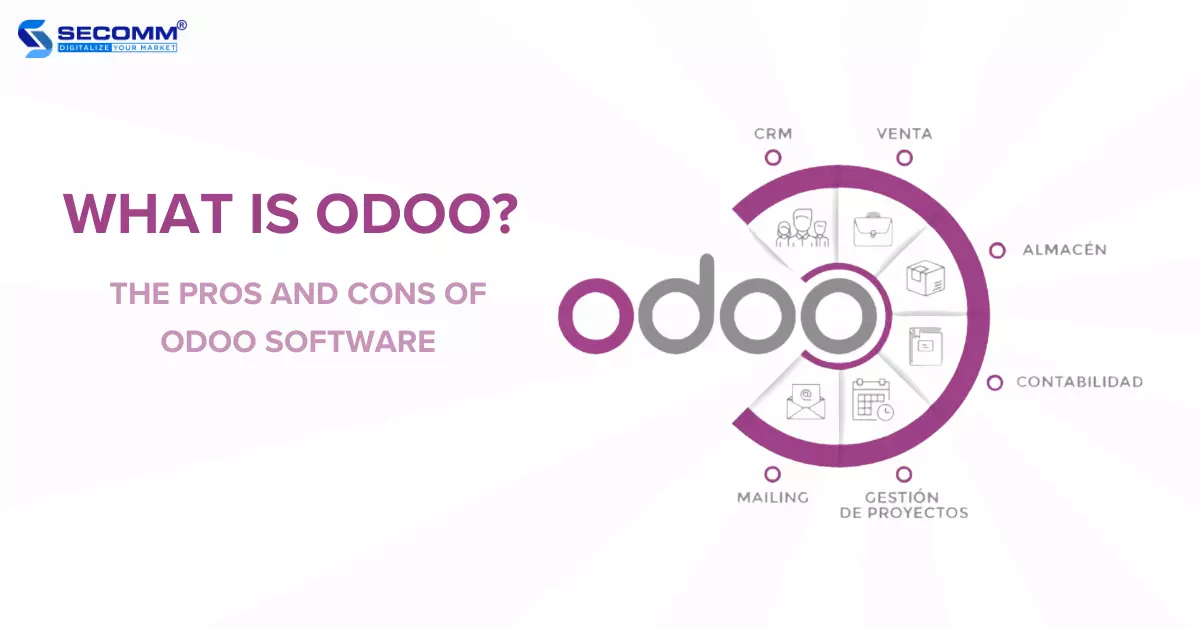
WHAT IS ODOO? TOP 10 PROS AND CONS OF ODOO SOFTWARE
In today’s landscape, ERP software plays a pivotal role in the efficient management and operation of eCommerce activities. Among them, Odoo ERP stands out as pre-configured management software, tailor-made for businesses for easy downloading and utilization, providing a range of solutions to support various business facets like sales, marketing, inventory, customer service, and more. The subsequent article aims to elucidate the concept of Odoo ERP and delve into its strengths and weaknesses when integrated within enterprises.
What is Odoo?
Odoo, also known as Odoo ERP and previously called OpenERP, is a versatile open-source business management software. It comes with complete integration and customization capabilities, catering to offer a comprehensive solution for overseeing diverse facets of eCommerce operations.
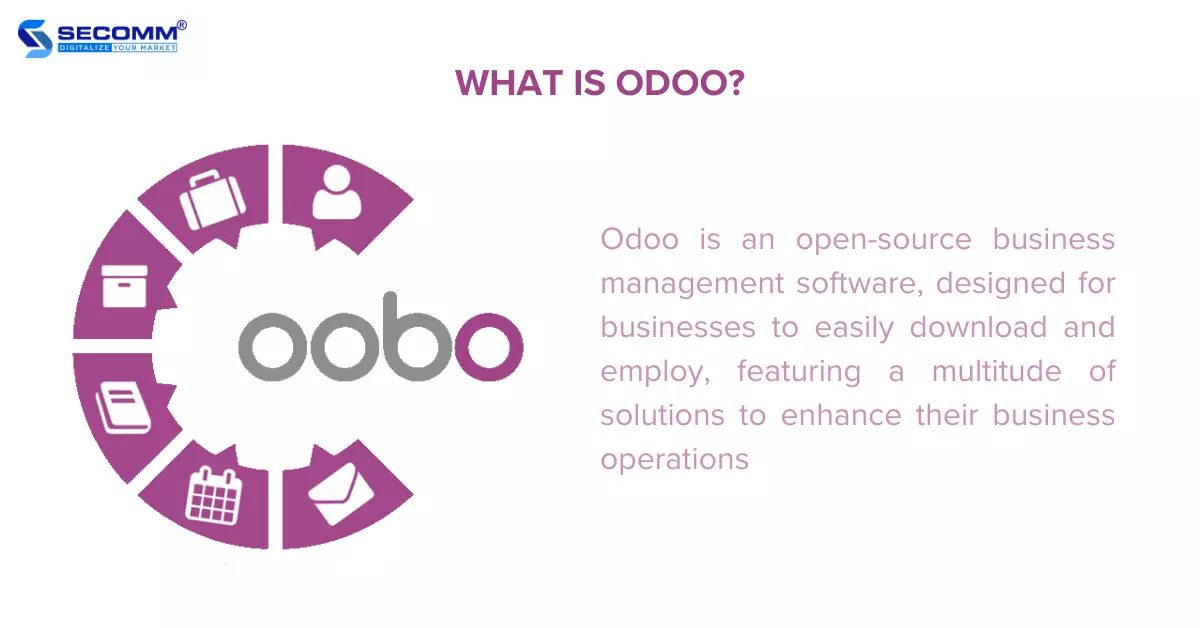
Among its noteworthy functionalities are sales and marketing management, customer relations, project oversight, manufacturing, inventory control, accounting, human resource administration, customer service handling, and a plethora of other applications. As a result, Odoo is adept at fulfilling the real-world business requirements of enterprises spanning all sizes and budget ranges, across many industries.
Odoo Versions & Editions
Versions
There are various editions of the Odoo software, with the most recent being Odoo 16; additionally, Odoo 17 is anticipated for release towards the end of 2023. With respect to version 16, the development team has incorporated numerous features and tools to bolster business efficiency, concurrently concentrating on refining a host of existing attributes. Odoo 16 stands as a source of pride, being the swiftest, most visually appealing, and intuitively designed version.
Editions
The Odoo management software is available in two primary editions that every business should thoroughly explore before implementation.
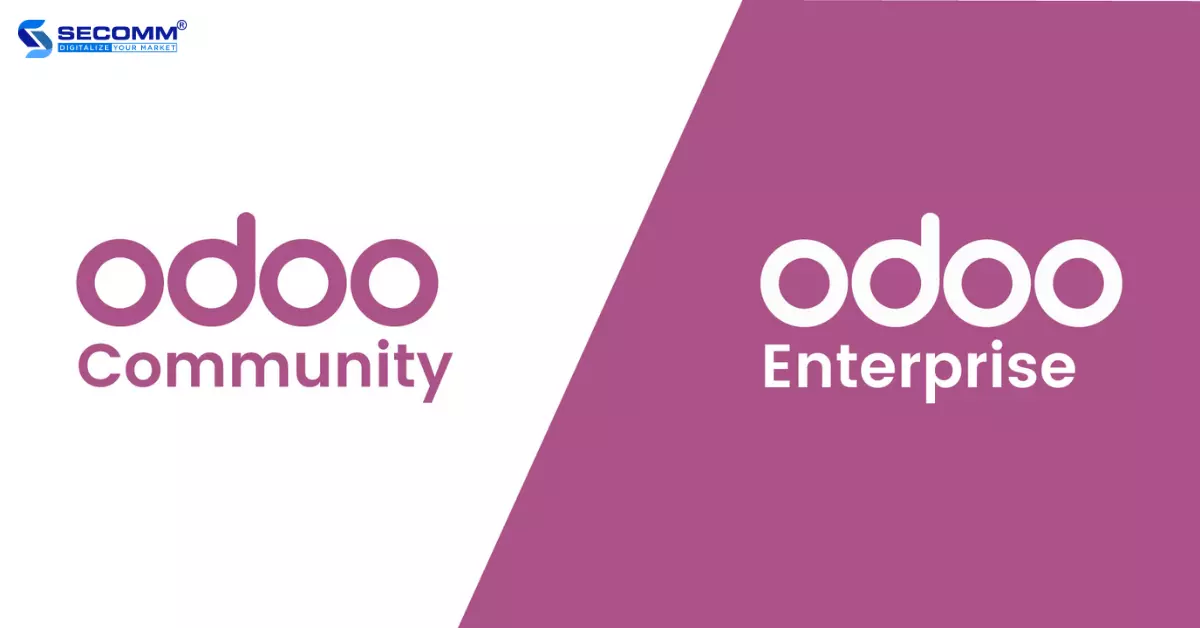
- Odoo Community Edition (Free Version)
This version of Odoo is free for users to download and use. The Odoo Community edition offers a wide range of features and modules that support essential business operations such as sales management, marketing, customer relationship management, inventory management, accounting, and more.
- Odoo Enterprise Edition (Paid Version)
The Odoo Enterprise edition is a premium, paid version with multiple editions tailored to businesses of all sizes. The Enterprise edition is designed to provide advanced features and modules that enhance operational workflows. The cost of the Odoo Enterprise edition is determined by five factors: the number of users, the number of utilized apps, hosting type, deployment services, and integration with third-party systems.
Pros of Odoo
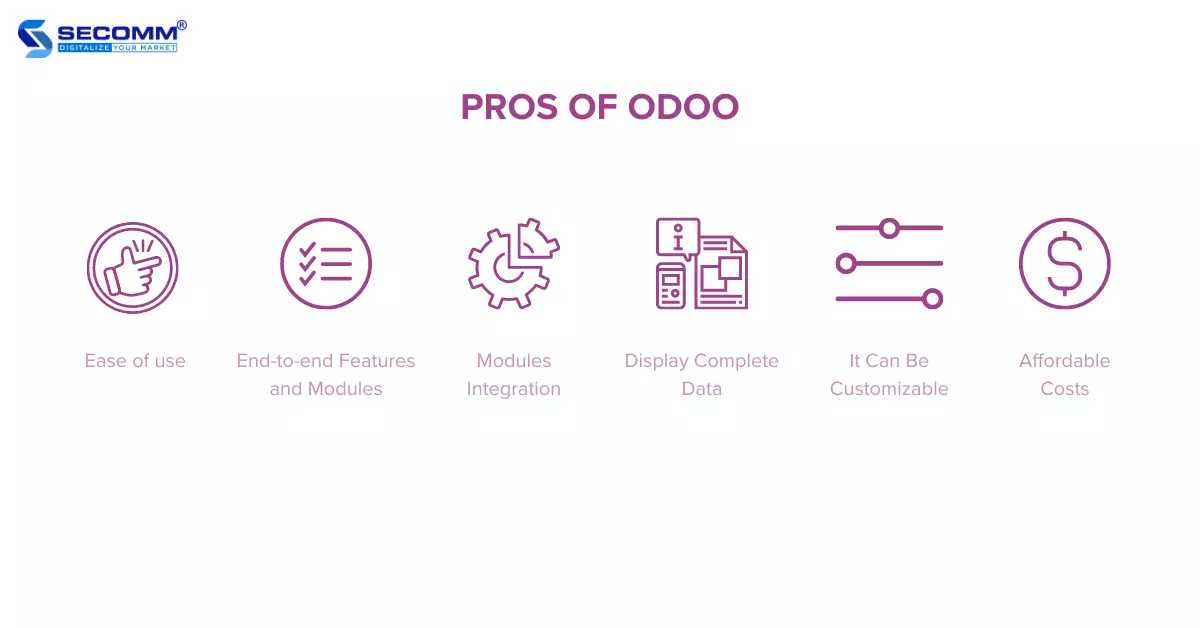
Ease of use
The Odoo interface boasts a simple and intuitive design, with modules logically and systematically organized. As a result, new users will quickly become proficient without investing an excessive amount of time.
End-to-end Features and Modules
Odoo offers an expansive array of features and modules, spanning from fundamental to advanced, to address all requirements for effective business management and operations. These encompass tasks such as sales management, marketing, customer support, accounting, inventory control, and manufacturing.
As businesses embark on Odoo implementation, they can initially utilize the complimentary Community edition and subsequently migrate to the paid Enterprise edition, unlocking the full spectrum of capabilities, modules, services, and progressive enhancements.
Modules Integration
Previously, businesses used to store information and data within individual department databases, leading to challenges in accessing and sharing information across departments. With Odoo, apart from providing the necessary modules for management and operations, it also aids businesses by integrating and storing data from all departments in a unified database, facilitating quicker and more convenient management and tracking.
Display Complete Data
Besides storage and integration, Odoo also holds the advantage of presenting comprehensive information. For instance, the ability to showcase detailed and complete data assists businesses in effectively managing product inventory levels on a daily or monthly basis, encompassing future shipments that have not yet been recorded.
Moreover, businesses can better control working capital by gaining insight into their inventory status. Furthermore, the availability of all information in a unified database fosters collaboration and streamlines the accomplishment of complex tasks. This results in improved workflow processes, enabling businesses to effortlessly monitor interdepartmental processes with efficiency.
It Can Be Customizable
Another benefit of Odoo software pertains to its customization potential. Odoo allows users to tailor the software to their requirements without the necessity of writing code. Thanks to its intuitive and user-friendly interface, individuals without extensive programming skills can also make adjustments.
Affordable Costs
Comparatively, the cost of utilizing Odoo is quite reasonable in comparison to other ERPs. For businesses with a single function requirement, there is no charge for using Odoo, allowing for long-term usage. However, when utilizing two or more functions, businesses receive a 15-day trial period, followed by a moderately priced subscription.
Costs escalate further if the customization and programming of additional modules are aligned with the business’s direction are required. If a business possesses an internal team to perform these tasks, the development costs can be avoided. In practice, businesses will need to seek support from specialized Odoo experts.
Cons of Odoo
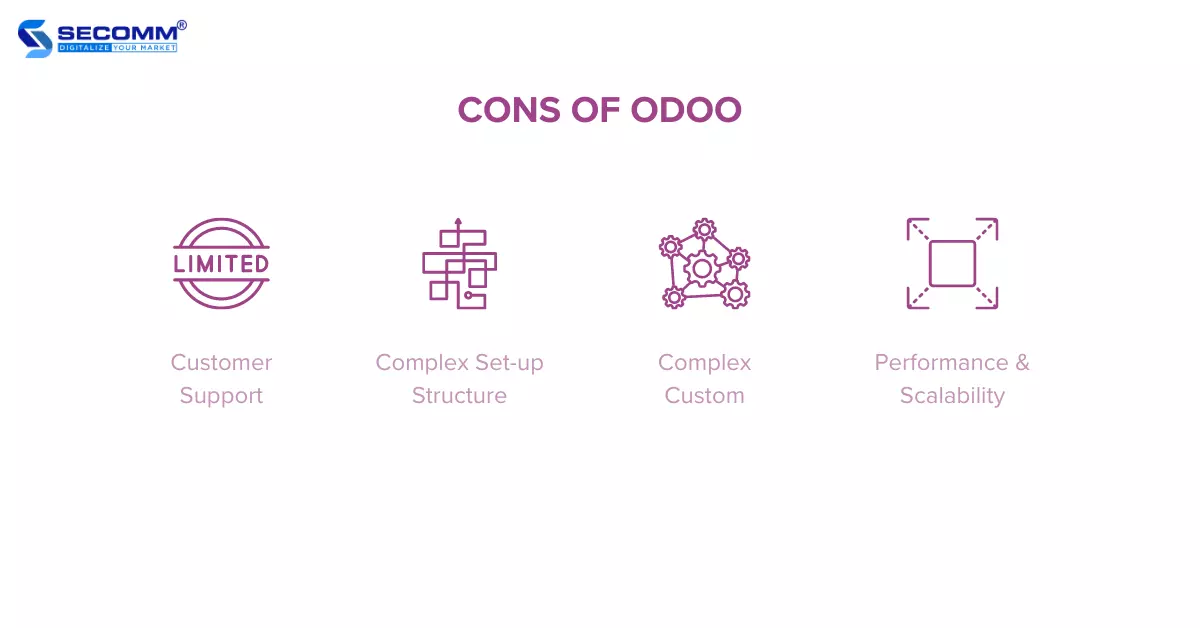
Customer Support
Because of constrained resources and a vast user base, Odoo is unable to offer top-notch customer support to every client. Certain customers have found themselves dissatisfied as their concerns weren’t entirely resolved during their initial support interactions. Furthermore, the cost of Odoo training is quite substantial, rendering it unfeasible for small businesses to establish a specialized Odoo support team.
Complex Set-up Structure
Much like other present-day ERP software, Odoo’s structure can pose difficulties during the initial setup for businesses adopting it for the first time. This can result in a time-consuming and effort-intensive process of addressing setup-related issues
Complex Custom
While Odoo provides numerous built-in functionalities, being a universal ERP solution for diverse business models worldwide means that adapting Odoo to a particular business type or a specific country requires customization.
Odoo does offer customization options, but for highly specific or complex customization requirements, it might necessitate developers with extensive technical expertise and experience. This could potentially lead to extra costs for customization and overall maintenance.
Performance & Scalability
Although Odoo can meet the deployment requirements for a variety of business scales, its performance, and scalability may raise considerations for larger enterprises with substantial transaction volumes. Hence, businesses should strategize their development and assess scalability aspects prior to choosing, ensuring effective operations.
With many years of eCommerce deployment and integration of various ERP systems for numerous global enterprises, SECOMM comprehends the challenges businesses face when implementing the Odoo ERP system.
Contact SECOMM or call the Hotline (02871089908) now to receive consultation on Odoo implementation.
 2
2

 10,742
10,742

 0
0

 1
1
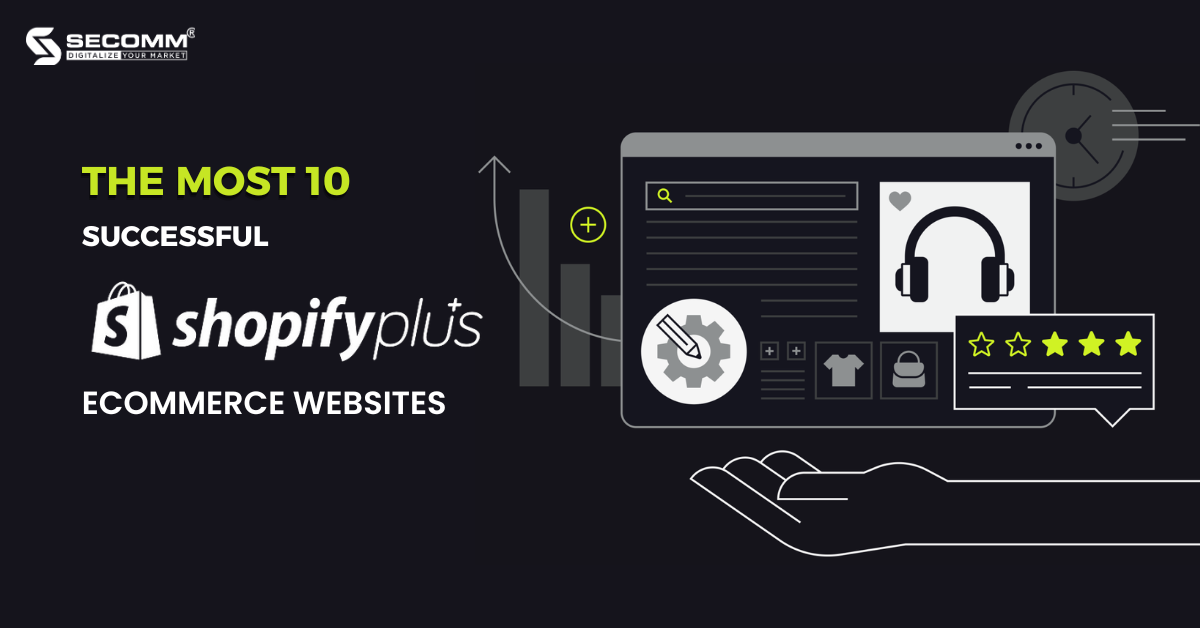
THE MOST 10 SUCCESSFUL SHOPIFY PLUS ECOMMERCE WEBSITES
Shopify Plus is one of the most popular eCommerce platforms tailored for large-scale enterprises experiencing rapid growth. Currently, there are more than 27000 live webstores based on this platform.
Below, we highlight 10 brands that have achieved remarkable success in captivating customers through their online shopping experience by deploying eCommerce websites using Shopify Plus.
Kylie Cosmetics
The success of the Kylie Cosmetics brand lies on the fame and influence of Kylie Jenner on social media along with the smart business strategy that focuses on leveraging the power of eCommerce.

The brand chose to build their eCommerce website on Shopify Plus platform with a design that emphasizes simplicity, using pink and white as the main color tones. In addition, their website only displays products from the collection that they are currently promoting. This is also their core business strategy – they limit the quantity of products sold to target the customers’ FOMO mentality.
- Website: https://kyliecosmetics.com/
- Industry: Cosmetics
- Traffic: 572.7K/month
- Ranking: 23,944 (USA) & 89,414 (Worldwide)
GymShark
Another famous brand that deploys their Shopify Plus eCommerce website is GymShark. Established in 2012, the brand specializes in providing accessories and sportswear, with an initial value was around 1 million USA. Over the years, GymShark ultimately becomes a billion-dollar brand and makes their presence known in over 131 markets.
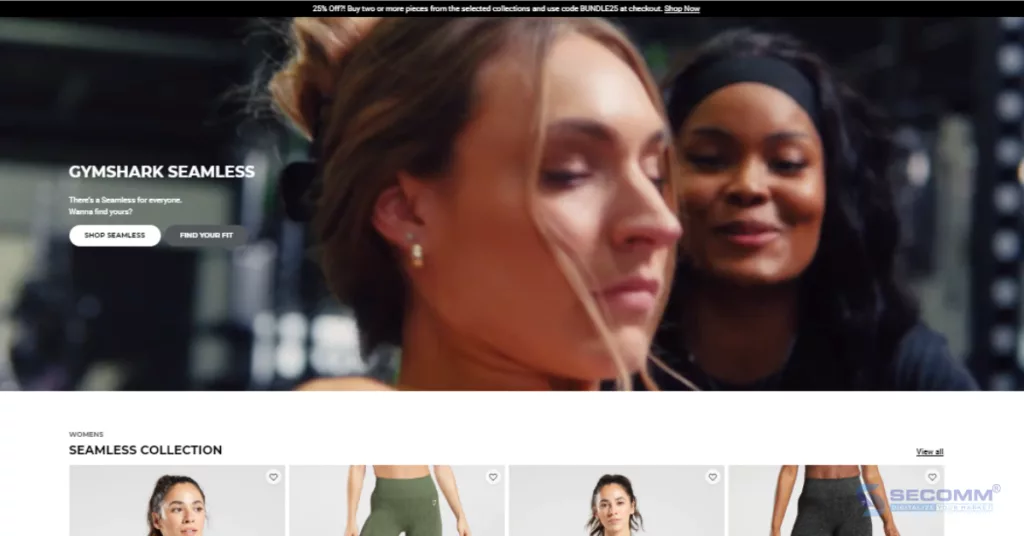
The GymShark website showcases an extensive product catalog for men, women, and children, offering a wide range of styles and sizes. Moreover, the brand integrates Instagram into their website to reach and engage with the growing users of this social media platform. Also, GymShark leverages their Instagram account to create outfit mix-and-match inspiration, using their own products, thereby encouraging purchases.
- Website: https://us.shop.gymshark.com/
- Industry: Sportswear
- Traffic: 8.2M/month
- Ranking: 2,706 (USA) & 4,927 (Worldwide)
Fashion Nova
Fashion Nova is a well-known fashion brand in North America and Europe, offering a wide range of fashion products and accessories for men, women, and children, with diverse styles, colors, and sizes that conform to the US-UK. fashion standard. In 2018, Fashion Nova topped the list of the most searched fashion brands on the internet.

Their eCommerce website is based on the Shopify Plus platform, enabling it to handle a massive amount of traffic, approximately 25.5 million visitors per month. The website features all the necessary functionalities with a distinct design specific to the fashion industry. Furthermore, Fashion Nova regularly releases new seasonal collections accompanied by enticing promotions to attract customers to shop on their website.
- Website: https://www.fashionnova.com/
- Industry: Fashion
- Traffic: 25.5M/month
- Ranking: 349 (USA) & 1,471 (Worldwide)
Cettire
Cettire is one of the leading online retailers of luxury fashion in Australia. The brand specializes in providing clothing, footwear, and accessories from over 1300 renowned luxury brands worldwide, such as Saint Laurent, Prada, Balenciaga, Gucci, and more. In 2020, Cettire was listed on the Australian Securities Exchange (ASX), with a total revenue of 124 million AUD for the fiscal year 2021.
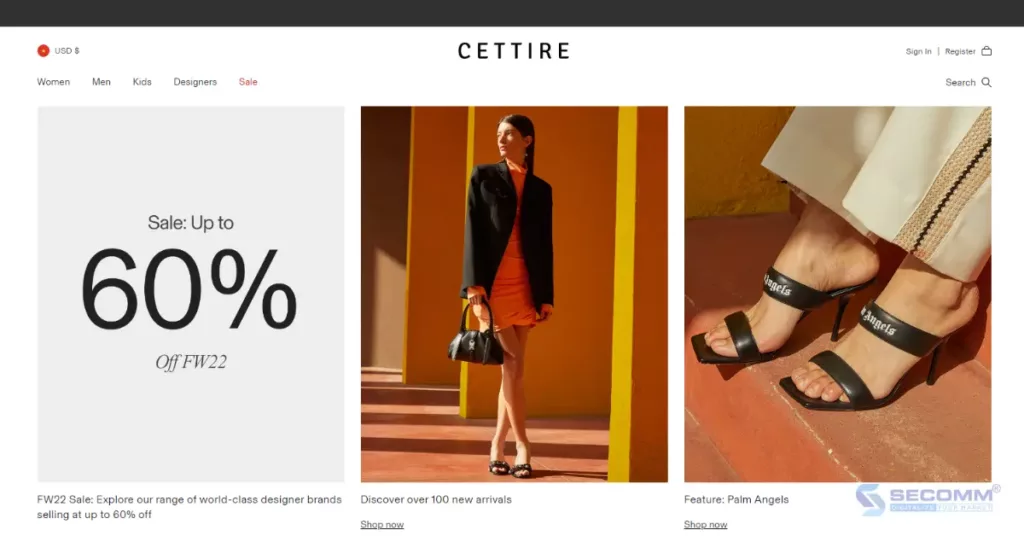
The brand built their eCommerce website with the Shopify Plus platform. This helps the website attract the attention of fashion enthusiasts everywhere, not only because it is a destination for online shopping of luxury fashion brands but also because of its minimalist yet modern design with captivating videos and graphics.
- Website: https://www.cettire.com/
- Industry: High-end fashion
- Traffic: 4M/month
- Ranking: 7,189 (USA) & 11,333 (Worldwide)
Decathlon Viet Nam
Decathlon has a vast product catalog that can meet every need for sports training, ranging from gym clothes, running shoes, swimming goggles, and camping tents, to hiking backpacks. Therefore, it’s not surprising that Decathlon chose Shopify Plus to develop its eCommerce website to leverage the platform’s flexible customization and high scalability.
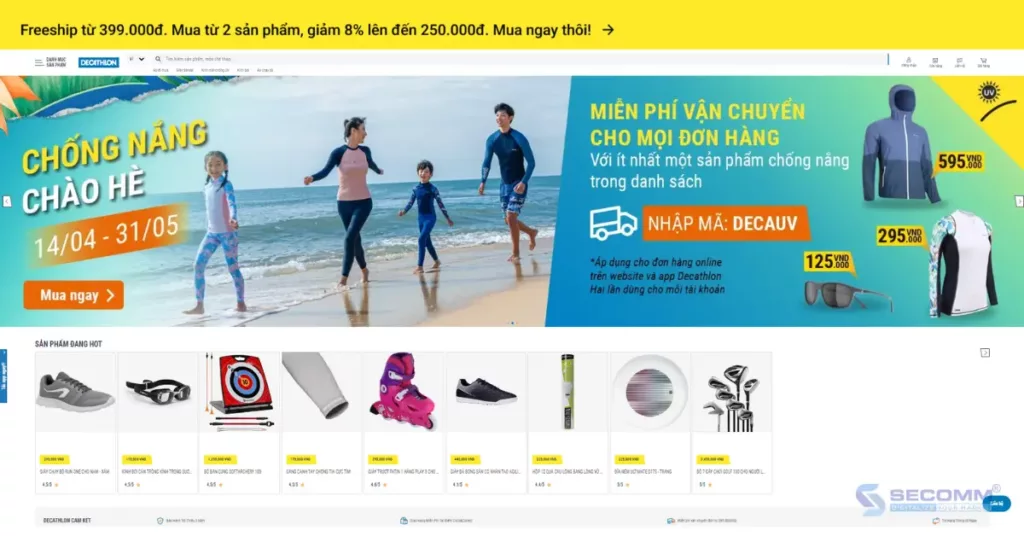
To keep up with the digital transformation trend, Decathlon places special emphasis on two sales channels: the website and the app, offering attractive promotional programs exclusively for customers who make purchases through these channels. Additionally, Decathlon integrates multiple payment methods and utilizes SSL encryption to ensure a safe and efficient online shopping experience.
- Website: https://www.decathlon.vn/vi
- Industry: Sportswear and accessories
- Traffic: 461M/month
- Ranking: 1,873 (Vietnam) và 91,416 (Worldwide)
Supersports
Supersports is the next sportswear and accessories brand on the list that uses Shopify Plus for its eCommerce website. It is a reliable shopping destination for genuine fashion items from major brands such as Puma, Under Armour, Fila, Crocs, Adidas, Nike, and more.

The brand regularly offers attractive promotional programs for customers shopping on their website. Also, Supersports dedicates a page on their website for customers to easily check ongoing promotional activities at their outlets. To ensure customers don’t miss out on any shopping deals, the company implements an exit popup that encourages customers to sign up and receive information about new products, special offers, and vouchers via their email.
- Website: https://supersports.com.vn/en
- Industry: Sportswear and accessories
- Traffic: 866.7M/month
- Ranking: 1,266 (Vietnam) & 63,546 (Worldwide)
Durex Viet Nam
No one is unfamiliar with Durex. In addition to focusing on enhancing their presence on social media platforms, Durex has also invested in developing their eCommerce website meticulously on the Shopify Plus platform to enrich the online shopping experience for their customers.

- Website: https://www.durexvietnam.vn/
- Industry: Health Community
- Traffic: 113,6M/month
- Ranking: 10,716 (Vietnam) & 494,850 (Worldwide)
Swee Lee Viet Nam
Swee Lee is one of the leading music instrument brands in Vietnam. The company’s eCommerce website is built on Shopify Plus, equipped with all the core features to operate and provide customers with the best shopping experience.
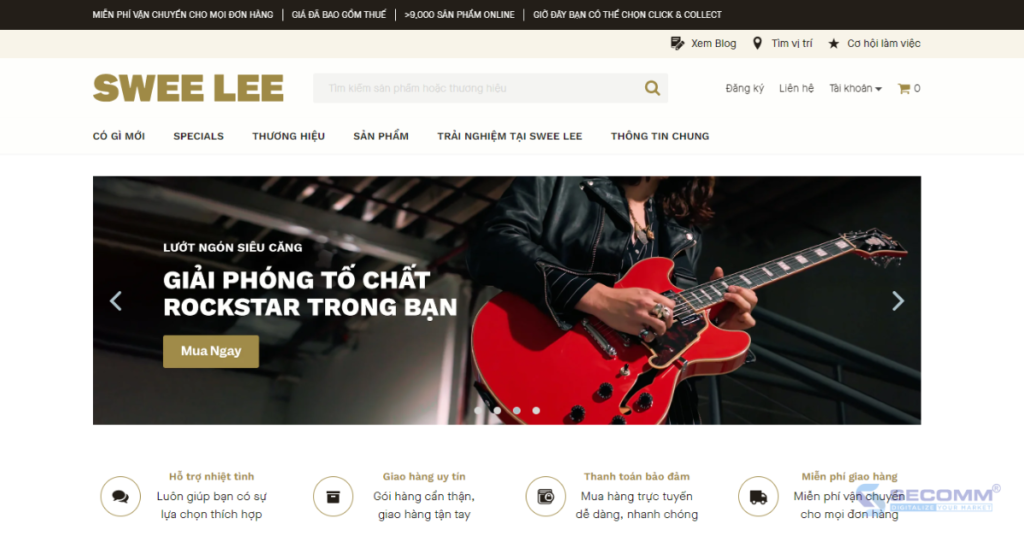
Swee Lee implements an exit popup to collect user emails for email marketing campaigns. The products available on the Swee Lee website are diverse, ranging from guitars, ukuleles, to pianos, with various attributes (e.g. models, prices, and brands).
- Website: https://www.sweelee.com.vn/
- Industry: Music Instruments
- Traffic: 33M/month
- Ranking: 27,269 (Vietnam) & 1,221,800 (Worldwide)
Skechers Viet Nam
The renowned American shoe brand, Skechers, also leverages Shopify Plus to build its eCommerce website. Skechers develops high-quality and comfortable product lines that align with current fashion trends. In addition to footwear for men, women, and children, the brand is also expanding its range to include clothing and accessories.

To encourage customers to shop more on the website, Skechers Vietnam consistently launches attractive promotional programs along with various gifts and vouchers.
- Website: https://www.skechersvn.vn/
- Industry: Footwear
- Traffic: 40,6M/month
- Ranking: 7,568 (Vietnam) & 340,941 (Worldwide)
Trollbeads Viet Nam
The website of Trollbeads, a renowned jewelry brand, is using the Shopify Plus eCommerce platform. As a pioneer in the world of exquisite gemstone jewelry, Trollbeads offers their customers luxurious and intricately crafted high-end jewelry pieces. Both men and women can customize their jewelry, including bracelets, rings, necklaces, and earrings, to suit their preferences, personalities, and individual stories.
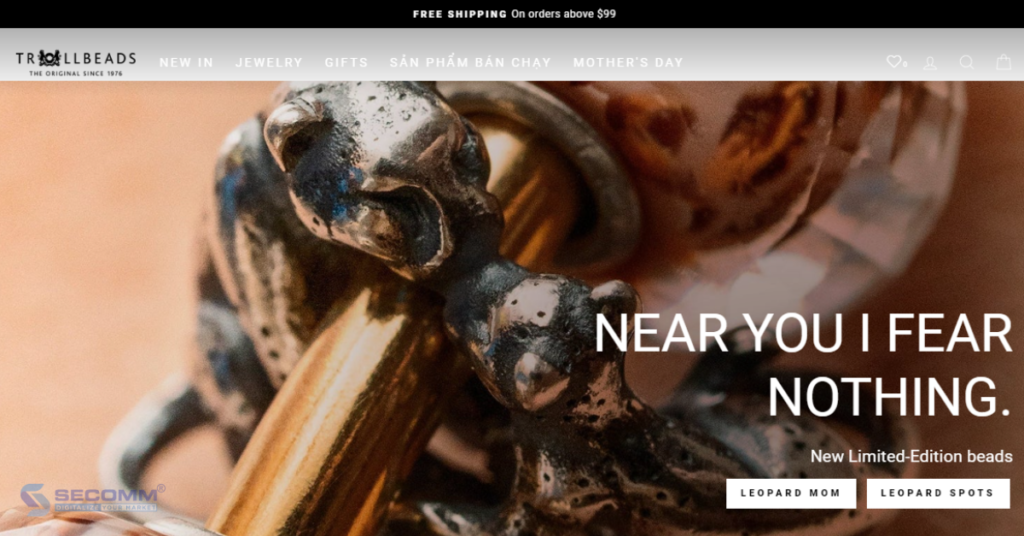
Furthermore, on special occasions, Trollbeads showcases appropriate products on the website to facilitate easy selection for customers. Clear product images presented from multiple angles allow customers to observe the intricate design details and exquisite patterns of each jewelry item. Furthermore, the website has a dedicated section sharing the craftsmanship of artisanal handicrafts, the stories behind the gemstones, and jewelry care.
- Website: https://www.trollbeads.vn/
- Industry: Jewelry
- Traffic: 5.1M/month
- Ranking: 1,237,901 (Vietnam) và 14,795,357 (Worldwide)
SECOMM has listed out 10 successful eCommerce websites using the Shopify Plus platform, which have conquered customers and become leaders in their respective fields.
Related article: Shopify Plus vs Adobe Commerce: Key differences 2023
With years of experience successfully implementing eCommerce solutions for clients in multiple countries, SECOMM specializes in providing consulting services with comprehensive eCommerce deployment solutions.
Contact SECOMM or call our hotline (+842871089908) today to receive free support and consultation.
 2
2

 7,195
7,195

 0
0

 1
1
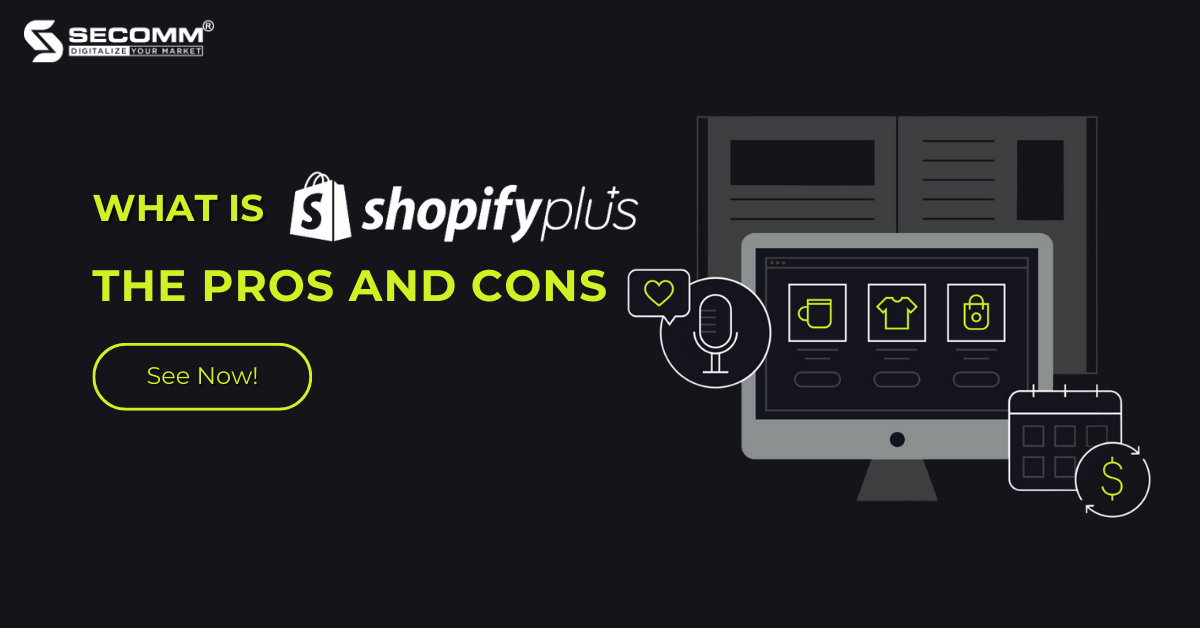
WHAT IS SHOPIFY PLUS? 9 KEY PROS AND CONS OF SHOPIFY PLUS
Shopify represents a trustworthy name in eCommerce development and is the choice of many SMEs. However, for enterprise-level businesses with rapid growth, the standard Shopify plans may not meet their needs sufficiently, in addition to incurring high operational and website maintenance costs. Therefore, Shopify Plus emerged to address these aforementioned issues.
What is Shopify Plus?
Introduced in 2014, Shopify Plus is an enterprise-level eCommerce platform provided by Shopify. Shopify Plus is designed for large businesses with an annual GMV exceeding $1 million and high growth rates.
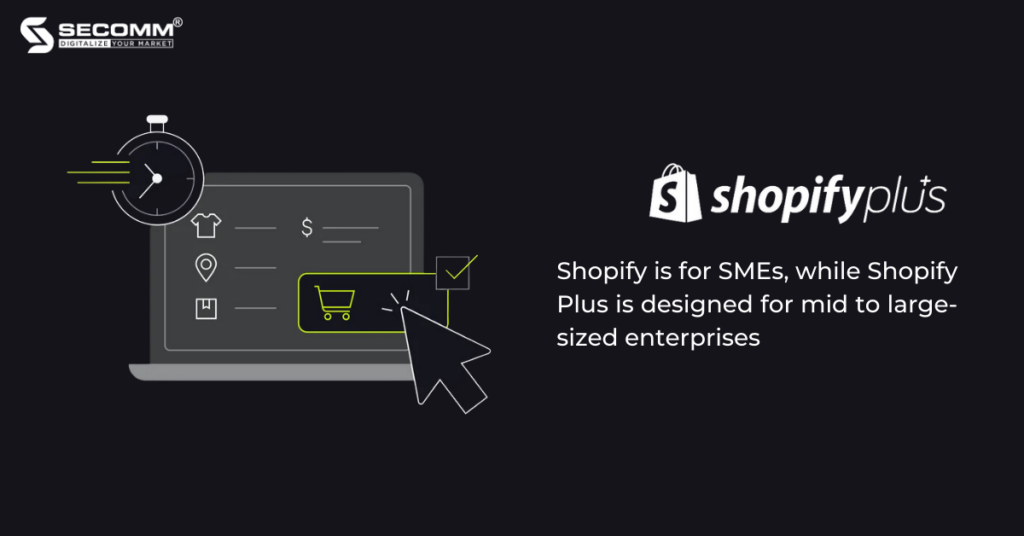
Simply put, Shopify is for SMEs, while Shopify Plus is designed for mid to large-sized enterprises. Some notable global companies implementing Shopify Plus include Gymshark, Kylie Cosmetics, Redbull, Fashion Nova, Fenty Beauty, and more. In Vietnam, leading brands such as Durex Vietnam, Skechers Vietnam, Trollbeads Vietnam, Supersports, Swee Lee, and others have chosen Shopify Plus.
Key differences between Shopify and Shopify Plus
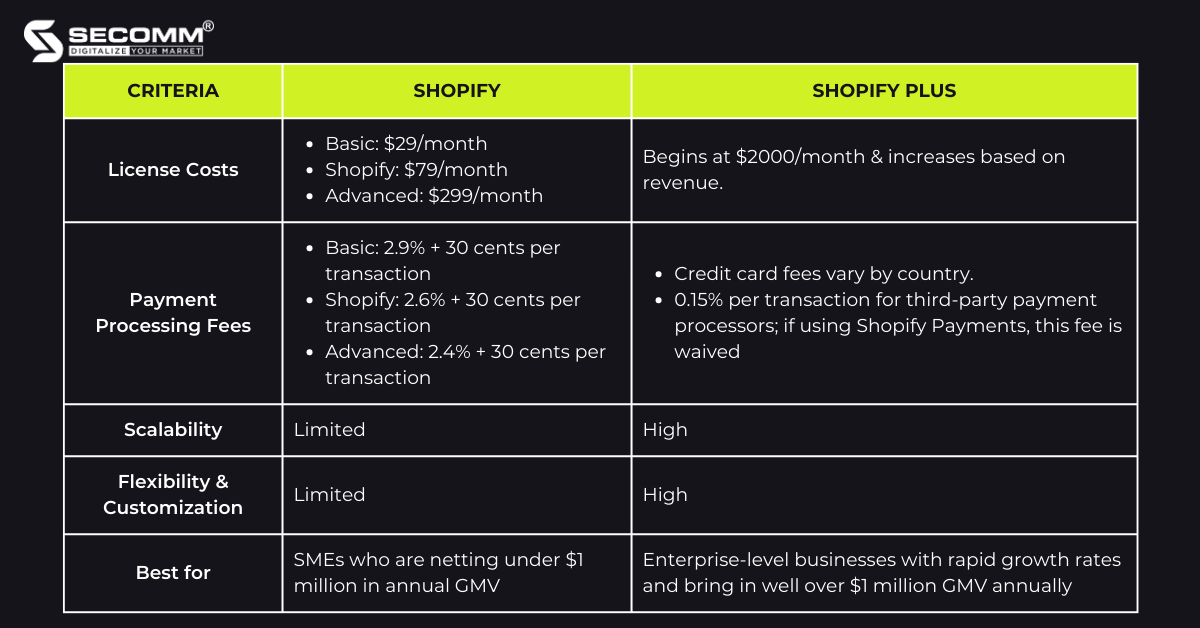
The Pros of Shopify Plus
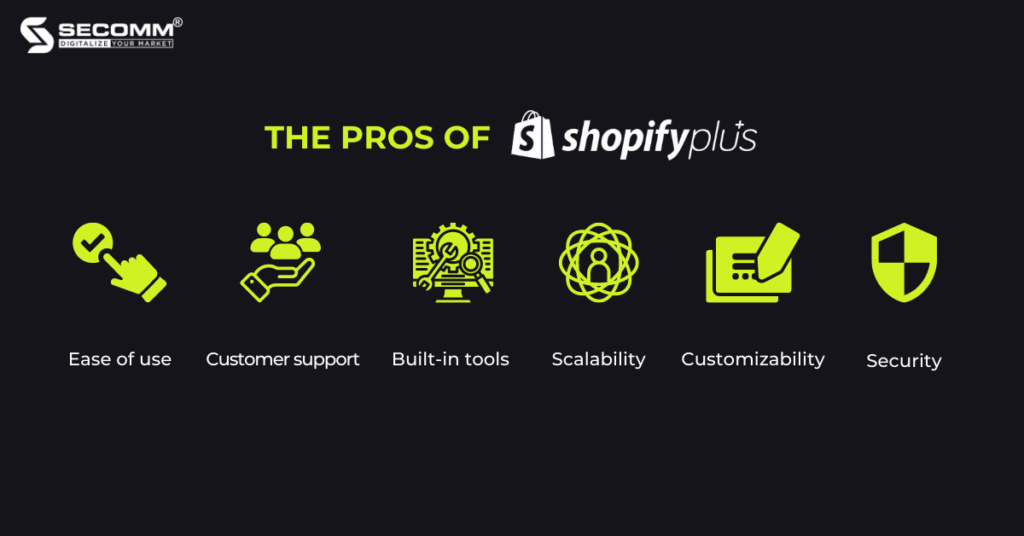
Ease of use
Due to its nature as a SaaS eCommerce platform, Shopify Plus is designed to be user-friendly, allowing businesses to quickly build and operate their websites with no coding knowledge required.
Moreover, by using Shopify Plus, businesses won’t worry much about server management, security, or website updates and maintenance. The platform helps them save a significant amount of time and focus on more critical tasks such as sales, marketing, and customer service.
Customer support
Shopify Plus provides top-notch customer support 24/7 and a dedicated account manager, which can help businesses address any queries through email, chat, and a hotline. It is great as large enterprises may have complex needs and require personalized support.
Built-in tools
The built-in tools are another advantage of Shopify Plus which supports businesses in building and operating their eCommerce websites. Among them, product management, inventory tracking, payment processing, shipping, tax calculation, advanced analytics, and more are notable.
Additionally, Shopify Plus offers numerous customizable templates and apps, allowing businesses to create modern, professional, and feature-rich eCommerce websites without the technical skills required. Shopify Plus also enables businesses to easily scale as their needs change over time.
Furthermore, Shopify Plus gives businesses full access to Shopify’s exclusive programs such as the Merchant Success Program, Shopify Plus Academy, Shopify Plus Partner Program, and the Shopify Plus community on Facebook.
Scalability
Unlike the standard Shopify plans, Shopify Plus has become a popular choice among large enterprises due to its high scalability. The platform can easily scale up or down depending on the business need which helps deal with increased website traffic and surges in orders during busy shopping periods.
Customizability
Another significant advantage of Shopify Plus lies in its high level of customization, allowing businesses to tailor their eCommerce websites to specific needs such as customizing templates, apps, payment integration, and more. As a result, the eCommerce website is built with uniqueness and creativity, highlighting the brand image and providing customers with an excellent shopping experience. The platform’s customizability has made it a powerful tool for driving online sales and sustainable growth.
Security
Security is a top priority for eCommerce businesses, especially for large enterprises. Shopify Plus is a PCI-compliant platform that meets the data security standards of payment cards, ensuring that all payment transactions processed through this platform are secure. All customer data is encrypted using SSL to protect sensitive information from unauthorized access. Additionally, Shopify Plus integrates a DDoS protection feature, safeguarding against dangerous attacks that can disrupt website traffic and accessibility.
The Cons of Shopify Plus
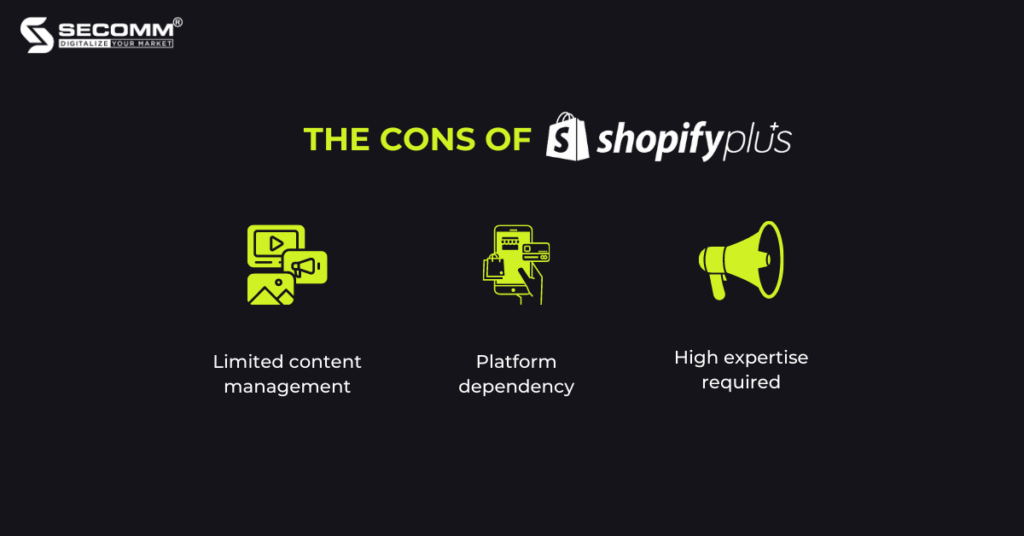
Limited content management
Content management is not a strong suit of both Shopify and Shopify Plus compared to other platforms, especially WordPress. First is the limited blogging functionality, which makes it difficult to create and manage blog categories on the website. Moreover, if the content is a core element of the marketing strategy, this limitation should be carefully considered as it can significantly impact SEO optimization. Another limitation is the lack of control over the URL structure of product pages, which poses challenges in optimizing URLs for search engines.
Overall, while Shopify Plus provides many features for businesses to build and manage eCommerce websites, if content management is a priority, it may be worth considering other platforms that offer more advanced content management capabilities.
Platform dependency
If businesses build their websites based on an open-source platform, the platform migration is relatively simple and they can fully own the source code and all data.
On the contrary, Shopify Plus is a SaaS platform, and the entire website system of the business is hosted on Shopify’s servers, which means ownership and control of the source code and data belonging to Shopify Plus. This means that data related to eCommerce activities on the website is tightly locked-in to Shopify’s database. This leads to two issues:
- Vendor risk:
Suppose Shopify goes bankrupt or faces unforeseen risks. In that case, the entire business operations on this platform would be lost, and it would not be possible to retrieve all the latest data. However, this risk is unlikely to occur.
- Data export:
In the event of discontinuing the use of Shopify and switching to another platform, the business can export data to a CSV file containing information such as product details, customer accounts, inventory, orders, etc. However, the data that Shopify allows to be accessed and exported is not comprehensive but only a portion of it.
High expertise required
Although Shopify Plus is considered user-friendly and suitable for users with strong technical skills, large enterprises need a certain level of expertise to effectively implement eCommerce with Shopify Plus. Because it is a highly customizable platform, businesses will need to have some understanding or collaborate with experienced developers to maximize the platform’s features and capabilities.
Pricing
The cost of using Shopify Plus will be based on revenue. Initially, each business will pay a minimum of $2000/month for standard setup and integration. Once the revenue reaches $800,000/month, Shopify Plus will charge the business based on revenue, at a rate of 0.25% of the monthly revenue. However, the fee will not exceed $40,000/month or $480,000/year
Advantages
At first glance, this may seem like a large amount of money but for enterprise-level businesses, this pricing is reasonable because Shopify Plus provides a robust eCommerce platform that helps businesses operate more efficiently compared to standard Shopify plans.
- Reason 1:
As mentioned, the main advantage of Shopify Plus lies in its scalability and customizability but it is limited in standard Shopify plans. A growing business will need an eCommerce platform that can meet the demands of expansion and development. Shopify Plus is designed to handle high sales volumes and can support 10,000 transactions per minute. Additionally, businesses can customize their eCommerce website and leverage built-in features and tools to optimize their operations and sales.
- Reason 2:
Another advantage of Shopify Plus is that businesses do not have to pay for hosting, bug fixes, maintenance, or updates. The additional fees that businesses need to pay are transaction fees, specifically:
Credit card transaction fees that businesses have to pay to Shopify Plus will vary depending on the country but typically range from 1.5% to 2.5% per transaction.
In addition, Shopify Plus will charge a small fee of approximately 0.15% for transactions with third-party payment gateways, but this fee is waived if the business uses Shopify Payments as a payment method.
Compared to the three standard Shopify plans, the credit card transaction fees of Shopify Plus are still relatively low, with the following differences:
- Basic ($29/month): 2.9% + 30 cents per transaction
- Shopify ($79/month): 2.6% + 30 cents per transaction
- Advanced ($299/month): 2.4% + 30 cents per transaction
- Shopify Plus (starting from $2000/month): 2.15% + 30 cents per transaction (fee applied for the US market)
→ It can be seen that compared to the highest-tier standard Shopify plan – Advanced, the credit card transaction fees of Shopify Plus will save businesses 0.25%.
Now look at the transaction fees with third parties:
-
- Basic: 2% per transaction
- Shopify: 1% per transaction
- Advanced: 0.5% per transaction
- Shopify Plus: 0.15% per transaction
→ The difference in fees for transactions with third parties is evident, and Shopify Plus is a better choice.
- Reason 3:
Shopify has a vast app store with over 6000 apps developed by Shopify and third parties. In Particular, there are many apps developed specifically for Shopify Plus. Depending on each business’s needs, the cost of installing apps can range from $0 to a few hundred dollars or several thousand dollars per month.
The basic setup of the Shopify Plus platform is sufficient for businesses to operate their websites. However, to deploy more effectively and provide a better customer experience, businesses may need to install additional Shopify apps, which incur costs. Naturally, with the investment in these apps, businesses will gain equivalent benefits.
Disadvantages
Due to its nature as a SaaS eCommerce platform, businesses will not own the source code and website data, which leads to cost disadvantages. Businesses that have reached the level of using Shopify Plus will have a demand for utilizing features, apps, and tools or integrating with third parties. In addition to the fixed monthly cost of using Shopify Plus, businesses also have to pay monthly additional fees based on their needs. This makes it difficult for enterprise-level businesses to manage their cash flow.
On the other hand, for most open-source platforms, although deployment costs are high and deployment time is long, businesses can make a one-time payment and own the source code, data, and long-term features. Therefore, using open-source platforms will help enterprise-level businesses manage their cash flow more efficiently.
Related article: Shopify Plus vs Adobe Commerce: Key Differences 2023
With many years of experience implementing eCommerce solutions for numerous businesses in different countries, SECOMM understands the potential of Shopify Plus to empower eCommerce operations as well as the challenges and difficulties they may encounter during the initial stage.
Contact SECOMM today or call our hotline (+842871089908) to receive a free consultation.
 2
2

 7,933
7,933

 0
0

 1
1
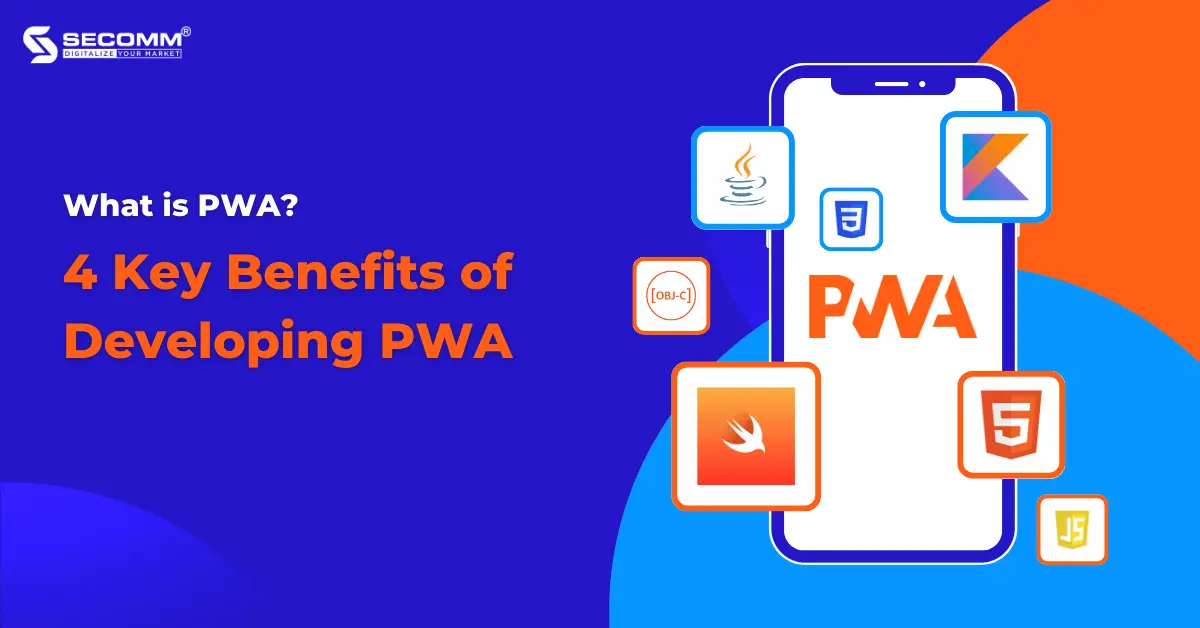
WHAT IS PWA? 4 KEY BENEFITS OF DEVELOPING PWA
Amidst the fierce competition in eCommerce, businesses of all sizes are striving to find breakthrough solutions to enhance customer experience and boost engagement. Among the numerous options available, PWA (Progress Web App) is considered a promising solution that can change the way users interact with an eCommerce website. Although PWA has been in the market for a while, its popularity has only recently surged in recent years.
What is PWA?
A Progressive Web App (PWA) is a type of web application built using standard web technologies such as HTML, CSS, and JavaScript, but can provide users with a similar experience and features to a native app, including push notifications, offline availability, etc.
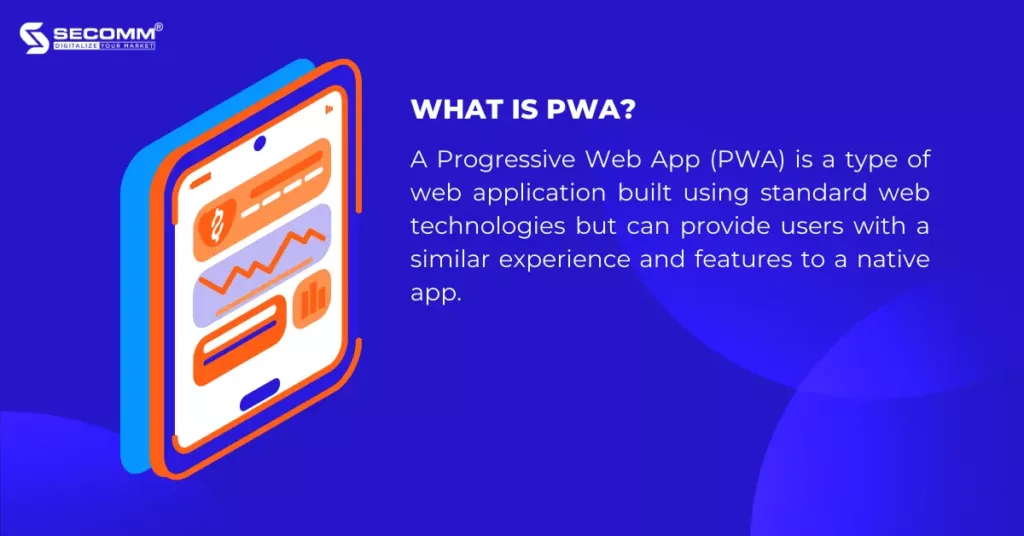
Native apps, what do they actually mean? They are software applications built on a specific programming language for a particular platform or operating system such as iOS or Android.
Because of the differences between the two types of applications, businesses usually rely on their needs and resources to make a suitable choice.
Related Readings: Native App vs Hybrid App: Key Differences
Key Differences: PWA vs Native App
Native apps are typically built using a programming language specific to each particular operating system, such as Objective-C/Swift for iOS and Java/Kotlin for Android. Meaning that developers must have a certain level of experience and expertise to write and develop apps that are suitable for each operating system. Additionally, maintaining and updating app versions must be done regularly, which can be time-consuming and costly.
On the other hand, when developing a progressive web app, developers can use a shared codebase to develop apps for all platforms, making development and maintenance faster and easier than with a native app.
To use Native apps, users need to access app stores such as the Apple’s App Store or Google Play to download and install them, while with progressive web app, users can install them directly from their web browser onto their device without going through an app store.
Although PWA can provide good performance and user experience, it is still generally not as good as native apps. Native apps offer a more seamless and richer user experience than progressive web app because they are designed specifically for a particular platform and can maximize the use of hardware and software features of the device.
Summary:
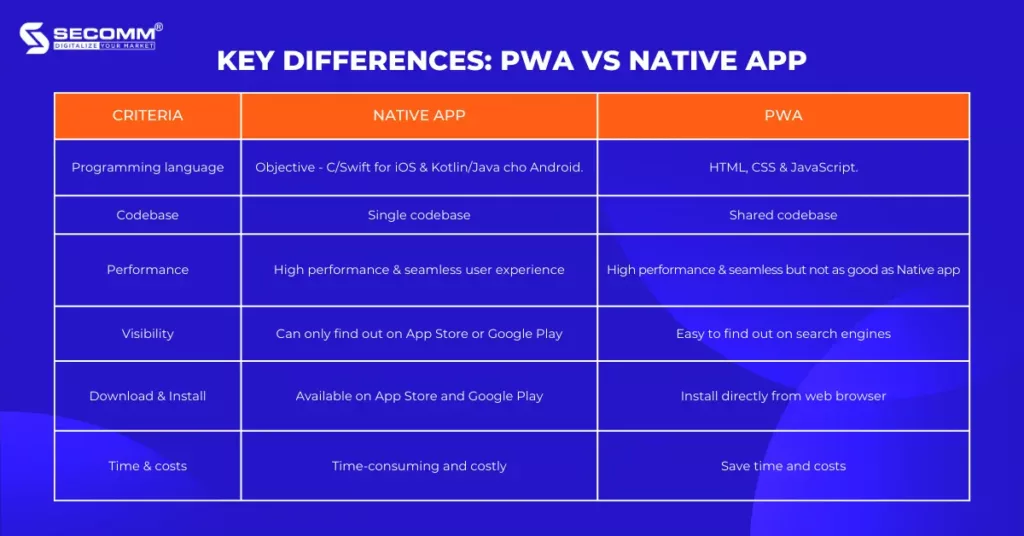
Benefits of PWA
Currently, PWA is becoming very popular and is being chosen by many businesses everywhere in the world for the following benefits:
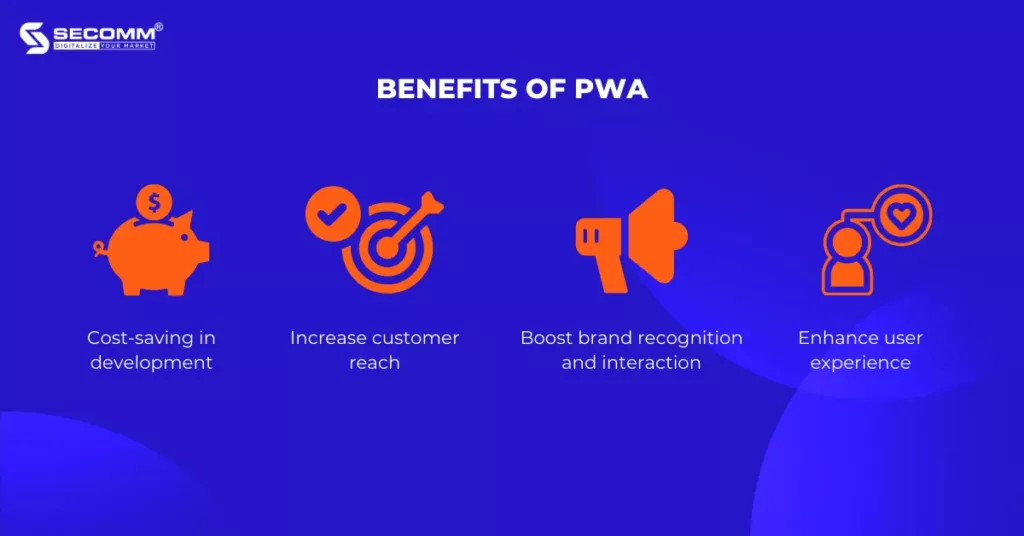
Cost-saving in development
This is the biggest advantage and the main reason why many businesses are turning to PWA. The cost to build and maintain PWA is relatively low compared to native apps because it doesn’t require developing separately for each platform. Moreover, after installation, PWA functions like a native app with no compromise on performance and user experience. Therefore, for businesses with budget constraints, PWA is a worthwhile option to consider in order to save costs and time to launch the product.
Increase customer reach
Since PWA is designed to work efficiently on various devices and platforms such as smartphones, tablets, desktops, laptops, etc., users can access the app through a web browser and install it directly onto the home screen without downloading it from the app store. Therefore, PWA can reach a wider pool of potential customers, allowing businesses to expand their customer reach.
Boost brand recognition and interaction
The “add-to-home-screen” feature of PWA enables customers to easily add the app to their device home screen directly from the web browser. In reality, customers only click on this feature when they browse and find the app interesting and useful for them. Once the app has been added to the home screen, users will easily see and remember the brand. This way, businesses can use targeted marketing methods to encourage customer interaction.
Enhance user experience
Similar to native apps, PWA can also provide a quality user experience with fast page loading time, smooth navigation, and stable performance. In addition, it is capable of quickly responding and operating well on many devices with various screen sizes, helping users view content and products on any preferred device. PWA is developed based on web technologies, which means businesses can track and analyze user behavior in real-time and make data-driven decisions to enhance user experience.
PWA real-world example
Lancôme
Lancôme, the leading high-end cosmetics brand in the world, launched a PWA in 2017 to enhance user experience and improve mobile web interaction. The Lancôme PWA provides features such as an icon on the home screen, push notifications, offline mode, and more. This allows customers to quickly access Lancôme’s website with just one touch, and the company can use push notifications to inform customers about the latest products, promotions, and special offers. In addition, the offline mode allows customers to continue browsing Lancôme’s website even without an internet connection.
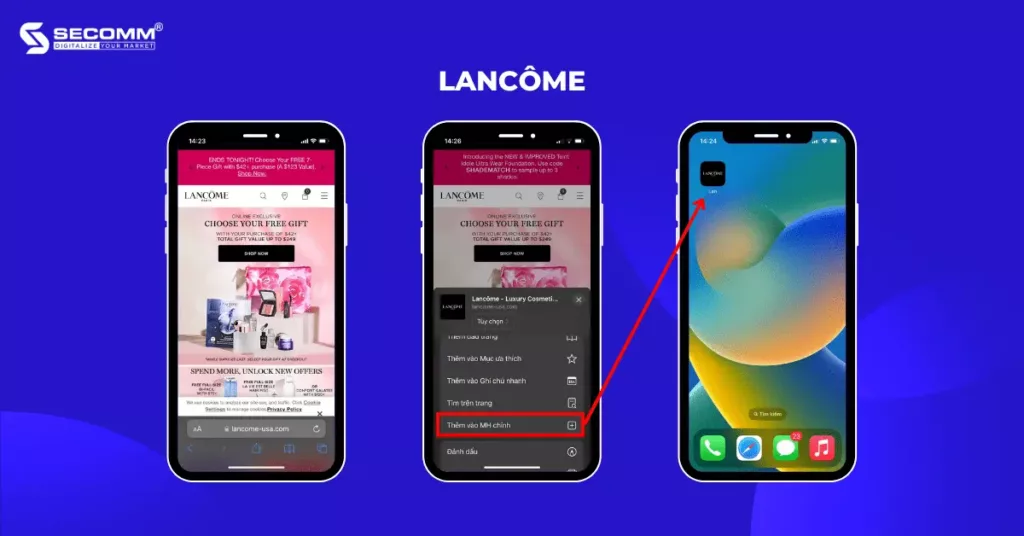
Spotify
The famous online music platform – Spotify, developed and launched their own PWA in 2018 to provide a fast, seamless, and engaging user experience for their customers. Similar to Lancôme, Spotify also offers prominent features including offline music and podcast playback, which helps to ensure an uninterrupted user experience. The Spotify PWA has received positive reviews and feedback from users for many years.
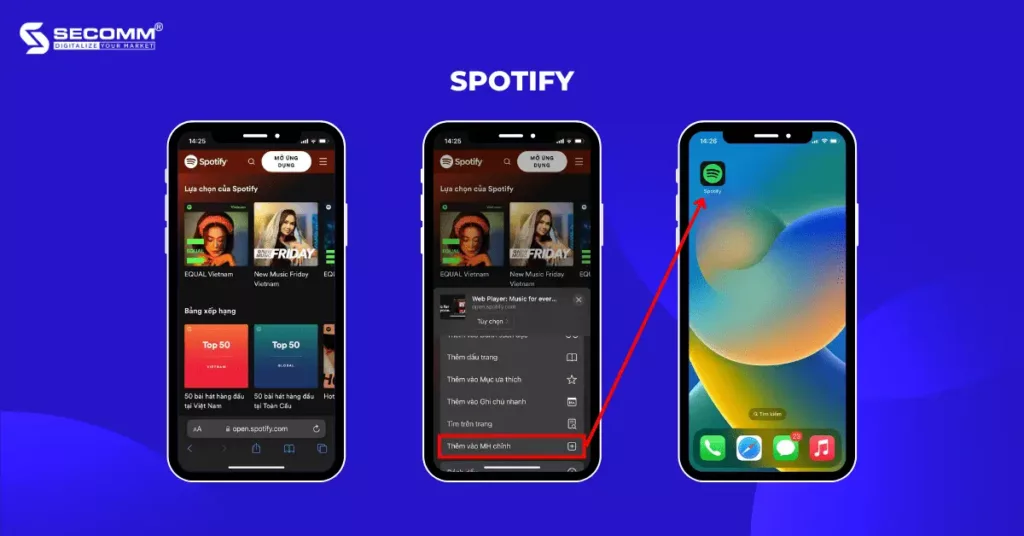
Tinder
Native app of Tinder has been very effective on many different operating systems and is particularly loved by users. However, with the desire to expand and conquer new markets as well as protect its position as a leading online dating platform, Tinder has built a PWA.
The page loading time of Tinder PWA has been reduced to 4.69 seconds compared to 11.9 seconds before, which significantly increases interaction and surpasses Tinder native app in terms of the number of swipes, profile edits, and time spent per user.
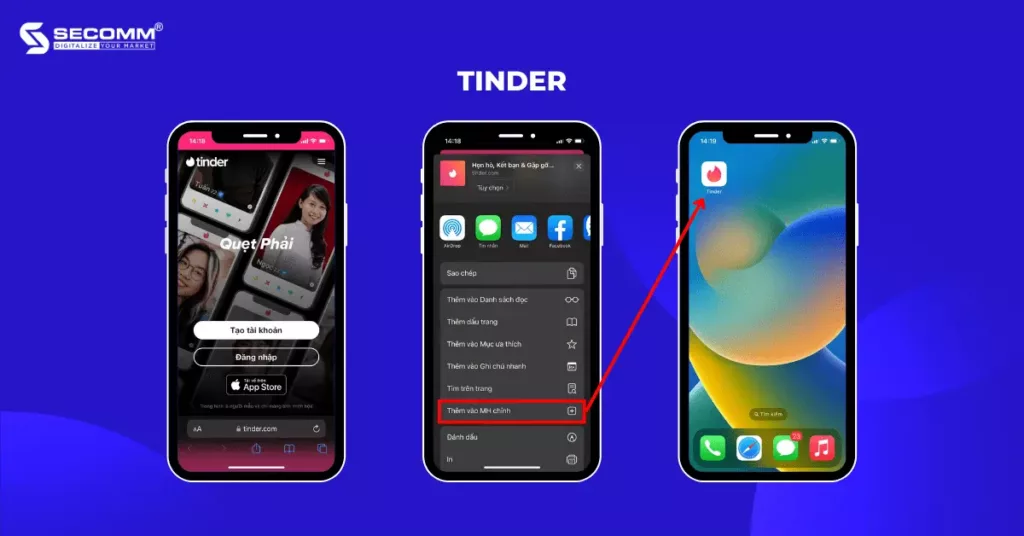
In addition, there are many famous companies in the world that have implemented PWA: Facebook, Instagram, Twitter, TikTok, Uber, Pinterest, Starbucks, Aliexpress, etc.
With years of experience implementing eCommerce solutions for numerous clients in various countries, SECOMM understands the importance of developing PWA to cope with the competition in the billion-dollar technology industry as well as the challenges that each business faces when building and developing PWA.
Contact SECOMM now for a free consultation!
 2
2

 7,343
7,343

 0
0

 1
1



